Page 1

Color 550 Printer
Color 560 Printer
User Guide
Page 2

Microsoft and Windows are trademarks or registered trademarks of Microsoft Corporation in the U.S.
and other countries.
Adobe and Acrobat are trademarks of Adobe Systems Incorporated.
RSA and BSAFE are either registered trademarks or trademarks of RSA Security Inc. in the United
States and/or other countries.
RSA Security Inc. All right reserved.
All product/brand names are trademarks or registered trademarks of the respective holders.
Microsoft product screen shot(s) reprinted with permission from Microsoft Corporation.
For information on license, refer to About License.
In this manual, safety instructions are preceded by the symbol .
Always read and follow the instructions before performing the required procedures.
The data saved in the hard disk of the machine may be lost if there is any problem in the hard disk.
Fuji Xerox is not responsible for any direct and indirect damages arising from or caused by such data
loss.
Fuji Xerox is not responsible for any breakdown of machines due to infection of computer virus or
computer hacking.
Important
1. This manual is copyrighted with all rights reserved. Under the copyright laws, this manual may not
be copied or modified in whole or part, without the written consent of the publisher.
2. Parts of this manual are subject to change without prior notice.
3. We welcome any comments on ambiguities, errors, omissions, or missing pages.
4. Never attempt any procedure on the machine that is not specifically described in this manual.
Unauthorized operation can cause faults or accidents. Fuji Xerox is not liable for any problems
resulting from unauthorized operation of the equipment.
An export of this product is strictly controlled in accordance with Laws concerning Foreign
Exchange and Foreign Trade of Japan and/or the export control regulations of the United States.
XEROX and the sphere of connectivity design are trademarks or registered trademarks of Xerox
Corporation in the U.S. or Fuji Xerox Co., Ltd.
DocuWorks is a trademark of Fuji Xerox Co., Ltd.
Page 3

Table of Contents
Table of Contents ........................................................................................................ 3
1 Before Using the Machine ........................................................................................ 7
Preface ........................................................................................................................ 8
Types of Manuals ........................................................................................................ 9
Using This Guide ....................................................................................................... 10
Organization of This Guide ................................................................................... 10
Conventions .......................................................................................................... 10
Safety Notes .............................................................................................................. 12
Electrical Safety .................................................................................................... 13
Machine Installation .............................................................................................. 14
Operational Safety ................................................................................................ 17
Consumable .......................................................................................................... 20
Location of Warning and Caution Labels.............................................................. 21
Table of Contents
Regulation ................................................................................................................. 24
Radio Frequency Emissions (Class A) ................................................................. 24
Product Safety Certification (CB).......................................................................... 24
Regulatory Information for RFID ........................................................................... 24
Environment .............................................................................................................. 25
About License............................................................................................................ 26
RSA BSAFE.......................................................................................................... 26
Heimdal ................................................................................................................. 26
JPEG Code ........................................................................................................... 26
Libcurl ................................................................................................................... 27
FreeBSD ............................................................................................................... 27
OpenLDAP ............................................................................................................ 28
DES....................................................................................................................... 30
AES....................................................................................................................... 30
TIFF (libtiff)............................................................................................................ 30
ICC Profile (Little cms) .......................................................................................... 30
XPS (XML Paper Specification)............................................................................ 30
EDICT and COMPDIC .......................................................................................... 30
Legal Notice............................................................................................................... 32
2 Product Overview.................................................................................................... 33
Machine Components................................................................................................ 34
Power Source ............................................................................................................ 41
Switching the Main Power On............................................................................... 41
Switching the Power On........................................................................................ 42
Switching the Power Off........................................................................................ 42
Switching the Main Power Off............................................................................... 43
Circuit Breaker ........................................................................................................... 44
3
Page 4

Energy Saver Mode....................................................................................................45
Entering the Energy Saver Mode...........................................................................45
Exiting the Energy Saver Mode .............................................................................46
Control Panel..............................................................................................................47
Services and Options.............................................................................................49
Customizing the Control Panel ..............................................................................50
Entering Text ..............................................................................................................52
3 Copy ..........................................................................................................................53
Copying Procedure.....................................................................................................54
Step 1 Loading Documents ...................................................................................54
Step 2 Selecting Features .....................................................................................56
Step 3 Entering a Quantity.....................................................................................57
Step 4 Starting the Copy Job.................................................................................58
Step 5 Confirming the Copy Job in Job Status ......................................................59
Operations during Copying.........................................................................................60
Stopping the Copy Job ..........................................................................................60
Changing the Number of Copies ...........................................................................61
Interrupting the Copy Job ......................................................................................62
Simple Copy ...............................................................................................................63
Paper Supply (Selecting the Paper for Copying)...................................................63
Reduce/Enlarge (Making Enlarged/Reduced Copies)...........................................64
2 Sided Copying (Making 2 Sided Copies)............................................................65
Black & White/Color (Selecting the Color for Copying)..........................................65
Lighten/Darken (Adjusting the Copy Density) ........................................................66
2 Pages per Side (Copying Two Pages onto One Sheet) .....................................66
1 Staple..................................................................................................................67
Copy ...........................................................................................................................69
Reduce/Enlarge (Making Enlarged/Reduced Copies)...........................................69
Paper Supply (Selecting the Paper for Copying)...................................................73
Output Color (Selecting the Color for Copying) .....................................................76
2 Sided Copying (Making 2 Sided Copies)............................................................80
Copy Output (Specifying Finishing Options)..........................................................80
Pages per Side (Copying Multiple Pages onto One Sheet)...................................81
Lighten/Darken (Adjusting the Copy Density) ........................................................81
Image Quality .............................................................................................................82
Original Type (Selecting the Document Type) .......................................................82
Image Options (Adjusting Copy Density/Sharpness/Saturation of Images) ..........84
Image Enhancement (Erasing the Background Color of Documents/
Adjusting Contrast) ................................................................................................85
Color Effects (Selecting an Image Quality) ............................................................86
Color Balance (Adjusting Color Balance) ..............................................................87
Color Shift (Adjusting the Color Tone) ...................................................................88
Gloss Level (Enhancing Gloss of the Document) ..................................................89
Layout Adjustment......................................................................................................91
4
Page 5

Table of Contents
2 Sided Copying (Making 2 Sided Copies) ........................................................... 92
Book Copying (Copying Facing Pages onto Separate Sheets) ............................ 93
2 Sided Book Copying (Making 2 Sided Copies of Facing Pages)....................... 95
Original Size (Specifying the Scan Size for the Document) .................................. 96
Mixed Size Originals (Scanning Different Size Documents Simultaneously)........ 97
Edge Erase (Erasing Edges and Margin Shadows of the Document) .................. 98
Image Shift (Adjusting the Image Position)......................................................... 100
Invert Image (Making Reversed Copies of Images)............................................ 102
Original Orientation (Specifying the Orientation of Loaded Documents) ............ 103
Image Rotation (Changing the Orientation of Images) ....................................... 104
Output Format ......................................................................................................... 106
2 Sided Copying (Making 2 Sided Copies) ......................................................... 106
Booklet Creation (Creating a Booklet) ................................................................ 107
Covers (Attaching Covers to Copies).................................................................. 110
Pages per Side (Copying Multiple Pages onto One Sheet) ................................ 111
Poster (Making Enlarged Copies Spread over Multiple Sheets)......................... 112
Repeat Image (Making Multiple Copies on One Sheet)...................................... 114
Annotations (Adding a Comment/a Date/Page Numbers to Copies).................. 115
Watermark (Printing Control Numbers on the Background of Copies) ............... 121
Tab Margin Shift (Copying on Tab Stock Paper) ................................................ 124
Face Up/Down Output (Specifying Face Up or Down) ....................................... 125
Folding (Outputting Bi-Folded/Tri-Folded Paper)................................................ 125
Preset Repeat Image (Making Multiple Copies on a Single Sheet).................... 126
Transparency Options (Inserting Blank Sheets between Transparencies)......... 127
Copy Output (Specifying Finishing Options) ....................................................... 129
ID Card Copy (Copying Both Sides of an ID Card)............................................. 135
Job Assembly .......................................................................................................... 137
Build Job (Processing Documents Scanned with Different Settings as
One Job) ............................................................................................................. 137
Sample Job (Checking the Finished Output of the Copy)................................... 141
Combine Original Sets (Adding Originals) .......................................................... 143
Delete Outside/Delete Inside (Deleting Outside or Inside of the Selected
Area) ................................................................................................................... 144
Stored Programming (Calling a Stored Program for Build Job).......................... 146
4 Scan ........................................................................................................................ 147
Scanning Procedure ................................................................................................ 148
Step 1 Loading Documents................................................................................. 148
Step 2 Selecting a Service .................................................................................. 150
Step 3 Starting the Scan Job .............................................................................. 151
Step 4 Confirming the Scan Job in Job Status ................................................... 152
Step 5 Saving the Scanned Data........................................................................ 152
Cancelling a Scan Job............................................................................................. 153
Network Scanning ................................................................................................... 154
Color Scanning (Selecting an Output Color)....................................................... 154
2 Sided Scanning (Scanning Both Sides of a Document)................................... 155
5
Page 6

Original Type (Selecting the Document Type) .....................................................156
File Format (Selecting a File Format for Output Data).........................................157
Advanced Settings ...................................................................................................159
Photographs (Scanning a Color Photograph)......................................................159
Image Options (Adjusting Scan Density and Image Sharpness).........................160
Image Enhancement (Erasing the Background Color of Documents/
Adjusting Contrast) ..............................................................................................160
Shadow Suppression (Suppressing the Document Background)........................161
Color Space (Specifying the Color Space) ..........................................................162
Layout Adjustment....................................................................................................163
Resolution (Specifying a Scanning Resolution) ...................................................163
2 Sided Scanning (Scanning Both Sides of a Document) ...................................163
Book Scanning (Scanning Facing Pages on Separate Sheets) ..........................164
Original Size (Specifying a Scan Size) ................................................................165
Mixed Size Originals (Scanning Different Size Documents Simultaneously) ......166
Edge Erase (Erasing Edges and Margin Shadows in the Document) .................167
Reduce/Enlarge (Specifying a Scanning Ratio)...................................................168
Original Orientation (Specifying the Orientation of the Loaded Documents) .......169
Filing Options ...........................................................................................................170
File Name (Specifying a Name for the File to be Sent) .......................................170
File Name Conflict (Setting the Action to be Taken for File Name Conflict) ........170
Quality/File Size (Specifying an Image Compression Ratio When Scanning).....171
5 Stored Programming..............................................................................................173
Stored Programming Overview ................................................................................174
Registering/Deleting/Renaming Stored Programs ...................................................175
Registering Stored Programs ..............................................................................176
Notes and Restrictions on Registering Stored Programs ....................................177
Registering Stored Programs for Build Job .........................................................177
Deleting Stored Programs ...................................................................................178
Entering/Changing a Stored Program Name .......................................................178
Assigning/Changing Icons for Stored Programs ..................................................179
Calling a Stored Program .........................................................................................180
Calling a Stored Program for Build Job ...............................................................181
6 Job Status ...............................................................................................................183
Job Status Overview ................................................................................................184
Checking Current/Pending Jobs...............................................................................185
Checking Completed Jobs .......................................................................................187
Handling Error Terminations ....................................................................................188
Index...............................................................................................................................189
6
Page 7

1 Before Using the Machine
This chapter describes how to use this guide, as well as safety notes and legal
notice you should read before using the machine.
z
Preface ......................................................................................................... 8
z
Types of Manuals .........................................................................................9
z
Using This Guide ........................................................................................ 10
z
Safety Notes ............................................................................................... 12
z
Regulation................................................................................................... 24
z
Environment................................................................................................25
z
About License .............................................................................................26
z
Legal Notice................................................................................................ 32
Page 8

1 Before Using the Machine
Preface
Before Using the Machine
1
Thank you for selecting the Color 550/560 Printer (hereafter referred to as “the
machine”).
This guide describes how to operate the machine and the precautions you should
follow during operation. To get the most out of the machine and to use it effectively, be
sure to read this guide before use.
The guide assumes that you are familiar with a personal computer and that you are
knowledgeable of computer networks. When you need additional information, refer to
the manuals provided with the personal computer, operating system, and network
products.
For information on how to load paper in the trays and how to solve problems, refer to
the Administrator Guide.
The Print Server is used to utilize the print feature. For capabilities of and how to
operate the Print Server, refer to the manual supplied with your Print Server.
After reading this guide, be sure to keep it handy for quick reference. It will be useful in
case you forget how to perform operations or if a problem occurs with the machine.
8
Page 9

Types of Manuals
Types of Manuals
The following guides are provided with the machine.
Accompanying Manuals
User Guide (this guide)
The guide describes all the necessary steps for copy and scan.
Administrator Guide
The guide is intended for system administrators, and describes how to solve problems
that may occur with the machine. This guide also describes daily maintenance and the
System Settings procedures.
Before Using the Machine
1
9
Page 10

1 Before Using the Machine
Using This Guide
Before Using the Machine
This guide is intended for first time users of the machine. It describes the basic
operations for the Copy and Scan services.
Organization of This Guide
This guide consists of the following chapters:
1 Before Using the Machine
Describes how to use this guide, as well as safety notes, legal notices, and other
important information you should read before using the machine.
1
2 Product Overview
Describes the basic information of the machine, such as the names of components,
how to use the touch screen, how to switch the machine on and off, and how to exit the
Energy Saver mode.
3 Copy
Describes the basic operations and features for the Copy service.
4 Scan
Describes the basic operations and features for the Scan services.
5 Stored Programming
Describes the Stored Programming service that enables you to store customized job
settings.
6 Job Status
Describes how to check job status and how to delete jobs.
Conventions
z
z
z
z
z
The screen shots and illustrations used in this guide vary depending on the machine
configuration and optional components installed. Some of the items in the screen
shots may not be displayed or available depending on your machine configuration.
The procedures in this guide may vary depending on the driver and utility software
being used due to the upgrades.
In this document, "Computer" refers to a personal computer or workstation.
The following terms are used in this guide:
Important : Important information that you should read.
Note : Additional information on operations or features.
The following symbols are used in this guide:
10
" " : • A cross-reference included in this guide.
• Names of CD-ROM, features, and touch screen messages
and input text.
[ ] : • Folders, files, applications, button or menu names displayed
on the touch screen.
Page 11

Using This Guide
LEF Orientation
Paper feed direction
SEF Orientation
Paper feed direction
• Names of menus, commands, windows, or dialog boxes
displayed on the computer screen and their buttons and
menu names.
< > button : Hardware buttons on the control panel.
< > key : Keys on the keyboard of the computer.
> : • Path to a certain item within a procedure on the control panel.
For example: When you see the procedure "select [Tools] >
[Setup] > [Create Folder]", this means that you need to select
[Tools], select [Setup], and then select [Create Folder].
• Path to a certain item within a procedure on a computer.
For example: When you see the procedure "to search for files
and folders, click [Start] > [Search] > [For Files or Folders]",
this means that you need to click [Start], click [Search], and
then click [For Files or Folders] to search for files and folders.
• Cross-reference
For example: "Refer to "5 Tools" > "Common Service
Settings" > "Audio Tones" in the Administrator Guide."
The sentence above means that you need to refer to the
section "Audio Tones", which can be found under "Common
Service Settings" in chapter 5 Tools of the Administrator
Guide.
z
Orientation of documents or paper is described in this guide as follows:
, ,Long Edge Feed (LEF): Loading documents or paper in portrait orientation
when you view the machine from the front.
Before Using the Machine
1
, ,Short Edge Feed (SEF): Loading documents or paper in landscape orientation
when you view the machine from the front.
11
Page 12

1 Before Using the Machine
WARNING
Caution Flammable Explodable Electric
shock
Heated
surface
Moving
object
Pinched
fingers
Prohibited No fire Do not
touch
Do not use
in bathroom
Do not
tear down
Keep away
from wet
Never touch
with wet hand
Instructions Unplug Ground/
Earth
Safety Notes
Before Using the Machine
1
Before using this product, read "Safety Notes" carefully for safety use.
This product and recommended supplies have been tested and found to comply with
strict safety requirements including safety agency approvals and compliance with
environmental standards. Follow the following instructions for safety use.
Any unauthorized alteration including an addition of new functions or connection to
external devices may not be covered by the product warranty. Contact your local Fuji
Xerox representative for more information.
Follow all warning instructions marked on this product. The warning marks stand for the
followings:
Used for item that if not followed strictly, can lead death or severe or
fatal injuries and the possibility to do it is comparatively high.
Used for items that if not followed strictly, can lead to severe or fatal
injuries.
Used for items that if not followed strictly, can cause injuries to user or
damages to machine.
: A symbol for items to pay attention to when handling machine.
Follow instructions carefully to use machine safely.
: A symbol for prohibited items. Follow instructions carefully to avoid
any dangerous acts.
: A symbol for items that must be performed. Follow instructions
carefully to carry out these essential tasks.
12
Page 13

Electrical Safety
This product shall be operated by the power source as indicated on the product's data
plate. Consult your local power company to check if your power source meets the
requirements.
Safety Notes
Before Using the Machine
WARNING: Connect this product to a protective earth circuit.
This product is supplied with a plug that has a protective earth pin. The plug
fits only into an earthed electrical outlet. This is a safety feature. If the plug
doesn't fit to the outlet, contact an electrician to replace the outlet to avoid risk
of electric shock. Never use an earthed adapter plug to connect the product to
the electrical outlet that has no earth connection terminal.
Improper connection of a grounding conductor may cause electric shock.
Plug the power cord directly into a grounded electrical outlet. To prevent
overheat and a fire accident, do not use an extension cord, a multi-plug
adaptor or a multiple connector. Consult your local Fuji Xerox representative
to check if an outlet is grounded.
Connect this product to a branch circuit or an outlet that has larger capacity
than the rated ampere and voltage of this product. See the data plate on the
rear panel of this product for its rated ampere and voltage.
Never touch the power cord with wet hands. It may cause electric shock.
Do not place an object on the power cord.
Always keep the plug connection free of dust. The dusty and damp
environment may bring about minute electric current in a connector. It may
generate heat and eventually cause a fire accident.
To avoid the risk of electric shock and a fire accident, only use the power cord
supplied with this product or the ones designated by Fuji Xerox.
The power cord is exclusive use for this product. Do not use it for any other
product.
Do not damage or alter the power cord. Damage and alteration may generate
heat and eventually cause electric shock or a fire accident.
If the power cord is damaged or insulated wires are exposed, contact your local
Fuji Xerox representative for its replacement. Do not use a damaged or
uninsulated cord to avoid the risk of electric shock and a fire accident.
1
When cleaning this product, always switch off and unplug it. Access to a live
machine interior may cause electric shock.
Do not unplug or re-plug this product with the switch on. Plugging and
unplugging a live connector may deform the plug and generate heat, and
eventually cause a fire accident.
Hold the plug not the cord when unplugging this product, or it may damage the
cord and cause electric shock or a fire accident.
Always switch off and unplug the machine when it is not used over weekends
or long holidays. It may cause deterioration of insulations and eventually
electric shock or a fire accident.
13
Page 14

1 Before Using the Machine
Before Using the Machine
Machine Installation
1
Once a month, switch off this product and check if
z
the power cord is plugged firmly into an electrical outlet;
z
the plug is not excessively heated, rusted or bent;
z
the plug and electrical outlet are free of dust; and
z
the power cord is not cracked or worn down.
Once you notice any unusual condition, switch off and unplug this product first
and contact your local Fuji Xerox representative.
Do not locate this product where people might step on or trip over the power
cord. Friction or excessive pressure may generate heat and eventually cause
electric shock or a fire accident.
Never locate this product in the following places:
z
Near radiators or any other heat sources
z
Near volatile flammable materials such as curtains
z
In the hot, humid, dusty or poorly ventilated environment
z
In the place receiving direct sunlight
z
Near cookers or humidifiers
Locate this product on a level and sturdy surface that can withstand a weight
of 750 Kg. Otherwise, if tilted, the product may fall over and cause injuries.
Locate this product in a well-ventilated area. Do not obstruct ventilation
openings of the product.
Keep the minimum clearance as follows for ventilation and an access to the
power plug. Unplug the product if an abnormal condition is noted.
14
Page 15

Safety Notes
20
804
569
323
80
20
1716
1674
1574
549
Main unit
(Unit: mm)
20
804
569
323
80
20
1716
2192
2092
549
With Finisher C2 with Booklet Maker (optional)
(Unit: mm)
20
804
569
323
80
1716
2145
2045
20
With High Capacity Feeder C1-DS (optional)
(Unit: mm)
Before Using the Machine
1
15
Page 16

1 Before Using the Machine
20
804
569
323
80
20
1716
3346
3246
With Finisher D4 with Booklet Maker (optional),
D4 Folder Unit, and High Capacity Feeder C1-DS
(Unit: mm)
Before Using the Machine
1
1716
With Finisher D4 with Booklet Maker (optional)
20
804
569
323
20
2575
2675
80
(Unit: mm)
Do not incline the product at more than 10 degree angle. Otherwise, it may fall
over and cause injuries.
Front
10
°
Front
Back
Back
10
Left
Right
°
°
10
Left
Right
10
°
16
Page 17

Safety Notes
Always lock the wheels of this product after installation. Otherwise, it may fall
over or slide and cause injuries.
Before Using the Machine
To keep this product in a good performance and condition, always use it in the
following environment:
z
Temperature: 10 - 32°C
z
Humidity: 15 - 85%
When the product is left in a chilly room and the room is rapidly warmed up by
heater, dew condensation may form inside the product and cause a partial
deletion on printing.
Operational Safety
The operator's product maintenance procedures are described in the customer
documentation supplied with this product. Do not carry out any other
maintenance procedures not described in the documentation.
This product features safety design not to allow operators access to hazard
areas. The hazard areas are isolated from operators by covers or protectors
which require a tool to remove. To prevent electric shock and injuries, never
remove those covers and protectors.
To avoid the risk of electric shock and a fire accident, switch off and unplug the
product promptly in the following conditions, then contact your local Fuji Xerox
representative.
z
z
z
z
z
z
z
1
The product emits smoke or its surface is unusually hot.
The product emits unusual noise or odor.
The power cord is cracked or worn down.
A circuit breaker, fuse or any other safety device is activated.
Any liquid is spilled into the product.
The product is soaked in water.
Any part of the product is damaged.
Do not insert any object into slots or openings of this product.
Do not place any of the followings on the product:
z
Liquid container such as flower vases or coffee cups
z
Metal parts such as staples or clips
z
Heavy objects
If liquid is spilled over or metal parts are slipped into the product, it may cause
electric shock or a fire accident.
17
Page 18

1 Before Using the Machine
Do not use conductive paper such as origami paper, carbonic paper or
conductively-coated paper. When paper jam occurs, it may cause short-circuit
and eventually a fire accident.
Before Using the Machine
1
When cleaning this product, use the designated cleaning materials exclusive
to it. Other cleaning materials may result in poor performance of the product.
Never use aerosol cleaners, or it may catch fire and cause explosion.
If you need to pull out a tray to remove paper jam, contact your local Fuji Xerox
representative. Do not pull out a tray, otherwise it may cause injuries.
Never play the CD-ROM supplied with the product on an audio player. Always
use a CD-ROM player. Otherwise, large sound may damage audio players or
your ears.
Laser Safety
CAUTION: Any operations or adjustments not stated in the operation manual
may cause hazardous light exposure and eventually burn injuries or loss of
eyesight.
This product has been tested and found to comply with the Class 1 Laser
Equipment requirements defined by the international standard IEC60825 and
has no light exposure hazard. The product has no hazardous light emission as
it features light protection components and covers to shut in all light beam
during operation and maintenance.
Keep electrical and mechanical safety interlocks active. Keep the safety
interlocks away from magnetic materials. Magnetic materials may accidentally
activate the product and cause injuries or electric shock.
A ground fault interrupter is embedded in this product. If current leakage
occurs, the ground fault interrupter automatically cuts off power circuit to
prevent electric shock and a fire accident. The ground fault interrupter is
normally ON (indicated as "|"). Check once a month if the ground fault
interrupter works properly in accordance with the following procedures:
(1) Press the TEST button to turn off the ground fault interrupter.
(2) Check the indication ("O"). It means that the ground fault interrupter circuit
works properly.
(3) Return the ground fault interrupter switch to ON ("|").
18
Page 19

Breaker switch
Test button
Breaker switch
Color 550/560 Printer main unit A4 High Capacity Feeder
TEST button
Breaker switch
TEST button
Breaker switch
TEST button
Interface module
Breaker switch
TEST button
High Capacity Feeder C1-DS
Breaker switch
TEST button
Finisher D4, Finisher D4 with Booklet Maker
Safety Notes
ブレーカースイッチ
テストボタン
Before Using the Machine
1
If the circuit does not work properly, contact your local Fuji Xerox
representative.
Do not attempt to remove a paper jammed deeply inside the product,
particularly a paper wrapped around a Fusing Unit or a heat roller. Otherwise,
it may cause injuries or burns. Switch off the product promptly and contact your
local Fuji Xerox representative.
Never touch the paper output area of the finisher during operation. It may
cause injuries.
Be careful in removing jammed staples.
Be careful not to get injured by waste staples when detaching a staple dust
box.
Waste staples may come out with output paper. Be careful not to get injured
by the staples.
19
Page 20

1 Before Using the Machine
Before Using the Machine
Never touch safety interlocks. When a front cover is open, safety interlocks
become activated to stop the machinery. Do not apply pressure on safety
interlocks with a coin or screwdriver. Otherwise, the machinery may become
activated and cause injuries.
Do not staple punched holes of paper. Sharp points of a staple may cause
injuries.
Do not apply excessive force to hold thick document on the document glass. It
may break the glass and cause injuries.
To move this product to another location, contact your local Fuji Xerox
representative
Ventilate well during extended operation or mass copying. It may affect the
office air environment due to odor such as ozone in a poorly ventilated room.
1
Consumable
Provide proper ventilation to ensure the comfortable and safe environment.
Store all consumables in accordance with the instructions given on its package
or container.
Use a broom or a wet cloth to wipe off spilled toner. Never use a vacuum
cleaner for the spills. It may catch fire by electric sparks inside the vacuum
cleaner and cause explosion. If you spill a large volume of toner, contact your
local Fuji Xerox representative.
Never throw a toner cartridge into an open flame. Remaining toner in the
cartridge may catch fire and cause burn injuries or explosion.
If you have a used toner cartridge no longer needed, contact your local Fuji
Xerox representative for its disposal.
Never throw a waste toner bottle into an open flame. Toner may catch fire and
cause burn injuries or explosion.
20
If you have a used waste toner bottle no longer needed, contact your local Fuji
Xerox representative for its disposal.
Keep the drum cartridges (or drum if not a cartridge type) and toner cartridges
out of the reach of children. If a child accidentally swallows toner, spit it out,
rinse mouth with water, drink water and consult a physician immediately.
When replacing drum cartridges (or drum if not a cartridge type) and toner
cartridges, be careful not to spill the toner. In case of any toner spills, avoid
contact with clothes, skin, eyes and mouth as well as inhalation.
If toner spills onto your skin or clothing, wash it off with soap and water.
If you get toner particles in your eyes, wash it out with plenty of water for at
least 15 minutes until irritation is gone. Consult a physician if necessary.
If you inhale toner particles, move to a fresh air location and rinse your mouth
with water.
If you swallow toner, spit it out, rinse your mouth with water, drink plenty of
water and consult a physician immediately.
Page 21

Location of Warning and Caution Labels
Always follow all warning instructions marked on or supplied with this product.
To avoid the risk of burn injuries and electric shock, never touch the area with
the "High Temperature" or "High Voltage" marks on.
Safety Notes
Before Using the Machine
1
21
Page 22

Before Using the Machine
1
1 Before Using the Machine
22
Page 23

Safety Notes
Before Using the Machine
1
23
Page 24

1 Before Using the Machine
Regulation
Before Using the Machine
Radio Frequency Emissions (Class A)
This product has been tested and found to comply with the limits for a class A digital
device, pursuant to the International Standard for Electromagnetic Interference (CISPR
Publ. 22) and Radiocommunication Act 1992 in Australia/New Zealand. These limits
are designed to provide reasonable protection against harmful interference when the
product is operated in a commercial environment. This product generates, uses and
can radiate radio frequency energy and, if not installed and used in accordance with
the customer documentation, may cause harmful interference to radio
communications. Operation of this product in a residential area is likely to cause
harmful interference in which case the user is required to correct the interference at
their own expense.
1
Changes and modifications to this product not specifically approved by Fuji Xerox may
void the user's authority to operate this equipment.
Product Safety Certification (CB)
This product is certified by the following agency using the safety standards listed.
Agency
NEMKO IEC60950-1:ed. 2
Standard
Regulatory Information for RFID
This product contains Radio Frequency Identification system device (RFID) and it is
certified in compliance with applicable local laws and/or regulations.
24
Page 25

Environment
z
For environmental protection and efficient use of resources, Fuji Xerox reuses
returned toner cartridges and drum cartridges to make recycle parts, recycle
materials or energy recovery.
z
Proper disposal is required for toner cartridges and drum cartridges no longer
needed. Do not open toner cartridges and drum cartridges. Return them to your local
Fuji Xerox representative.
Environment
Before Using the Machine
1
25
Page 26

1 Before Using the Machine
About License
Before Using the Machine
RSA BSAFE
1
Heimdal
This section describes information about licenses. Be sure to read through it.
This product includes RSA BSAFE® Cryptographic software from RSA Security Inc.
Copyright (c)2000 Kungliga Tekniska Högskolan (Royal Institute of Technology,
Stockholm, Sweden). All rights reserved.
Redistribution and use in source and binary forms, with or without modification, are
permitted provided that the following conditions are met:
1. Redistributions of source code must retain the above copyright notice, this list of
conditions and the following disclaimer.
JPEG Code
2. Redistributions in binary form must reproduce the above copyright notice, this list of
conditions and the following disclaimer in the documentation and/or other materials
provided with the distribution.
3. Neither the name of the Institute nor the names of its contributors may be used to
endorse or promote products derived from this software without specific prior written
permission.
THIS SOFTWARE IS PROVIDED BY THE INSTITUTE AND CONTRIBUTORS ''AS
IS'' AND ANY EXPRESS OR IMPLIED WARRANTIES, INCLUDING, BUT NOT
LIMITED TO, THE IMPLIED WARRANTIES OF MERCHANTABILITY AND FITNESS
FOR A PARTICULAR PURPOSE ARE DISCLAIMED. IN NO EVENT SHALL THE
INSTITUTE OR CONTRIBUTORS BE LIABLE FOR ANY DIRECT, INDIRECT,
INCIDENTAL, SPECIAL, EXEMPLARY, OR CONSEQUENTIAL DAMAGES
(INCLUDING, BUT NOT LIMITED TO, PROCUREMENT OF SUBSTITUTE GOODS
OR SERVICES; LOSS OF USE, DATA, OR PROFITS; OR BUSINESS
INTERRUPTION) HOWEVER CAUSED AND ON ANY THEORY OF LIABILITY,
WHETHER IN CONTRACT, STRICT LIABILITY, OR TORT (INCLUDING
NEGLIGENCE OR OTHERWISE) ARISING IN ANY WAY OUT OF THE USE OF THIS
SOFTWARE, EVEN IF ADVISED OF THE POSSIBILITY OF SUCH DAMAGE.
26
Our printer software uses some of the codes defined by the Independent JPEG Group.
Page 27

Libcurl
About License
COPYRIGHT AND PERMISSION NOTICE
Copyright (c) 1996 - 2006, Daniel Stenberg, <daniel@haxx.se>.
All rights reserved.
Permission to use, copy, modify, and distribute this software for any purpose with or
without fee is hereby granted, provided that the above copyright notice and this
permission notice appear in all copies.
THE SOFTWARE IS PROVIDED "AS IS", WITHOUT WARRANTY OF ANY KIND,
EXPRESS OR IMPLIED, INCLUDING BUT NOT LIMITED TO THE WARRANTIES OF
MERCHANTABILITY, FITNESS FOR A PARTICULAR PURPOSE AND
NONINFRINGEMENT OF THIRD PARTY RIGHTS. IN NO EVENT SHALL THE
AUTHORS OR COPYRIGHT HOLDERS BE LIABLE FOR ANY CLAIM, DAMAGES
OR OTHER LIABILITY, WHETHER IN AN ACTION OF CONTRACT, TORT OR
OTHERWISE, ARISING FROM, OUT OF OR IN CONNECTION WITH THE
SOFTWARE OR THE USE OR OTHER DEALINGS IN THE SOFTWARE.
Except as contained in this notice, the name of a copyright holder shall not be used in
advertising or otherwise to promote the sale, use or other dealings in this Software
without prior written authorization of the copyright holder.
Before Using the Machine
1
FreeBSD
This product contains the part of FreeBSD codes.
The FreeBSD Copyright
Copyright 1994-2006 The FreeBSD Project. All rights reserved.
Redistribution and use in source and binary forms, with or without modification, are permitted
provided that the following conditions are met:
Redistributions of source code must retain the above copyright notice, this list of conditions
and the following disclaimer.
Redistributions in binary form must reproduce the above copyright notice, this list of
conditions and the following disclaimer in the documentation and/or other materials provided
with the distribution.
27
Page 28

1 Before Using the Machine
Before Using the Machine
1
OpenLDAP
THIS SOFTWARE IS PROVIDED BY THE FREEBSD PROJECT ''AS IS'' AND ANY
EXPRESS OR IMPLIED WARRANTIES, INCLUDING, BUT NOT LIMITED TO, THE
IMPLIED WARRANTIES OF MERCHANTABILITY AND FITNESS FOR A PARTICULAR
PURPOSE ARE DISCLAIMED. IN NO EVENT SHALL THE FREEBSD PROJECT OR
CONTRIBUTORS BE LIABLE FOR ANY DIRECT, INDIRECT, INCIDENTAL, SPECIAL,
EXEMPLARY, OR CONSEQUENTIAL DAMAGES (INCLUDING, BUT NOT LIMITED TO,
PROCUREMENT OF SUBSTITUTE GOODS OR SERVICES; LOSS OF USE, DATA, OR
PROFITS; OR BUSINESS INTERRUPTION) HOWEVER CAUSED AND ON ANY
THEORY OF LIABILITY, WHETHER IN CONTRACT, STRICT LIABILITY, OR TORT
(INCLUDING NEGLIGENCE OR OTHERWISE) ARISING IN ANY WAY OUT OF THE USE
OF THIS SOFTWARE, EVEN IF ADVISED OF THE POSSIBILITY OF SUCH DAMAGE.
The views and conclusions contained in the software and documentation are those of the
authors and should not be interpreted as representing official policies, either expressed or
implied, of the FreeBSD Project.
Copyright 1998-2006 The OpenLDAP Foundation All rights reserved.
Redistribution and use in source and binary forms, with or without modification, are
permitted only as authorized by the OpenLDAP Public License.
A copy of this license is available in the file LICENSE in the top-level directory of the
distribution or, alternatively, at <http://www.OpenLDAP.org/license.html>.
OpenLDAP is a registered trademark of the OpenLDAP Foundation.
Individual files and/or contributed packages may be copyright by other parties and/or
subject to additional restrictions.
This work is derived from the University of Michigan LDAP v3.3 distribution. Information concerning this software is available at <http://www.umich.edu/~dirsvcs/ldap/ldap.html>.
This work also contains materials derived from public sources.
Additional information about OpenLDAP can be obtained at <http://www.openldap.org/>.
---
28
Portions Copyright 1998-2006 Kurt D. Zeilenga.
Portions Copyright 1998-2006 Net Boolean Incorporated.
Portions Copyright 2001-2006 IBM Corporation.
All rights reserved.
Redistribution and use in source and binary forms, with or without modification, are
permitted only as authorized by the OpenLDAP Public License.
---
Page 29

Portions Copyright 1999-2005 Howard Y.H. Chu.
Portions Copyright 1999-2005 Symas Corporation.
About License
Portions Copyright 1998-2003 Hallvard B. Furuseth.
All rights reserved.
Redistribution and use in source and binary forms, with or without modification, are
permitted provided that this notice is preserved.
The names of the copyright holders may not be used to endorse or promote products
derived from this software without their specific prior written permission. This software
is provided ''as is'' without express or implied warranty.
---
Portions Copyright (c) 1992-1996 Regents of the University of Michigan.
All rights reserved.
Redistribution and use in source and binary forms are permitted provided that this
notice is preserved and that due credit is given to the University of Michigan at Ann
Arbor. The name of the University may not be used to endorse or promote products
derived from this software without specific prior written permission. This software is
provided ''as is'' without express or implied warranty.
------------------------------------------
The OpenLDAP Public License
Version 2.8, 17 August 2003
Before Using the Machine
1
Redistribution and use of this software and associated documentation ("Software"),
with or without modification, are permitted provided that the following conditions are
met:
1. Redistributions in source form must retain copyright statements and notices,
2. Redistributions in binary form must reproduce applicable copyright statements and
notices, this list of conditions, and the following disclaimer in the documentation
and/or other materials provided with the distribution, and
3. Redistributions must contain a verbatim copy of this document.
The OpenLDAP Foundation may revise this license from time to time.
Each revision is distinguished by a version number. You may use this Software under
terms of this license revision or under the terms of any subsequent revision of the
license.
THIS SOFTWARE IS PROVIDED BY THE OPENLDAP FOUNDATION AND ITS
CONTRIBUTORS ''AS IS'' AND ANY EXPRESSED OR IMPLIED WARRANTIES,
INCLUDING, BUT NOT LIMITED TO, THE IMPLIED WARRANTIES OF MERCHANTABILITY AND FITNESS FOR A PARTICULAR PURPOSE ARE DISCLAIMED. IN NO
EVENT SHALL THE OPENLDAP FOUNDATION, ITS CONTRIBUTORS, OR THE
AUTHOR(S) OR OWNER(S) OF THE SOFTWARE BE LIABLE FOR ANY DIRECT,
INDIRECT, INCIDENTAL, SPECIAL, EXEMPLARY, OR CONSEQUENTIAL DAMAGES (INCLUDING, BUT NOT LIMITED TO, PROCUREMENT OF SUBSTITUTE
GOODS OR SERVICES; LOSS OF USE, DATA, OR PROFITS; OR BUSINESS
INTERRUPTION) HOWEVER CAUSED AND ON ANY THEORY OF LIABILITY,
29
Page 30

1 Before Using the Machine
WHETHER IN CONTRACT, STRICT LIABILITY, OR TORT (INCLUDING NEGLIGENCE OR OTHERWISE) ARISING IN ANY WAY OUT OF THE USE OF THIS
SOFTWARE, EVEN IF ADVISED OF THE POSSIBILITY OF SUCH DAMAGE.
Before Using the Machine
1
The names of the authors and copyright holders must not be used in advertising or
otherwise to promote the sale, use or other dealing in this Software without specific,
written prior permission. Title to copyright in this Software shall at all times remain with
copyright holders.
OpenLDAP is a registered trademark of the OpenLDAP Foundation.
Copyright 1999-2003 The OpenLDAP Foundation, Redwood City, California, USA. All
Rights Reserved. Permission to copy and distribute verbatim copies of this document
is granted.
DES
This product includes software developed by Eric Young(eay@mincom.oz.au)
AES
Copyright (c) 2003. Dr Brian Gladman. Worcester. UK. All rights reserved.
This product uses published AES software provided by Dr Brian Gladman under BSD
licensing terms.
TIFF (libtiff)
Lib TIFF copyright (c) 1988-1997 Sam leffler
Copyright (c) 1991-1997 Silicon Graphics. Inc.
ICC Profile (Little cms)
Little cms copyright (c) 1988-2004 Marti Maria
XPS (XML Paper Specification)
This product may incorporate intellectual property owned by Microsoft Corporation.
The terms and conditions upon which Microsoft is licensing such intellectual property
may be found at http://go.microsoft.com/fwlink/?LinkId=52369.
EDICT and COMPDIC
The Japanese-English dictionaries (EDICT and COMPDIC) edited by The Electronic
Dictionary Research and Development Group under the coordination of Professor
James William Breen at Monash University are used in the searchable PDF kit option
of Fuji Xerox.
30
Page 31

About License
These Japanese-English dictionary files are licensed to customers under the terms and
conditions of a Creative Commons Attribution-ShareAlike License. Prior to use, be sure
to check the terms and conditions of this license at the URL below. Use of these
Japanese-English dictionaries is not permitted unless you agree to the terms and
conditions of this license.
Furthermore, care should be taken because at the point in time that you begin to use
these Japanese-English dictionaries as specified in the said license, you accept and
agree to be bound by the terms and conditions of this license.
The Japanese-English dictionaries are provided to customers on an as-is basis, and
Fuji Xerox and the original supplier make no representations of warranties of any kind.
z
Original Author Information (extracted from http://www.csse.monash.edu.au/~jwb/
edrdg/licence.html)
Copyright over the documents covered by this statement is held by James William
BREEN and The Electronic Dictionary Research and Development Group at Monash
University.
Before Using the Machine
1
z
Monash University License Information
http://www.csse.monash.edu.au/~jwb/edrdg/licence.html
z
Information Regarding EDICT and COMPDIC
http://www.csse.monash.edu.au/~jwb/edict.html
http://www.csse.monash.edu.au/~jwb/compdic_doc.html
z
Information Regarding the Creative Commons Attribution-ShareAlike License
http://creativecommons.org/licenses/by-sa/2.5/legalcode
31
Page 32

1 Before Using the Machine
Legal Notice
Before Using the Machine
1
Copying or printing certain documents may be illegal in your country. Penalties of fines
or imprisonment may be imposed on those found guilty. The following are examples of
items that may be illegal to copy or print in your country.
z
Currency
z
Banknotes and checks
z
Bank and government bonds and securities
z
Passports and identification cards
z
Copyright material or trademarks without the consent of the owner
z
Postage stamps and other negotiable instruments
This list is not inclusive and no liability is assumed for either its completeness or
accuracy. In case of doubt, contact your legal counsel.
32
Page 33

2 Product Overview
This chapter describes the basic information of the machine, such as machine
components, how to switch the machine on and off, and how to use the touch
screen.
z
Machine Components.................................................................................34
z
Power Source ............................................................................................. 41
z
Circuit Breaker ............................................................................................ 44
z
Energy Saver Mode .................................................................................... 45
z
Control Panel .............................................................................................. 47
z
Entering Text ..............................................................................................52
Page 34

2 Product Overview
14
15
1
3
4
5
6
7
8
9
10
11
12
2
13
Machine Components
This section describes the main components and functions of the machine.
Color 550/560 Printer main unit with optional A4 High Capacity Feeder
Product Overview
2
No. Component Function
1 Document cover Holds a document in place.
2 Document glass Load a document here.
3 Power switch Switches the power of the machine on and off.
4 Toner cover Open this cover to replace toner cartridges.
5 Front cover Open this cover to replace the consumables.
6 Tray 1, 2, 3, 4 Load paper here.
7 Bottom left cover Open this cover to access the insides of the machine to clear paper
8 Locking casters Used for locking the wheels of the machine. Lock these casters after
9 A4 High Capacity Feeder
(Tray 6) (optional)
Refer to "Power Source" (P.41).
jams.
If the optional A4 High Capacity Feeder (Tray 6) is attached to the
machine, move Tray 6 to the left first.
moving the machine to its installation site.
Load paper here.
34
Page 35

Machine Components
No. Component Function
10 Tray 6 top cover When accessing the bottom left cover of the machine to remove
jammed paper, first move Tray 6 to the left, and then open this top
cover.
11 Tray 5 (Bypass) Used for loading non-standard paper, such as thick-stock paper and
other special media, that cannot be loaded in Trays 1 to 4, and 6.
12 Tray 5 (Bypass) top cover Open the top cover to clear paper jams.
13 Control panel Consists of operation buttons, LED indicators, and a touch screen.
For details, refer to "Control Panel" (P.47).
14 Stylus pen Used for touching the touch screen on the control panel to configure
settings.
Note • You can directly touch the touch screen not only with the stylus pen
but also with a finger.
15 Stylus pen holder Stores the stylus pen.
Product Overview
2
35
Page 36

Product Overview
1
2
5
3
6
7
8
9
11
10
4
2
2 Product Overview
Inside and right side view of the machine
No. Component Function
1 Output Tray Receives output paper.
Two types of trays are available: the Simple Catch Tray and an optional
Offset Catch Tray.
When the optional offset stacking tray is attached and A4 or smaller size
paper is to be output, do not use the extension flap.
2 Circuit breaker This breaker automatically turns the machine off when a current leakage
is detected.
3 Bottom right cover Open this cover to clear paper jams.
When a finisher is attached, first open the front cover of the finisher, and
then open this bottom right cover.
4 Main power switch Switches the main power of the machine on and off. Always follow the
instructions by the system administrator.
Important • Always switch the power off before switching the main power off.
Refer to "Power Source" (P.41).
5 Waste toner bottle cover Open this cover when replacing the waste toner bottle.
6 Waste toner bottle Collects waste toner.
7 Fusing unit Fuses toner on paper.
Important • Do not inadvertently touch this unit as it can get extremely hot.
8 Lever Use this lever when pulling out the Transfer Module.
9 Transfer Module Transfers an image on the drum to the paper. Open this when removing
jammed paper.
10 Drum cartridges Contains photoconductors and development units.
Drum cartridges are arranged in order R1 (Black), R2 (Cyan), R3
(Magenta), R4 (Yellow) from the left as you face the machine.
11 Toner cartridges Contains Black (K), Cyan (C), Magenta (M), and Yellow (Y) toner (image
forming powder).
36
Page 37

Duplex automatic document feeder
9
10
Machine Components
12 3 5 6
4
7
8
Product Overview
2
No. Component Function
1 <Confirmation> indicator This indicator lights to confirm that the document is loaded correctly.
2 Left cover The left cover slightly opens when the top cover is opened. Open this
cover widely to clear paper jams.
3 Top cover Open this cover to access the insides of the machine to clear paper
jams.
4 Inner cover Open this cover to clear paper jams.
5 Document guides Use these guides to align the edges of documents.
6 Document feeder tray Load documents here.
7 Document stopper Used when copying or printing large size documents, such as A3-sized
documents. Open the stopper rightward when using it.
8 Document output tray Receives documents.
9 Narrow glass strip Scans the back side of a loaded document.
10 Document glass Scans a loaded document.
Note • In this guide, the duplex automatic document feeder (optional) is referred to as the
“document feeder” or “DADF”.
37
Page 38

Product Overview
1
2
3
4
5
6
7
8
9
2
2 Product Overview
Finisher C2 (optional) and Finisher C2 with Booklet Maker (optional)
No. Component Function
1 Hole punch waste
container
2 Output tray Outputs are delivered here.
3 Exit cover Open this cover when clearing paper jams.
4 Finisher tray Outputs are delivered here.
5 Staple cartridge Contains staples. Remove this cartridge when replacing or adding
6 Booklet tray
(Finisher C2 with Booklet
Maker only)
7 Front cover Open this cover when clearing paper jams, replacing or adding staples,
8 Booklet unit
(Finisher C2 with Booklet
Maker only)
9 Booklet staple cartridges There are two staple cartridges installed for Booklet Creation (gutter).
Note • The Finisher C2 and the Finisher C2 with Booklet Maker are optional. In this guide, the
Finisher C2 and the Finisher C2 with Booklet Maker are referred to as the "finisher".
Collects scraps from the puncher. Pull out this container when
discarding punch scraps.
staples, or clearing staple jams.
Documents are delivered here when folding is selected for the Booklet
Creation feature.
clearing staple jams, or discarding punch scraps.
Folds documents in half and staples the folded documents.
Take the cartridges out when clearing staple jams, or when replacing
them with new ones.
38
Page 39

Finisher D4, Finisher D4 with Booklet Maker (optional)
1
Machine Components
16
15
14
13
12
11
10
2
3
4
Product Overview
5
7
9
6
8
2
No. Component Function
1 Tray 8 (Interposer) Load paper or transparencies to be used for covers or separators. The
machine does not copy on paper or transparencies loaded in this tray.
2 De-curl button Eliminates curl of paper.
3 Output tray Delivers regular copies. Also delivers copies or prints when [Collated] or
[Uncollated] is selected.
4 Finisher tray Stapled or punched paper is delivered to this tray.
5 Booklet output tray
6 Circuit breaker This breaker automatically turns the machine off when a current leakage
7 Booklet output tray button
8 Right cover Open this cover to clear paper or staple jams, replace staples, or empty
9 Staple cartridges for
booklet
10 Staple waste container Collects waste from the stapler. Remove this cartridge to replace the
*1
*1
Single-folded or single-folded and stapled paper is delivered to this tray.
is detected.
*1
Press this button to move booklets that have been delivered to a
position where they can be removed.
punch waste.
There are two staple cartridges installed for Booklet Creation (gutter).
Take the cartridges out when clearing staple jams, or when replacing
them with new ones.
staple waste container.
39
Page 40

2 Product Overview
5
4
1
3
2
No. Component Function
11 Staple cartridge Contains staples. Remove this cartridge when you need to add staples
or clear staple jams.
Product Overview
2
12 Hole punch waste
container
13 Tri-Fold output tray
14 Tri-Fold output tray button
15 Left cover Open this cover to access the interior of the machine to clear paper
16
Interface module front cover
*2
Collects waste from the puncher. Remove this when emptying the
container.
Delivers tri-folded (C fold and Z fold) copies.
*2
Press this button to open the Tri-Fold output tray.
jams.
Open this cover to clear paper jams.
*1 Only available when the Finisher D4 with Booklet Maker is installed.
*2 Only available when the Folding Unit (Z and C) is installed.
Note • The Finisher D4 with Booklet Maker is optional. In this guide, the Finisher D4 with Booklet
Maker is referred to as the "finisher".
High Capacity Feeder C1-DS (optional)
No. Component Function
1 Circuit breaker This breaker automatically turns the machine off when a current leakage
2 Tray 5 (bypass) Use this when copying or printing on paper that cannot be loaded in
3 Tray 5 (bypass) top cover Open this cover to clear paper jams.
4 Feeder module front cover Delivers paper fed through the High Capacity Tray or Tray 5 (bypass) to
5 High Capacity Feeder
C1-DS (Trays 6 and 7)
(optional)
is detected.
Trays 1 - 3, such as heavyweight paper or other special media.
the main unit. Open this unit when clearing paper jams.
Load paper here.
40
Page 41

Power Source
Power switch
Main power
switch
The machine is provided with the power switch and the main power switch.
Power switch
To use the machine, press the power switch
to the [ | ] position to switch its power on. You
can start operations after the machine warms
up.
Main power switch
Press the main power switch to the [ ]
position. The <Main Power> indicator goes
out on the right side of the control panel, and
the machine powers off. Do not switch the
main power off except when you connect a cable to the machine or clean the machine.
Switching the Main Power On
Power Source
Power Switch
Main Power
Switch
Product Overview
2
The following describes how to switch the main power on.
Important • Do not switch off the main power immediately after switching on the main power. This may
damage the hard disk and the memory or cause a machine malfunction.
1 Make sure that the power cord is plugged in correctly.
2 Open the front cover.
3 Press the main power switch to the [ | ]
position to switch the main power on.
The <Main Power> indicator lights up on the
control panel.
4 Close the front cover.
41
Page 42

2 Product Overview
Breaker switch
Test button
Breaker switch
TEST button
Switching the Power On
The following describes how to switch the power on.
The machine takes approximately 90 seconds to warm up and to be ready to copy or
print after switching the power on. This may take more time depending on your machine
configuration.
Switch the power off at the end of the day or when not using the machine for an
extended period of time.
Product Overview
Also use the Energy Saver feature to save power consumption while the machine is not
in use.
For information on the Energy Saver feature, refer to "Energy Saver Mode" (P.45).
1 Press the power switch to the [ | ] position to
switch the power on.
2
Note • The “Please wait...” message indicates
that the machine is warming up. The
machine is not available during warming
up.
• If the machine is not powered on, check
the following:
•The power cord is plugged in.
•The main power is switched on.
•The <RESET> button is in the depressed
position.
Switching the Power Off
The following describes how to switch the power off.
1 Before switching the power off, make sure that the machine has completed all copy
jobs. Then, make sure that the <Data> indicator is not lit.
Important • Do not switch the power off in the following situations. If the power is switched off, the
processing data may be erased.
• While data is being received
• While a job is being printed
• While a job is being copied
• While a job is being scanned
• When switching the power off, wait 5 seconds after outputs have been delivered.
42
Page 43

2 Press the power switch to the [ ] position.
Important • Power off processing is performed
internally on the machine for a while after
the power is switched off. Do not switch
the main power off immediately after
switching the power off.
Note • When powering the machine on after it
has been switched off, wait 15 seconds
after the touch screen has gone dark.
Switching the Main Power Off
The following describes how to switch the main power off.
Important • Do not switch the main power off while the touch screen displays a screen or the <Energy
Saver> button blinks. Switching off the main power may damage the hard disk and the
memory or cause a machine malfunction.
• Switch the main power off first when unplugging the power cord. Unplugging the power cord
with the main power on may damage the hard disk and the memory or cause a machine
malfunction.
Power Source
Product Overview
2
1 Make sure that the power is switched off.
2 Make sure that the touch screen is blank and the <Energy Saver> button is not lit.
3 Open the front cover.
4 Press the main power switch to the [ ]
position to switch the main power off.
The <Main Power> indicator goes out on the
control panel.
5 Close the front cover.
43
Page 44

2 Product Overview
Breaker switch
Color 550/560 Printer main unit A4 High Capacity Feeder
TEST button
Breaker switch
TEST button
Breaker switch
TEST button
Interface module
Breaker switch
TEST button
High Capacity Feeder C1-DS
Breaker switch
TEST button
Finisher D4, Finisher D4 with Booklet Maker
Circuit Breaker
The machine contains a circuit breaker.
In the event of a leakage current or a short, the breaker will automatically cut off power
to the machine to prevent any electrical problems or fire from occurring.
The circuit breaker is normally in the On ("|") position as shown below.
Product Overview
2
If the breaker is in the Off (" ") position, an electrical problem may occur. Please
contact your local Fuji Xerox representative.
For information on how to check if the circuit breaker is working, refer to "Safety Notes" (P.12).
Breaker switch
ブレーカースイッチ
Test button
テストボタン
44
Page 45

Energy Saver Mode
<Energy Saver> button
The machine is equipped with the Energy Saver mode that reduces the power
consumption by saving the electricity to the machine when no copy or print data is
received for a specified time.
The Energy Saver feature has two modes: Low Power mode and Sleep mode.
The machine enters the Low Power mode after the preset time has elapsed if the
machine is left unused for a fixed period of time.
The machine then enters the Sleep mode if a further preset time elapses.
To enter the Energy Saver mode, press the <Energy Saver> button on the control
panel.
Low Power Mode
In this mode, the power to the control panel and fusing unit is lowered to save power.
The touch screen goes out, and the <Energy Saver> button on the control panel lights
up. To use the machine, press the <Energy Saver> button. The <Energy Saver> button
goes out to indicate that the Low Power mode is exited.
Energy Saver Mode
Product Overview
2
Sleep Mode
In this mode, the power being sent to parts, such as the hard disk, is cut off and the
power is lowered even more than in the Low Power mode.
The touch screen goes out, and the <Energy Saver> button on the control panel lights
up. To use the machine, press the <Energy Saver> button. The <Energy Saver> button
goes out to indicate that the Sleep mode is exited.
It takes longer for the machine to recover from Sleep mode than from Low Power mode.
Entering the Energy Saver Mode
The following describes how to enter the Energy Saver mode.
Note • To enter the Energy Saver mode by pressing the <Energy Saver> button, specify a longer
time period in [From Last Operation to Sleep Mode] than in [From Last Operation to Low
Power Mode] under [Energy Saver Timers]. For information on [Energy Saver Timers], refer
to "5 Tools" > "Common Service Settings" > "Machine Clock/Timers" > "Energy Saver
Timers" in the Administrator Guide.
1 Press the <Energy Saver> button.
Note • The machine will not enter the Energy
Saver mode while a job is being
processed. Press the <Energy Saver>
button after the job is completed.
45
Page 46

2 Product Overview
<Energy Saver> button
Exiting the Energy Saver Mode
The following describes how to exit the Energy Saver mode.
The Energy Saver mode is exited in the following instances:
z
Pressing the <Energy Saver> button
z
Receiving a job
Product Overview
2
1 Press the <Energy Saver> button.
46
Page 47

Control Panel
1 2 3 4
18
14
5
6
7
8
9
10
11
12
13
16
17
15
The following describes the names and functions of the components on the control
panel.
Control Panel
Product Overview
2
No. Component Function
1 Touch screen Displays messages required for operation and buttons for various
features. You can directly touch the screen to perform operations and
select functions.
2 <Data> indicator Lights when the machine is sending or receiving data to or from the
remote controller.
3 <Error> indicator Blinks if a system error occurs.
This indicator lights up when a problem other than a system error occurs
with the machine, including paper jams and running out of paper.
If the <Error> indicator blinks, contact your local Fuji Xerox representative.
For information on the remedies for paper jams and running out of paper, refer
to "7 Problem Solving" in the Administrator Guide.
47
Page 48

2 Product Overview
No. Component Function
4 <Main Power> indicator Lights up when the main power is switched on.
Note • If the main power is not switched on, the machine will not be
powered on even when the power is switched on.
Product Overview
2
5 <Custom> buttons
(<Copy>, <Not In Use>,
<Review> buttons)
6 <Log In/Out> button Press this button to display the user ID entry screen where you can
7 <Clear All> button Returns all settings to default or to the same status when the machine
8 <Energy Saver> button/
indicator
9 <Interrupt> button/indicator Press this button to suspend a copy job in progress to have the machine
Used to call up associated features.
To the buttons, you can assign [Language] or any service displayed on
the [Services Home] screen.
For information on assigning features to the buttons, refer to "1 Before Using
the Machine" > "Customizing the Control Panel" > "Assigning Services to
<Custom> Buttons" in the Administrator Guide.
switch to System Administration, Authenticated, or Account
Administration mode. When logged in, press this button to log out from
each mode.
was powered on.
When the machine is not used for a while, it enters the Energy Saver
mode to reduce power consumption. When the Energy Saver mode is
active, the <Energy Saver> button lights up.
Press this button to enter or exit the Energy Saver mode.
process another job. During the Interrupt Mode, the <Interrupt> button
lights up. Pressing the <Interrupt> button again exits the Interrupt Mode
and resumes the suspended job.
Some types of jobs cannot be executed in the Interrupt mode. For details, refer
to "8 Appendix" > "Notes and Restrictions" > "Notes and Restrictions on the
Interrupt Mode" in the Administrator Guide.
10 <Stop> button Press this button to stop the current copy job or communications.
11 <Start> button Press this button to start copying or scanning.
12 Numeric keypad Use the numeric buttons on the keypad to enter the number of copies,
passwords, and other numerical values.
13 <Speed Dial> button This button cannot be used.
14 <C (Clear)> button Press this button if you have entered a wrong numerical value with the
numeric keypad.
15 <Dial Pause> button This button cannot be used.
16 <Machine Status> button Press this button to check the machine status and meters, to check the
status of consumables, and to print reports.
17 <Job Status> button Press this button to check or cancel the current job, or to check
completed jobs.
18 <Services Home> button Used to display the [Services Home] screen.
48
Page 49

Services and Options
Message field
Service buttons
Additional feature buttons
Login information field
The machine has various options and provides valuable services. The following
description outlines the services and explains the options on the [Services Home]
screen.
Control Panel
Product Overview
Message Field
Displays a message.
Login Information Field
Select this field in the upper right corner of the touch screen to display the User ID entry
screen for entering the System Administration mode, the Authentication mode, or the
Accounting mode.
When a user is authenticated, the login information is displayed in this field.
Note • You can also press the <Log In/Out> button on the control panel to enter the Authentication
mode.
• To exit the Authentication mode, press the <Log In/Out> button on the control panel. You
can also select the login information field in the upper right corner of the touch screen.
For information on the Authentication or Accounting mode, refer to "6 Authentication and Accounting
Features" in the Administrator Guide.
Service buttons in the [Services Home] screen
Service buttons are the buttons in the [Services Home] screen.
Copy
Allows you to copy documents in various ways.
For more information, refer to "Copy" (P.69).
2
Simple Copy
Allows you to set the features for the Copy service. Selecting [Simple Copy] allows you
to easily specify the basic copy features on a single screen.
For more information, refer to "Simple Copy" (P.63).
Stored Programming
Allows you to program frequently-used settings into a job number and recall them with
just one button.
For more information, refer to "Stored Programming" (P.173).
Network Scanning
Allows you to scan documents, and store them as electronic documents on a file server
on the network by selecting a job template which has various assigned parameters.
For more information, refer to "Scan" (P.147).
49
Page 50

2 Product Overview
Additional buttons in the [Services Home] screen
Additional buttons appear in the right column of the [Services Home] screen, as
rectangular buttons.
Language
Allows you to select a language for user-interface text displayed on the touch screen.
The machine returns to the default language setting when it is turned off and then on.
The default language can be changed under [Default Language] in [Tools]. For details on the Default
Product Overview
Language setting, refer to "5 Tools" > "Custom Service Settings" > "Screen/Button Settings" in the
Administrator Guide.
Note • If your machine does not support multi language, the [Language] button is not displayed.
Screen Brightness
You can adjust the screen brightness of the touch screen.
Setup
2
Allows you to register stored programs and set paper tray attributes.
Important • Although [Create Folder], [Create Job Flow Sheet], and [Add Address Book Entry] are
displayed on the [Setup] screen, these features cannot be used on this machine.
For more information, refer to "5 Tools" > "Setup" in the Administrator Guide.
Calibration
The machine can automatically calibrate colors when the reproducibility of density or
color in copies and prints deteriorates.
For more information, refer to "3 Maintenance" > "Executing Calibration" in the Administrator Guide.
Customizing the Control Panel
The services displayed on the touch screen or features assigned to the <Custom>
buttons can be changed. The following description outlines the items that can be
changed.
Setting the Initial Screen
Specify a screen to be displayed after turning the machine on or exiting Power Saver.
For more information on this setting, refer to "1 Before Using the Machine" > "Customizing the Control
Panel" > "Changing the Default Screen" in the Administrator Guide.
Setting the Screen to be displayed after Auto Clear
Specify a screen to be displayed after Auto Clear. You can select from [Last Selection
Screen] and [Services Home].
For more information on this setting, refer to "1 Before Using the Machine" > "Customizing the Control
Panel" > "Setting the Screen After Auto Clear" in the Administrator Guide.
50
Page 51
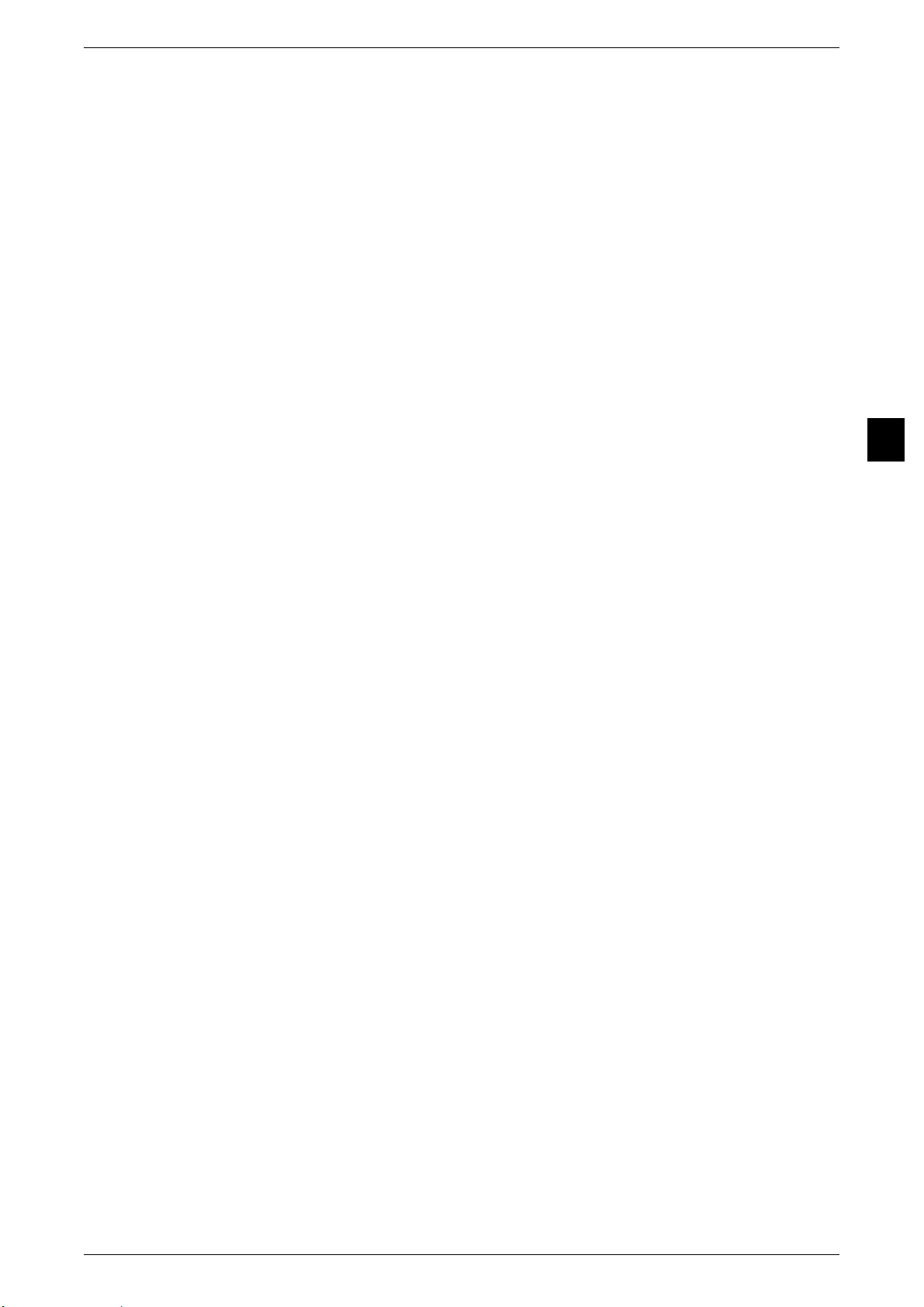
Assigning Features to <Custom> Buttons
You can assign services to the <Custom 1> to <Custom 3> buttons on the control
panel.
By assigning services to the <Custom> buttons, you can switch to these services
without returning to the [Services Home] screen. If you do not want to assign any
services to a button, select [(Not Set)].
Note • By factory default, [Copy] is assigned to the <Custom 1> button and [Review] is assigned to
the <Custom 3> button. No service is assigned to the <Custom 2> button.
For information on how to assign features, refer to "1 Before Using the Machine" > "Customizing the
Control Panel" > "Assigning Services to <Custom> Buttons" in the Administrator Guide.
Control Panel
Product Overview
2
51
Page 52
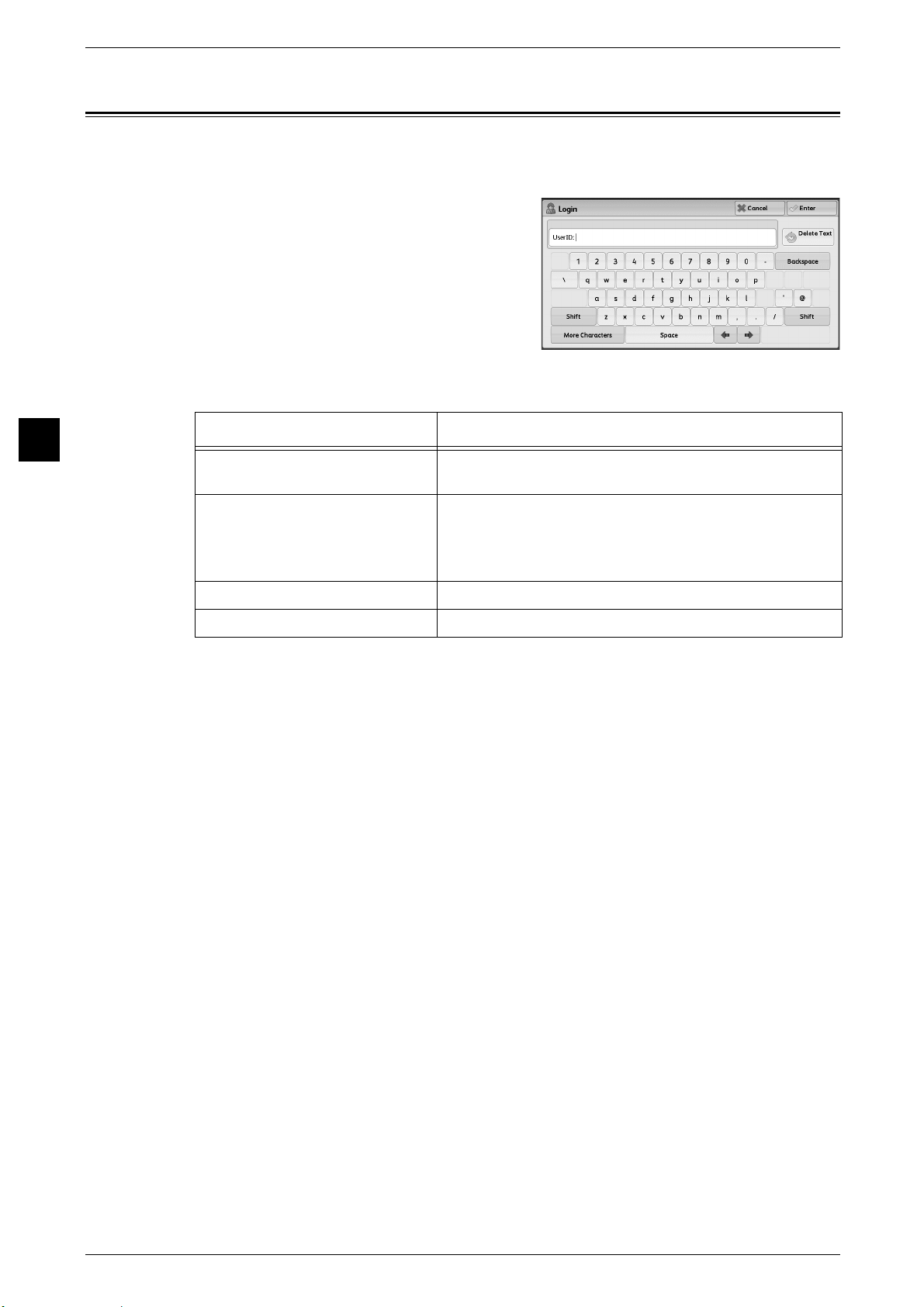
2 Product Overview
Entering Text
Product Overview
2
During operations, a screen for entering text sometimes appears. The following
describes how to enter text.
You can enter the following characters: numerals, alphabets, and symbols.
Item Description
Entering alphabets and numerals To enter uppercase letters, select [Shift]. To return to the
lowercase letters, select [Shift] again.
Entering symbols Select [More Characters].
Note • Depending on the keyboard, you can select a
symbol from the pull-up options displayed on the
bottom left of the screen.
Entering a space Select [Space].
Deleting characters Select [Backspace] to delete one character at a time.
52
Page 53

3 Copy
This chapter describes the basic operation and features for the Copy service.
z
Copying Procedure ..................................................................................... 54
z
Operations during Copying ......................................................................... 60
z
Simple Copy ............................................................................................... 63
z
Copy ........................................................................................................... 69
z
Image Quality..............................................................................................82
z
Layout Adjustment ...................................................................................... 91
z
Output Format........................................................................................... 106
z
Job Assembly ...........................................................................................137
Page 54
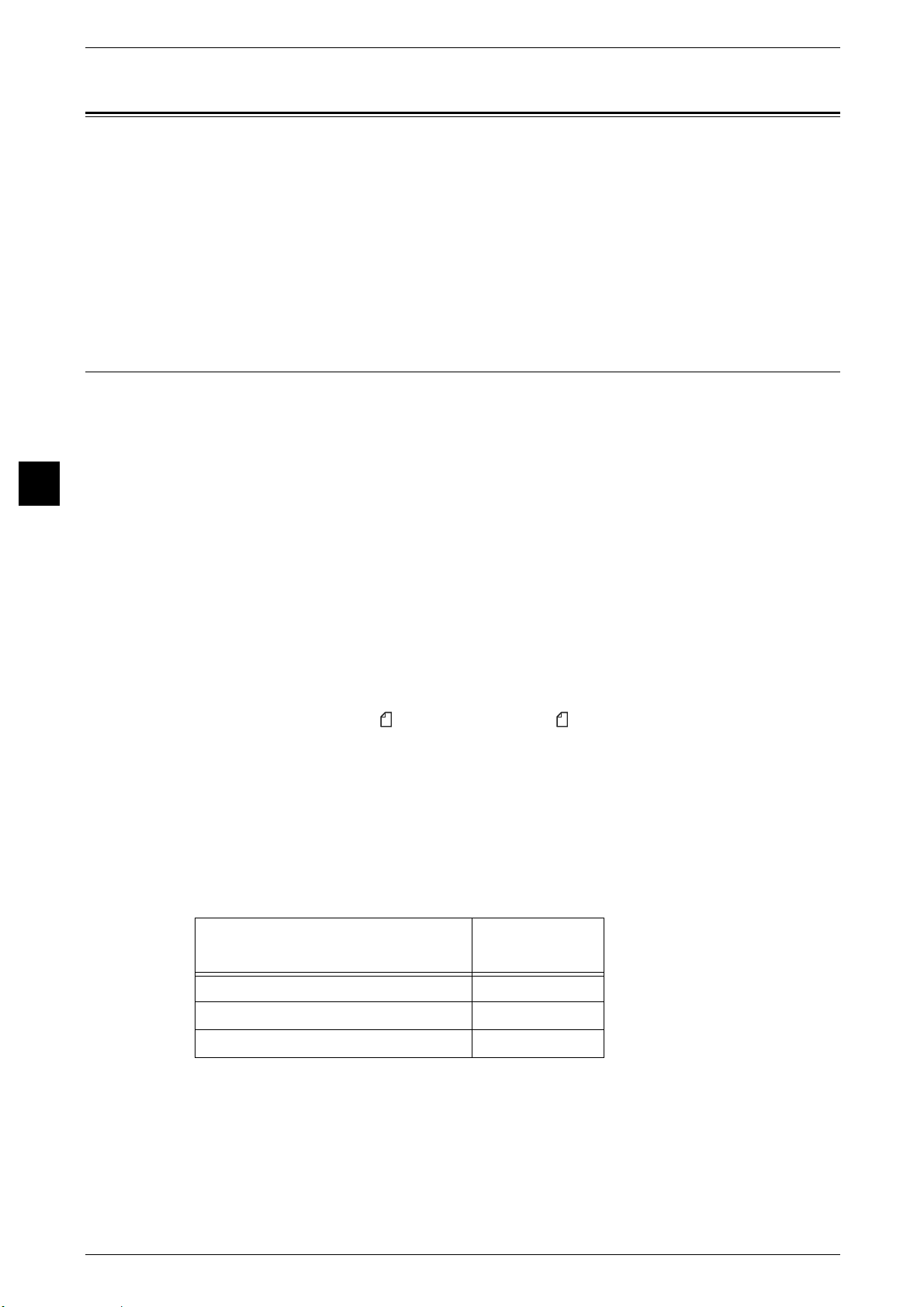
3 Copy
Copying Procedure
This section describes the basic copy procedures. The following shows the reference
section for each procedure.
Step 1 Loading Documents.........................................................................................................54
Step 2 Selecting Features ............................................................................................................56
Step 3 Entering a Quantity..........................................................................................................57
Step 4 Starting the Copy Job.......................................................................................................58
Step 5 Confirming the Copy Job in Job Status ...........................................................................59
Step 1 Loading Documents
Copy
3
Document Feeder
The following two methods are available to load documents:
Document Feeder
z
Single sheet
z
Multiple sheets
Document Glass
z
Single sheet
z
Bound documents, such as books
Document Feeder
The document feeder supports single and multiple sheet documents with sizes from
139.7 x 210 mm (A5, A5 , 5.5 x 8.5", 5.5 x 8.5" ) to 297 x 432 mm (A3, 11 x 17").
The document feeder automatically detects standard size documents. For nonstandard size documents, enter the size on the [Original Size] screen.
For information on entering document sizes, refer to "Original Size (Specifying the Scan Size for the
Document)" (P.96).
The standard document sizes that can be detected automatically depend on the [Paper Size Settings] in
the System Administration mode. For information on paper size settings, refer to "5 Tools" > "Common
Service Settings" > "Other Settings" > "Paper Size Settings" in the Administrator Guide.
54
The document feeder accepts the following number of sheets.
Document Type (Weight)
38 - 80 gsm 250 sheets
81 - 128 gsm 150 sheets
129 - 200 gsm 100 sheets
Important • To avoid paper jams, use the document glass for folded, creased, patched, curled, or back
carbon documents.
For information on how to copy mixed sized documents, refer to "Mixed Size Originals (Scanning
Different Size Documents Simultaneously)" (P.97).
Number of
Sheets
Page 55
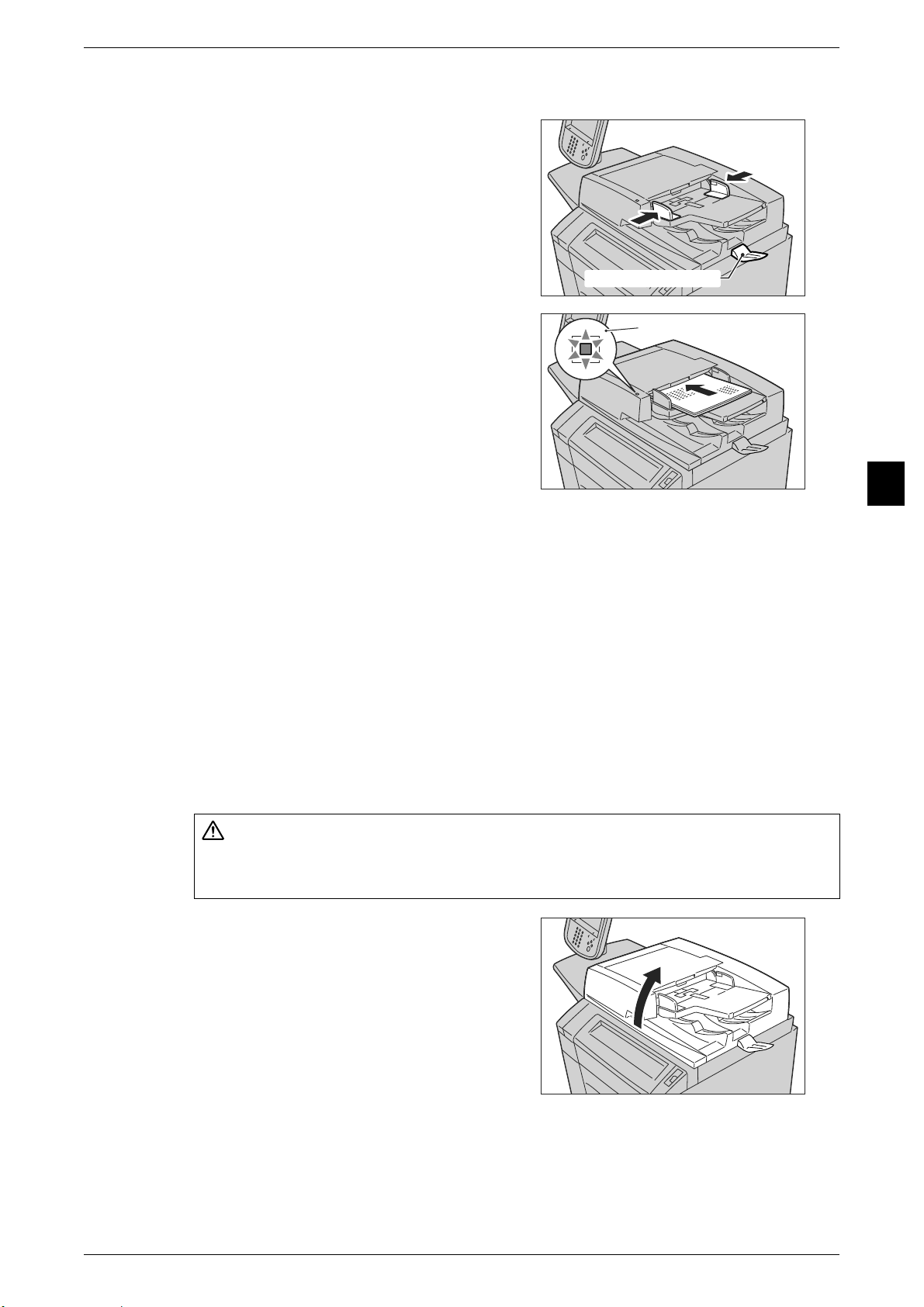
1 Remove any paper clips and staples before loading a document.
CAUTION
2 Adjust the movable document guides to
match the size of the document to be loaded.
Note • When loading a large document such as
A3, open the document stopper
rightward.
Document stopper
Copying Procedure
3 Place the document (the front side of 2-sided
document) face up in the center of the
document feeder.
Note • The Confirmation indicator lights up when
Document Glass
The document glass supports a single sheet, a book, or other similar documents from
15 x 15 mm to 297 x 432 mm (A3, 11 x 17").
Important • Always close the document cover after using the document glass.
The document glass automatically detects standard size documents. For non-standard
size documents, enter the size on the [Original Size] screen.
For information on entering document sizes, refer to "Original Size (Specifying the Scan Size for the
Document)" (P.96).
The standard document sizes that can be detected automatically depend on the [Paper Size Settings] in
the System Administration mode. For information on the paper size settings, refer to "5 Tools" >
"Common Service Settings" > "Other Settings" > "Paper Size Settings" in the Administrator Guide.
Confirmation indicator
the document is loaded correctly.
• When the document is loaded in the
document feeder, the document feeder
tray lifts up. The timing of the lift can be
programmed in [System Settings]. For
more information, refer to "5 Tools" >
"Common Service Settings" > "Other
Settings" > "Document Feeder Tray Elevation" in the Administrator Guide.
Copy
3
Do not apply excessive force to hold thick document on the document glass. It may
break the glass and cause injuries.
1 Open the document cover.
Important • Ensure that the touch screen is active,
and then load a document. Otherwise, the
machine may not properly detect the
document size.
55
Page 56

3 Copy
<Services Home> button
2 Load the document face down, and align it
against the top left corner of the document
glass.
3 Close the document cover.
Note • When a standard size document is placed on the document glass, the size of the document
is displayed in the message area.
Step 2 Selecting Features
Copy
3
The following two services are available to copy documents.
Simple Copy
Allows you to only select basic features to copy documents.
Copy
Allows you to make detailed settings to copy documents.
The following procedure uses [Copy] to describe how to select features.
For information on Simple Copy, refer to "Simple Copy" (P.63).
Note • The features displayed on the screen depend on your machine configuration.
• When the Authentication or Accounting feature is enabled, a user ID and passcode may be
required. Ask your system administrator for the user ID and passcode.
1 Press the <Services Home> button.
56
2 Select [Copy].
Page 57
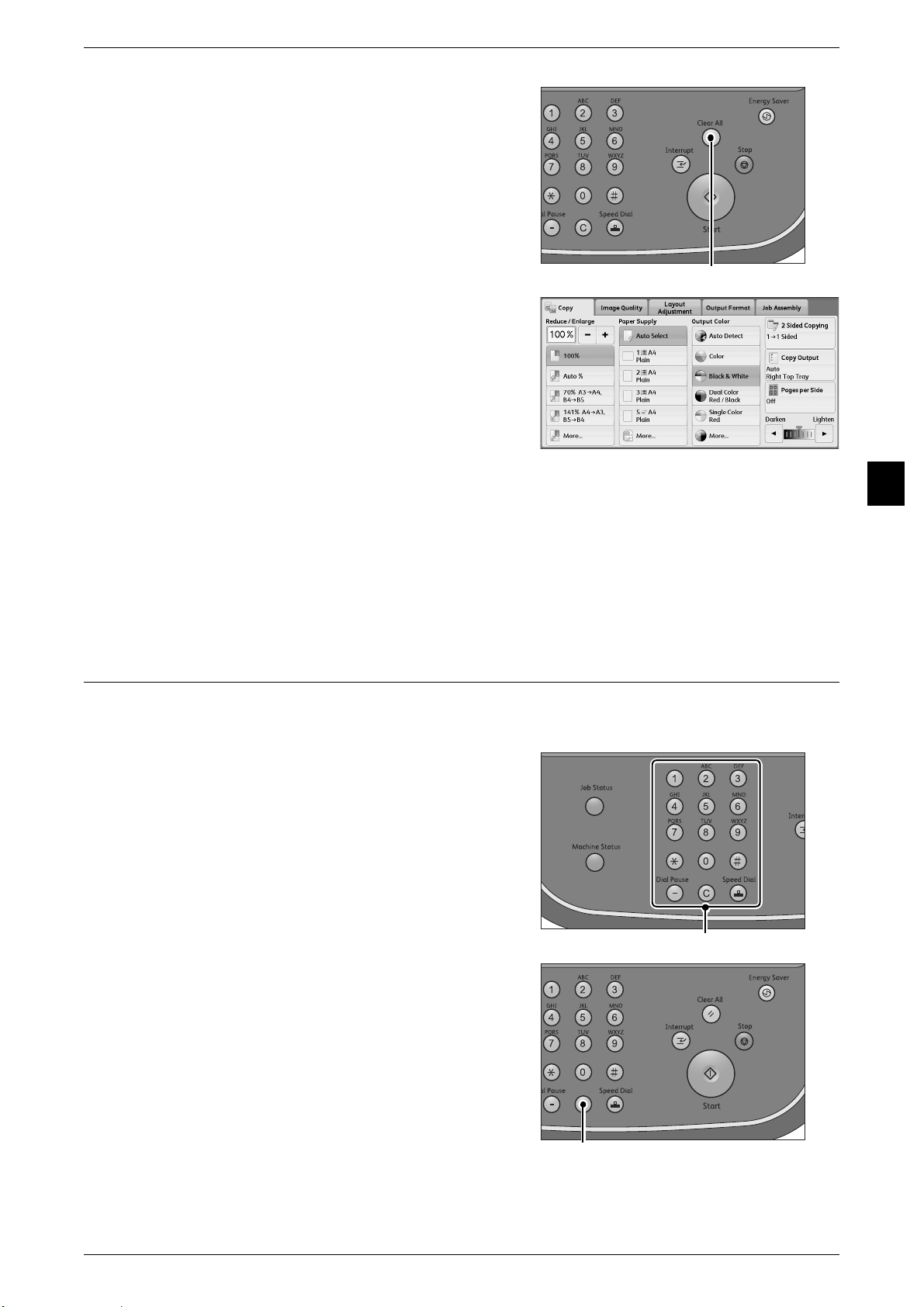
3 If the previous settings still remain, press the
<Clear All> button
Numeric keypad
<C (Clear)> button
<Clear All> button.
4 Select each tab, and configure features as
necessary.
Copying Procedure
Copy
The following shows the reference section for each tab.
"Copy" (P.69)
"Image Quality" (P.82)
"Layout Adjustment" (P.91)
"Output Format" (P.106)
"Job Assembly" (P.137)
Step 3 Entering a Quantity
The following describes how to enter the number of copy sets. You can enter up to
9999 sets.
1 Enter the number of copies using the
numeric keypad.
The number of copies entered appears on
the upper right of the touch screen.
3
2 If you have entered an incorrect value, press
the <C (Clear)> button and then enter the
correct value.
57
Page 58

3 Copy
<Start> button
Step 4 Starting the Copy Job
The following describes how to start a copy job.
1 Press the <Start> button.
Important • If the document has been loaded in the
document feeder, do not hold down the
document while it is being conveyed.
Note • If a problem occurs, an error message
appears on the touch screen. Solve the
problem according to the message.
• You can set the next job during copying.
If you have more documents
Copy
If you have more documents to copy, select [Next Original] on the touch screen while
the current document is being scanned. This allows you to scan the documents as a
single set of data.
3
2 Select [Next Original] while scanning is in
progress.
Note • When using the document feeder, load
the next document after the machine has
finished scanning the first document.
• When [Next Original] is displayed on the
screen shown on the right and no
operation is performed for a certain period
of time, the machine automatically
assumes that there are no more documents.
• You can change the number of copies by selecting [Change Quantity] that is displayed after
selecting [Delete].
3 Load the next document.
4 Press the <Start> button.
If you have more documents, repeat steps 3 and 4.
58
5 When all documents have been scanned,
select [Last Original].
Page 59
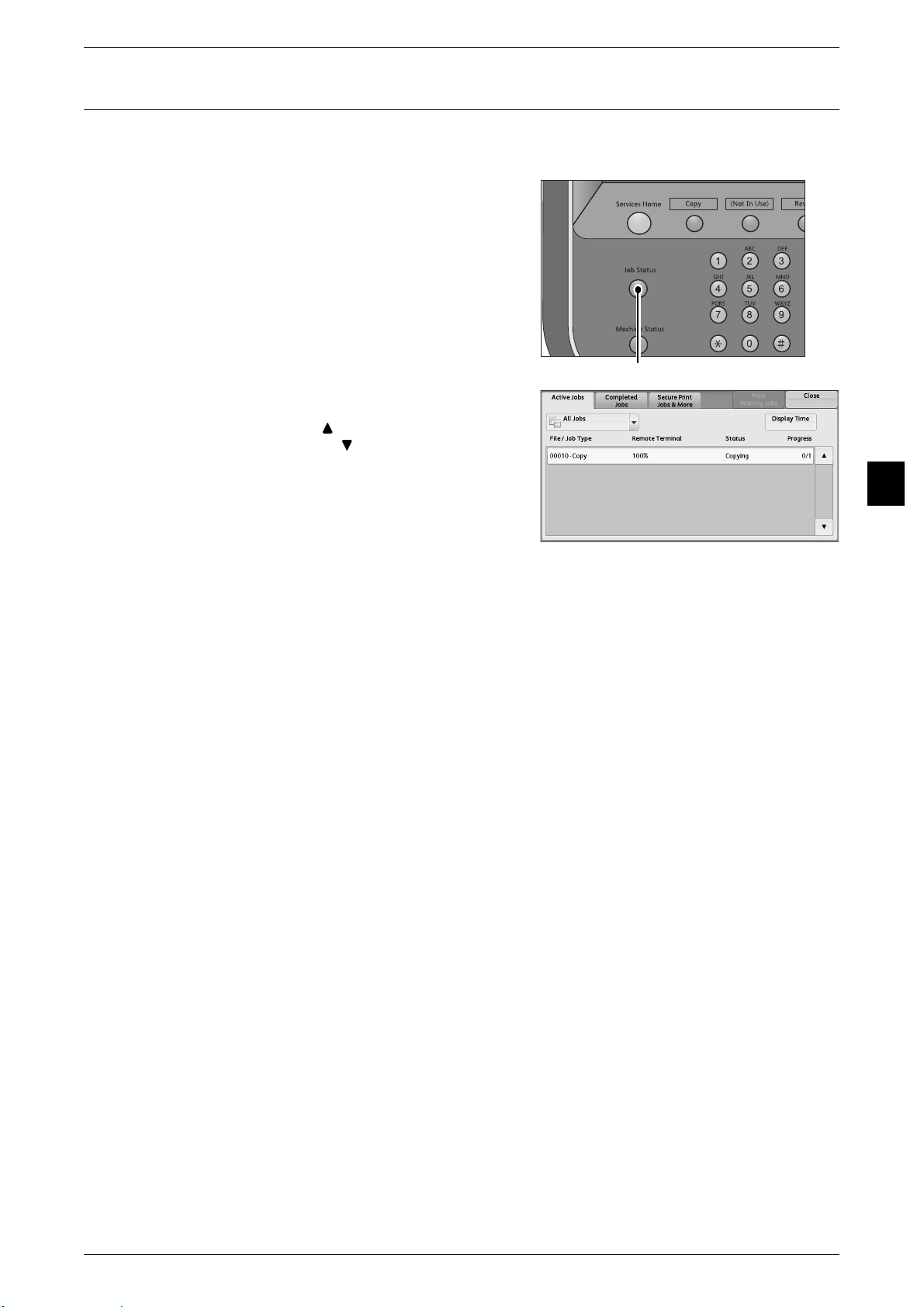
Step 5 Confirming the Copy Job in Job Status
<Job Status> button
If copies are not output after you start the copy job, the job may be in pending status.
Use the following procedure to confirm the job status.
1 Press the <Job Status> button.
Copying Procedure
2 Confirm the job status.
Note • Select [ ] to return to the previous
screen or [ ] to move to the next screen.
Copy
3
59
Page 60

3 Copy
<Stop> button
<Job Status> button
Operations during Copying
This section describes available operations during copying. The following shows the
reference section for each operation.
Stopping the Copy Job................................................................................................................60
Changing the Number of Copies.................................................................................................61
Interrupting the Copy Job ...........................................................................................................62
Stopping the Copy Job
To cancel a copy job in progress, use the following procedure.
1 Press either the <Stop> button on the control
Copy
panel or [Delete] on the touch screen.
3
2 Select [Delete].
60
If [Delete] does not appear on the screen:
1 Press the <Job Status> button.
Page 61

2 Select the job to cancel.
<Stop> button
Note • Select [ ] to return to the previous
screen or [ ] to move to the next screen.
3 Select [Delete].
4 Select [Delete].
Operations during Copying
Copy
Changing the Number of Copies
To change the number of copy sets during scanning or copying, use the following
procedure.
1 Press either the <Stop> button on the control
panel or [Delete] on the touch screen.
3
61
Page 62
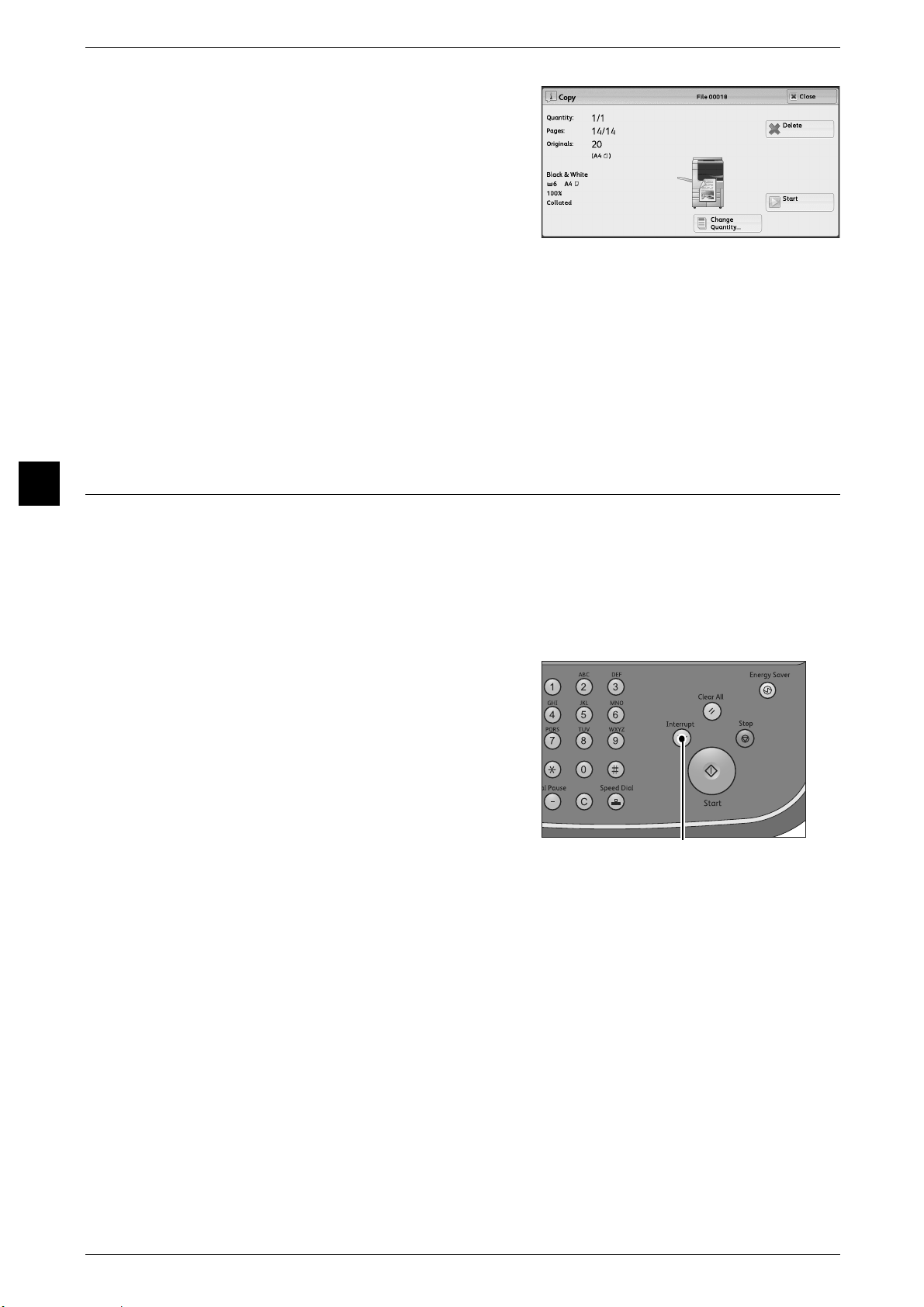
3 Copy
<Interrupt> button
2 Select [Change Quantity].
3 Specify the number of copy sets with the numeric keypad.
The new quantity must include the number of copies that have already been printed.
You cannot enter a number less than the number of copies that have already been
printed.
4 Press the <Start> button.
Copy
Interrupting the Copy Job
3
Note • If you enter the same value as the number of copies that have already been printed, the
You can temporarily stop the copy job to have the machine process another job.
Important • Press the <Interrupt> button only after all the documents have been scanned. The machine
1 Press the <Interrupt> button.
The <Interrupt> button lights up to indicate
that the machine is in the Interrupt mode.
machine will not execute a copy job even when you press the <Start> button.
does not accept another job while it is scanning the documents, or [Next Original] has been
selected.
• If a copy job which was scanned using the document glass and was specified for less than
10 sets is being processed, the machine may not accept another job even when the
<Interrupt> button is pressed.
2 Load a document and set features if necessary.
3 Specify the number of copy sets with the numeric keypad.
4 Press the <Start> button.
5 After you have finished making the interrupt copy, press the <Interrupt> button.
6 Press the <Start> button.
62
The <Interrupt> button goes out to indicate that the Interrupt mode is exited.
Note • If you used the document glass to copy the document, remove the document from the
document glass.
The suspended copy job is resumed.
Page 63

Simple Copy
You can select [Copy] or [Simple Copy] on the [Services Home] screen to set the
features for the Copy service.
This section describes the features you can select on the [Simple Copy] screen.
[Simple Copy] allows you to use only basic features to easily copy documents. The
following shows the reference section for each feature.
Paper Supply (Selecting the Paper for Copying) ....................................................................... 63
Reduce/Enlarge (Making Enlarged/Reduced Copies)................................................................ 64
2 Sided Copying (Making 2 Sided Copies)................................................................................ 65
Black & White/Color (Selecting the Color for Copying) .......................................................... 65
Lighten/Darken (Adjusting the Copy Density).......................................................................... 66
2 Pages per Side (Copying Two Pages onto One Sheet)............................................................ 66
1 Staple....................................................................................................................................... 67
1 Select [Simple Copy] on the [Services
Home] screen.
Simple Copy
Copy
2 Select a feature on the [Simple Copy]
screen.
Paper Supply (Selecting the Paper for Copying)
This feature allows you to select the paper tray for copying.
1 Select [Paper Supply].
3
2 Select a paper tray to be used.
63
Page 64
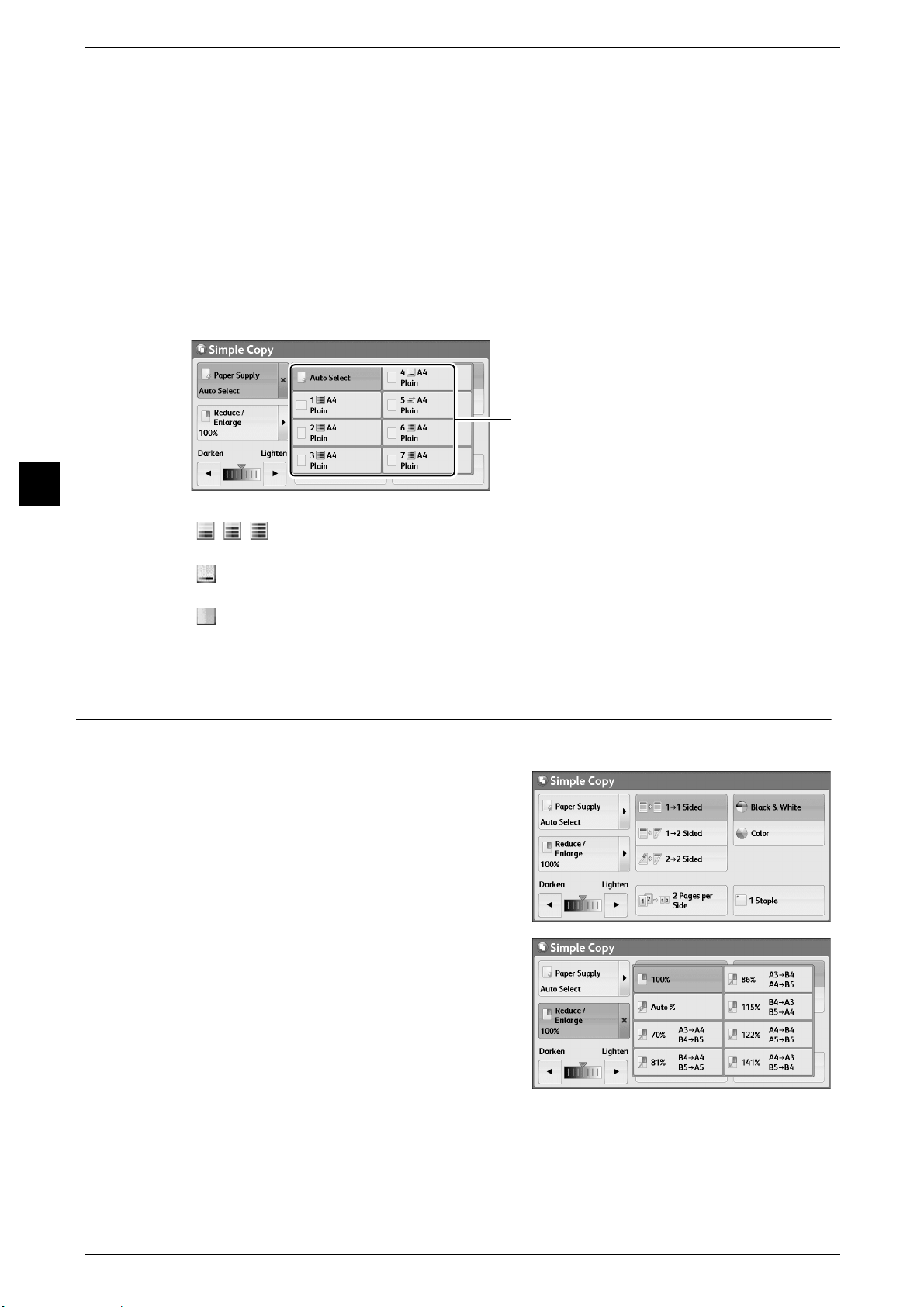
3 Copy
You can view the icons to check the
remaining amount of paper in a tray.
Auto Select
Automatically determines the tray holding the appropriate paper, based on the
document size and the specified copy ratio.
Note • If you select [Auto Select], an option other than [Auto %] is selected in [Reduce/Enlarge].
Trays 1 to 5, and Trays 6 and 7 (optional)
Allows you to directly select the desired tray.
Checking the Remaining Amount of Paper in a Tray
The icons displayed in a tray allows you to check the remaining amount of paper loaded
in the tray.
Copy
3
Reduce/Enlarge (Making Enlarged/Reduced Copies)
This feature allows you to select a copy ratio to enlarge or reduce the size of copies.
1 Select [Reduce/Enlarge].
: Indicates that the remaining amount of paper is 25 to 100%.
: Indicates that the remaining amount of paper is 25% or less.
: Indicates that the tray has run out of paper, or no paper is loaded in
the tray.
64
2 Select a copy ratio.
100%
Copies at the same image size as the original document.
Page 65
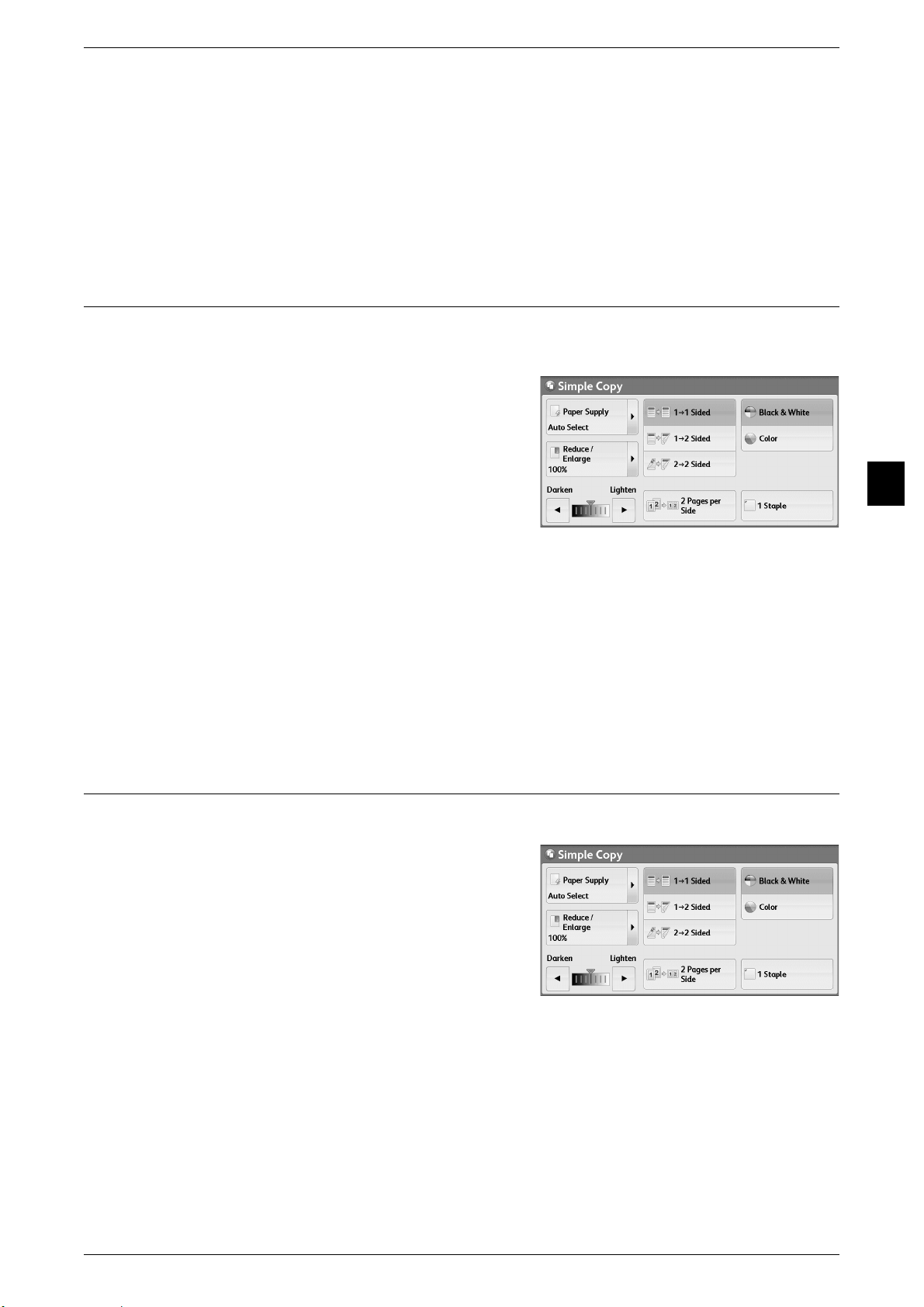
Auto %
Automatically determines the copy ratio based on the document size and the paper size
specified in [Paper Supply], and copies the document to fit into the paper.
Note • If you select [Auto %], an option other than [Auto Select] is selected in [Paper Supply].
Ratios
Allows you to select from preset copy ratios.
2 Sided Copying (Making 2 Sided Copies)
This feature allows you to copy 1-sided and 2-sided documents on one side or both
sides of paper.
1 Select any option.
Simple Copy
Copy
1 J 1 Sided
Makes a copy of a 1-sided document on one side of the paper.
1 J 2 Sided
Makes a copy of a 1-sided document on both sides of the paper.
2 J 2 Sided
Makes a copy of a 2-sided document on both sides of the paper.
Black & White/Color (Selecting the Color for Copying)
This feature allows you to select a color mode.
1 Select [Black & White] or [Color].
3
Black & White
Copies in black and white regardless of the colors in the original document.
Color
Copies in full color.
Note • If the use of certain colors is not allowed, the available colors will be restricted. For more
information, refer to "5 Tools" > "Accounting" > "Create/View User Accounts" > "Account
Limit" in the Administrator Guide.
65
Page 66

3 Copy
Lighten/Darken (Adjusting the Copy Density)
This feature allows you to select a copy-density level from seven levels. The copy
becomes darker when you move [ ] to the left, and lighter when you move it to the
right.
1 Use [ ] and [ ] to select a density level.
2 Pages per Side (Copying Two Pages onto One Sheet)
Copy
This feature allows you to copy two pages of a document together onto a single sheet
of paper.
3
When you select [2 Pages per Side], [Auto %] is automatically selected in [Reduce/
Enlarge]. The machine automatically sets the copy ratio and makes copies of the
images so that they fit on the selected paper.
Note • When you deselect [Auto %] in [Reduce/Enlarge] (when you select another copy ratio),
image loss may occur depending on the image size of the document.
• Select a tray other than [Auto Select] in [Paper Supply]. When you select [Auto Select], the
tray containing A4 paper is selected. If no tray contains A4 paper, the machine select a tray
based on the [Auto Paper Off] setting. For information on [Auto Paper Off], refer to "5 Tools"
> "Copy Service Settings" > "Copy Control" > "Auto Paper Off" in the Administrator Guide.
For information on how to copy four or eight pages of a document together onto a single sheet of paper,
refer to "Pages per Side (Copying Multiple Pages onto One Sheet)" (P.111).
1 Select [2 Pages per Side].
66
Page 67

1 Staple
Simple Copy
This feature allows you to select whether to staple copied outputs at the top left corner.
The Finisher C2 and the Finisher C2 with Booklet Maker are capable of stapling 2 - 50
sheets of paper (when 80 gsm paper is used). The Finisher D4 and the Finisher D4 with
Booklet Maker are capable of stapling 2 - 100 sheets of paper (when 80 gsm paper is
used).
Paper types that are selectable on the touch screen are as follows.
z
Finisher C2/Finisher C2 with Booklet Maker:
- Plain (64 - 79 gsm) - Plain (80 - 90 gsm)
- Plain (91 - 105 gsm) - Heavyweight (106 - 128 gsm)
- Heavyweight (129 - 150 gsm) - Heavyweight (151 - 176 gsm)
- Extra-HW (177 - 220 gsm) - Plain Reload (64 - 79 gsm)
- Plain Reload (80 - 90 gsm) - Plain Reload (91 - 105 gsm)
- HW Reload (106 - 128 gsm) - HW Reload (129 - 150 gsm)
- HW Reload (151 - 176 gsm) - X-HW Reload (177 - 220 gsm)
- Punched (64 - 79 gsm) - Punched (80 - 90 gsm)
- Punched (91 - 105 gsm) - Hole Punched HW 1 (106 - 128 gsm)
Copy
3
- Hole Punched HW 1 (129 - 150 gsm) - Hole Punched HW 1 (151 - 176 gsm)
- Hole Punched HW 2 (177 - 220 gsm) - Tab Stock (106 - 128 gsm)
- Tab Stock (129 - 150 gsm) - Tab Stock (151 - 176 gsm)
- Tab Stock (177 - 220 gsm) - Recycled (64 - 79 gsm)
- Recycled (80 - 90 gsm) - Recycled (91 - 105 gsm)
- Gloss (106 - 128 gsm) - Gloss (129 - 150 gsm)
- Heavyweight Gloss (151 - 176 gsm) - Heavyweight Gloss (177 - 220 gsm)
- Gloss Reload (106 - 128 gsm) - Gloss Reload (129 - 150 gsm)
- HW Gloss Reload (151 - 176 gsm) - HW Gloss Reload (177 - 220 gsm)
67
Page 68
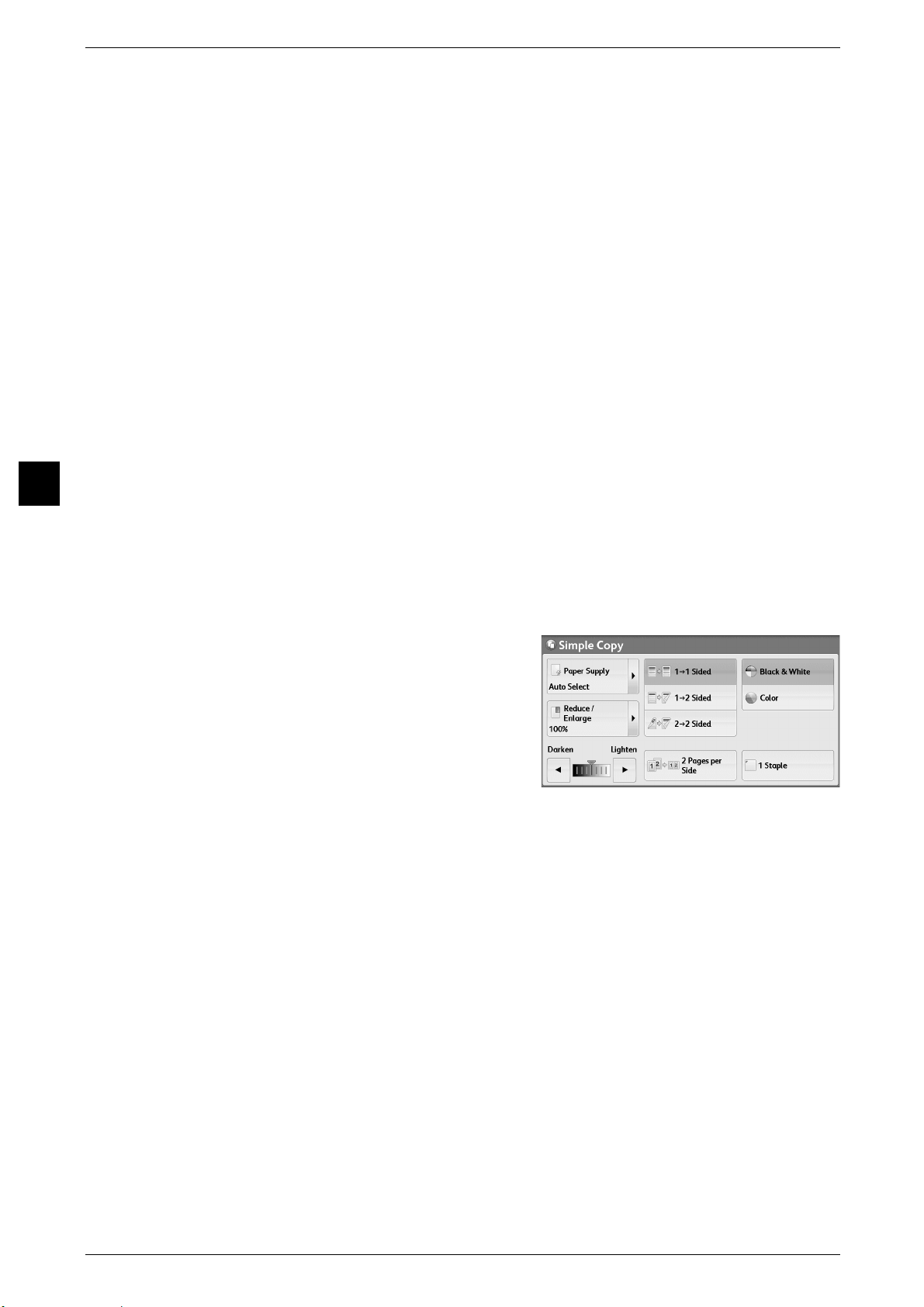
Copy
3
3 Copy
z
Finisher D4/Finisher D4 with Booklet Maker:
- Plain (64 - 79 gsm) - Plain (80 - 90 gsm)
- Plain (91 - 105 gsm) - Heavyweight (106 - 128 gsm)
- Heavyweight (129 - 150 gsm) - Heavyweight (151 - 176 gsm)
- Extra-HW (177 - 220 gsm) - X-HW Plus (221 - 256 gsm)
- X-HW Plus 2 (257 - 300 gsm) - Plain Reload (64 - 79 gsm)
- Plain Reload (80 - 90 gsm) - Plain Reload (91 - 105 gsm)
- HW Reload (106 - 128 gsm) - HW Reload (129 - 150 gsm)
- HW Reload (151 - 176 gsm) - Recycled (64 - 79 gsm)
- Recycled (80 - 90 gsm) - Recycled (91 - 105 gsm)
- Gloss (106 - 128 gsm) - Gloss (129 - 150 gsm)
- Heavyweight Gloss (151 - 176 gsm) - Heavyweight Gloss (177 - 220 gsm)
- X-HW Gloss (221 - 256 gsm) - Gloss Reload (106 - 128 gsm)
- Gloss Reload (129 - 150 gsm) - HW Gloss Reload (151 - 176 gsm)
- HW Gloss Reload (177 - 220 gsm) - X-HW Gloss Reload (221 - 256 gsm)
- Tab Stock (106 - 128 gsm) - Tab Stock (129 - 150 gsm)
- Tab Stock (151 - 176 gsm) - HW Tab Stock (177 - 220 gsm)
- X-HW Tab Stock (221 - 256 gsm) - X-HW Tab Stock (257 - 300 gsm)
Note • Optional finishing module is required to enable this feature. For more information, contact
your local Fuji Xerox representative.
1 Select [1 Staple].
68
Page 69
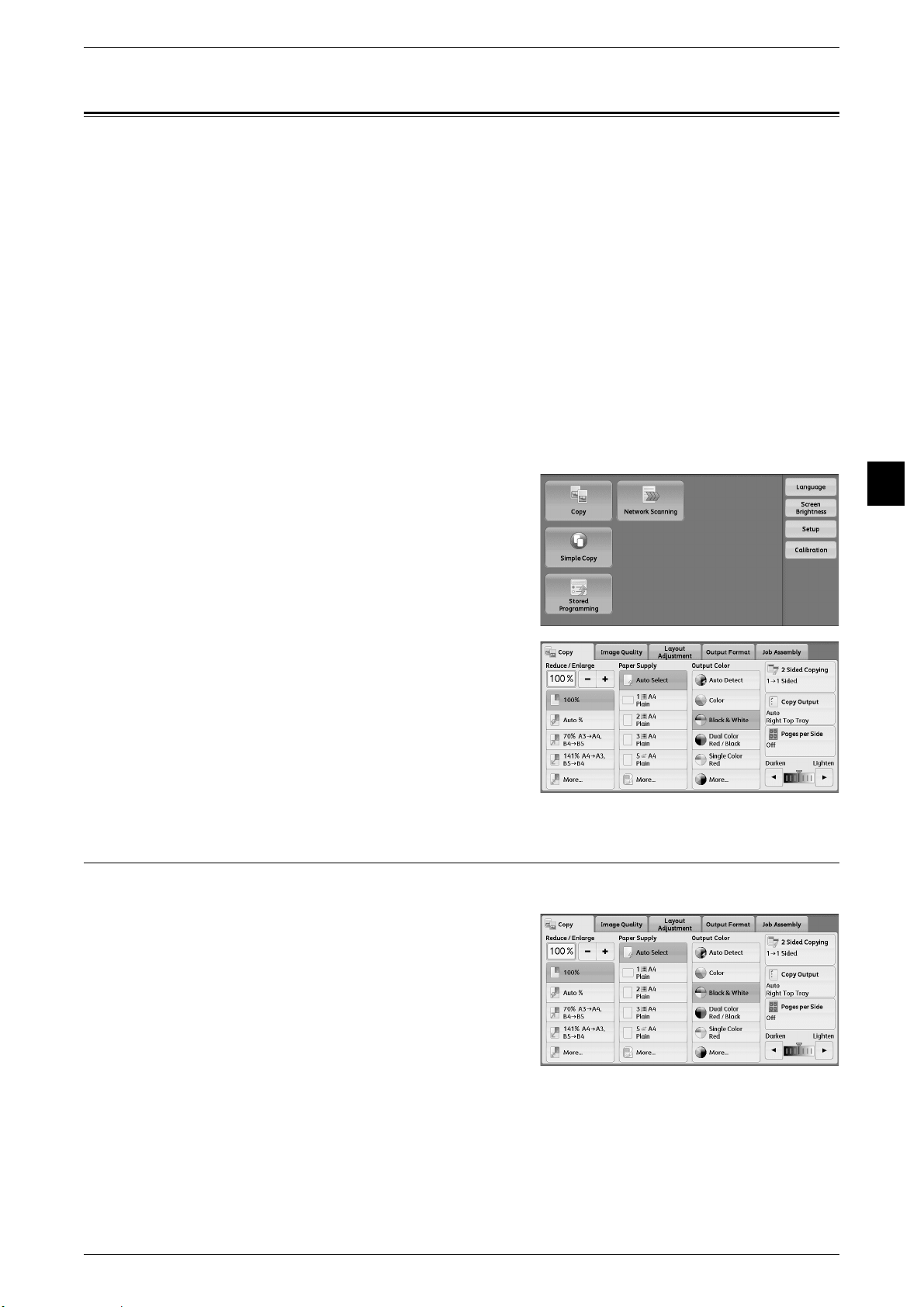
Copy
Copy
You can select [Copy] or [Simple Copy] on the [Services Home] screen to set the
features for the Copy service.
This section describes the features you can select on the [Copy] screen. The following
shows the reference section for each feature.
Reduce/Enlarge (Making Enlarged/Reduced Copies)................................................................ 69
Paper Supply (Selecting the Paper for Copying) ....................................................................... 73
Output Color (Selecting the Color for Copying)........................................................................ 76
2 Sided Copying (Making 2 Sided Copies)................................................................................ 80
Copy Output (Specifying Finishing Options) ............................................................................ 80
Pages per Side (Copying Multiple Pages onto One Sheet)...................................................... 111
Lighten/Darken (Adjusting the Copy Density).......................................................................... 81
You can customize the layout of the features displayed on the [Copy] screen. For more information,
refer to "5 Tools" > "Copy Service Settings" > "Copy Tab - Features Allocation" in the Administrator
Guide.
Copy
1 Select [Copy] on the [Services Home]
screen.
2 Select a feature on the [Copy] screen.
Reduce/Enlarge (Making Enlarged/Reduced Copies)
This feature allows you to select a copy ratio to enlarge or reduce the size of copies.
1 Specify a copy ratio.
You can use the numeric keypad to specify a
value, or [+] and [-] to specify reduction/
enlargement ratios directly.
3
100%
Copies at the same image size as the original document.
Auto %
Automatically determines the copy ratio based on the document size and the paper size
specified in [Paper Supply], and copies the document to fit into the paper.
Note • If you select [Auto %], an option other than [Auto Select] is selected in [Paper Supply].
69
Page 70

3 Copy
Copy
Original
Ratios (3rd and 4th buttons)
Displays preset copy ratios.
You can change the copy ratio associated with each button. For information on the settings, refer to "5
Tools" > "Copy Service Settings" > "Preset Buttons" > "Reduce/Enlarge - Button 3 - 4" in the
Administrator Guide.
More
Displays the [Reduce/Enlarge] screen on which you can set [Proportional %],
[Independent X - Y%], and [Calculator %].
For information on the settings on the [Reduce/Enlarge] screen, refer to "When [Proportional %] is
Selected" (P.70), "When [Independent X - Y%] is Selected" (P.71), or "When [Calculator %] is
Selected" (P.72).
When [Proportional %] is Selected
Copy
3
You can select a ratio from the standard copy ratios, or can enter a ratio directly.
1 Select a copy ratio, or specify a value.
Variable %
Specify a ratio in the range from 25 to 400% in 1% increments. To specify a value, use
the numeric keypad or [+] and [-]. Specifying "100%" allows you to make copies at the
same image size as the original document.
When you make enlarged/reduced copies from standard sized documents on standard
sized paper, the following copy ratios will be applied.
A6 B6 A5 B5 A4 B4 A3
A6
100% 122% 141% 173% 200% 245% 283%
70
B6
A5
B5
A4
B4
A3
How to load a document depends on the size and orientation of a document. For more information, refer
to "Step 1 Loading Documents" (P.54).
For information on paper that can be loaded, refer to "2 Paper and Other Media" > "Paper Types" in the
Administrator Guide.
82% 100% 116% 142% 164% 200% 232%
71% 86% 100% 122% 141% 174% 200%
58% 70% 81% 100% 115% 141% 163%
50% 61% 70% 86% 100% 122% 141%
41% 50% 58% 70% 81% 100% 115%
35% 43% 50% 61% 70% 86% 100%
Page 71
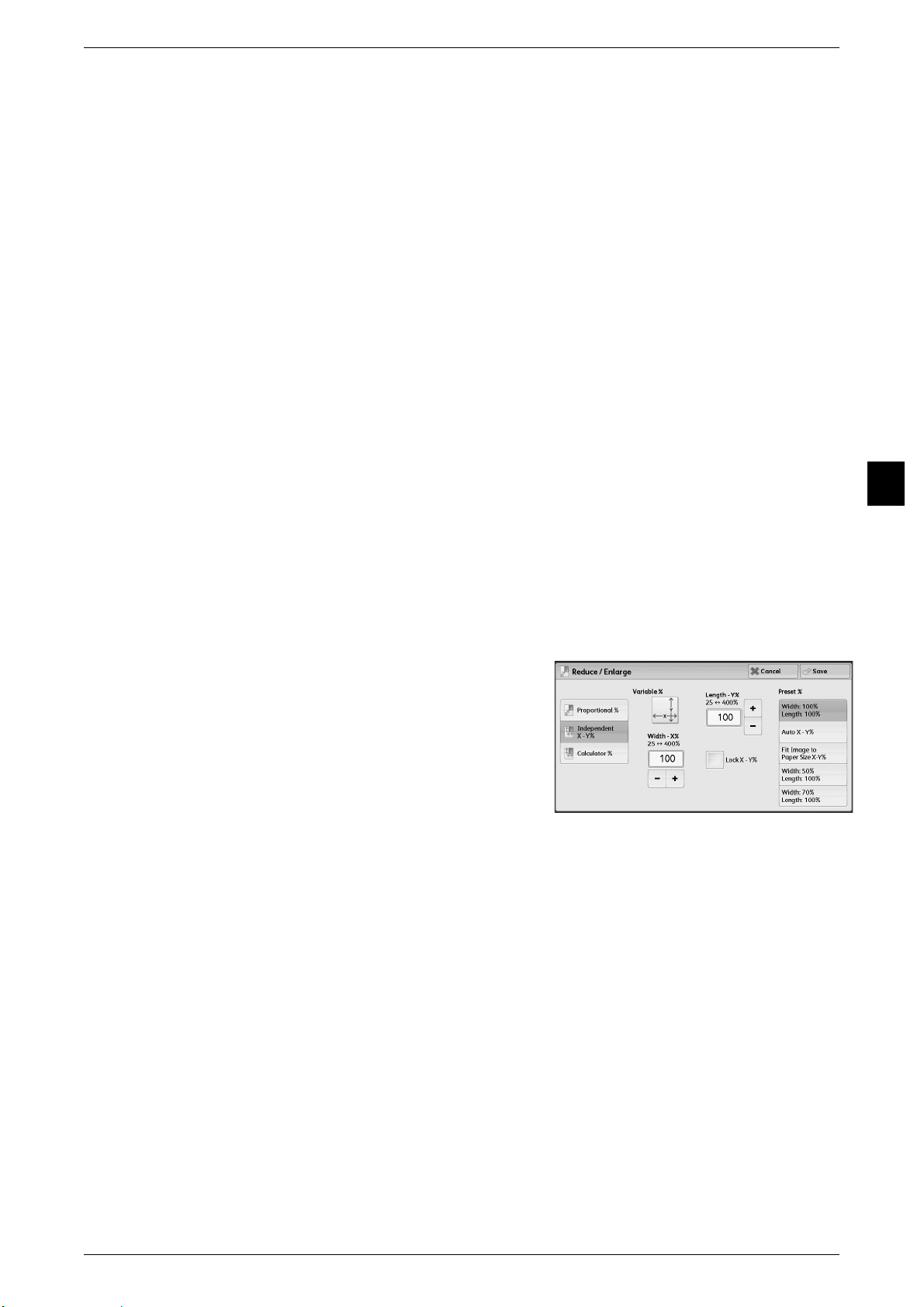
Copy
Preset %
Select a copy ratio from the following options.
z
100%
Copies at the same image size as the original document.
z
Auto %
Automatically determines the copy ratio based on the document size and the paper
size specified in [Paper Supply], and copies the document to fit into the paper.
Note • If you select [Auto %], an option other than [Auto Select] is selected in [Paper Supply].
z
Preset ratios
Select from the preset ratios.
You can change the copy ratio associated with each button. For information on the settings, refer to "5
Tools" > "Copy Service Settings" > "Reduce/Enlarge Presets" in the Administrator Guide.
Slight Reduction (Improves Fit)
Select this check box to slightly reduce the specified copy ratio to copy the complete
image onto the paper.
Important • If you select [Slight Reduction (Improves Fit)] and you do not want to erase the edges of the
document, set the amount of edge erase to 0 mm. Note that if the amount is set to 0 mm, the
edges of the copied document may get dirty. You can set [Edge Erase] on the [Layout
Adjustment] screen. For more information, refer to "Edge Erase (Erasing Edges and Margin
Shadows of the Document)" (P.98).
Copy
3
When [Independent X - Y%] is Selected
You can specify reduction/enlargement ratios for the width and length individually.
1 Select any option.
Variable%
z
Width - X%, Length -Y%
Allows you to specify reduction/enlargement ratios for the width and length in the
range from 25 to 400% in 1% increments. Use [+] and [-] or the numeric keypad to
specify a ratio.
Lock X - Y%
Allows you to make the same ratio adjustment for the width and length at the same
time.
Preset %
z
Width: 100% /Length: 100%
Copies at the same image size as the original document.
71
Page 72

Copy
3
3 Copy
z
Auto X - Y%
Automatically determines the reduction/enlargement ratios for the width and length
so that the document image fits in the paper.
z
Fit Image to Paper Size X - Y%
Automatically determines the reduction/enlargement ratios for the width and length
so that the document image fits in the paper, and then slightly reduces the ratios so
that the complete image is copied onto the paper.
z
Width: XX% Length: XX%
Allows you to specify the preset reduction/enlargement ratios.
When [Calculator %] is Selected
You can specify values for the length and width individually.
If you specify both the original document size and the desired copy size, the copy ratios
for the length and width are calculated automatically in the range from 25 to 400%
according to the values that you entered.
Important • Selecting [Calculator %] allows you to set copy ratios. The values entered in [Original Size]
and [Copy Size] are used to calculate ratios, and do not reflect a scan size for the document
or the paper size. Be sure to specify a scan size for the document. Also, select a paper tray
if necessary.
For information on how to specify a scan size for the document, refer to "Original Size (Specifying the
Scan Size for the Document)" (P.96). For information on how to select a paper tray, refer to "Paper
Supply (Selecting the Paper for Copying)" (P.73).
1 Enter the width of the original document in
[Original Size] of [Width X%] using the
numeric keypad.
2 Enter the width of the output copy in [Copy Size] of [Width X%] using the numeric
keypad.
3 In the same way, enter the length for [Original Size] and [Copy Size] of [Length Y%].
Width X% / Length Y%
Displays the ratios that are automatically calculated using the values set in [Original
Size] and [Copy Size].
Original Size
Allows you to enter the width and length of the original document, in the range from 1
to 999 mm in 1 mm increments.
72
Copy Size
Allows you to enter the width and length of output copies, in the range from 1 to 999
mm in 1 mm increments.
Page 73
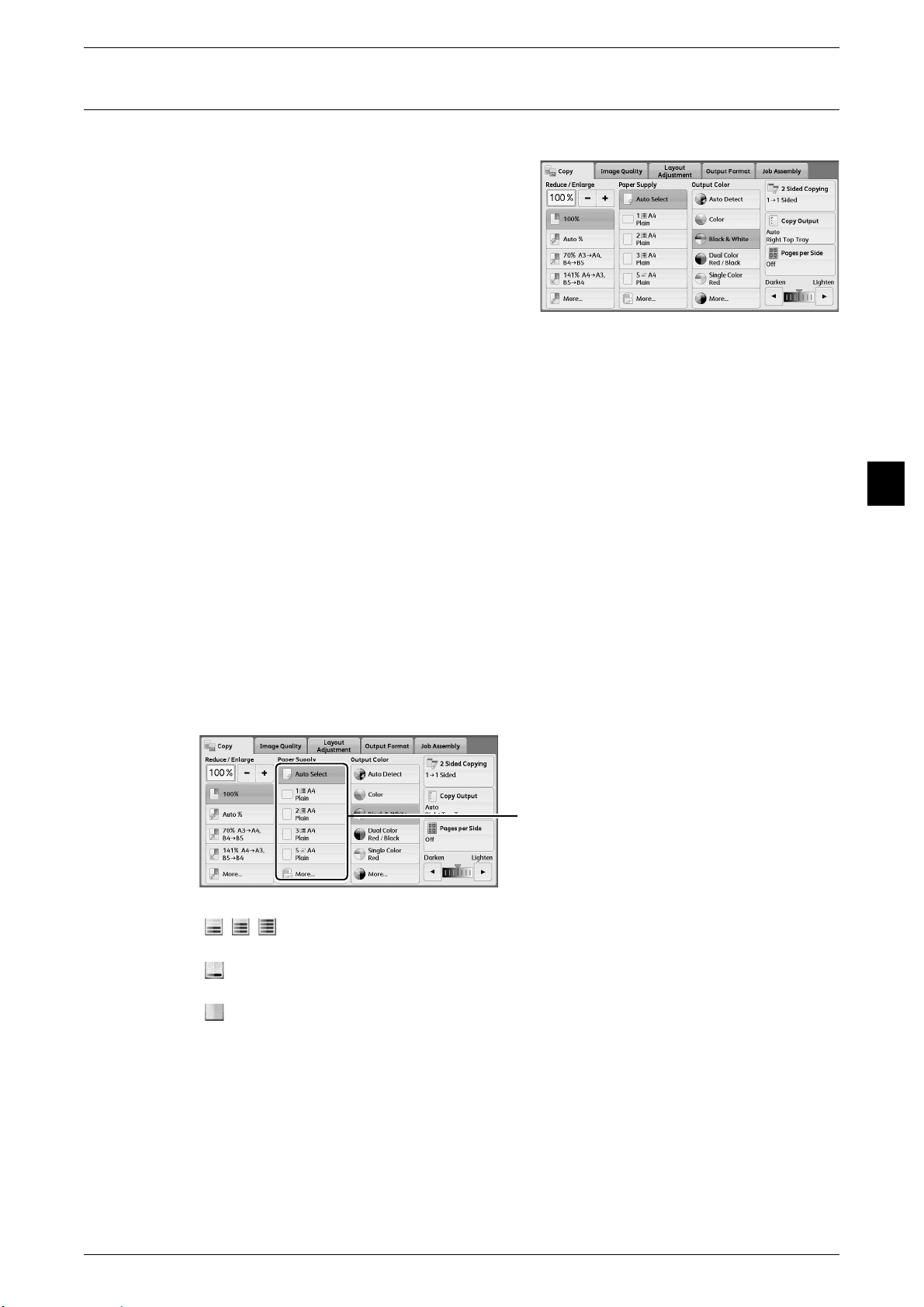
Paper Supply (Selecting the Paper for Copying)
You can view the icons to check the
remaining amount of paper in a tray.
This feature allows you to select the tray that holds the paper you want to use.
1 Select a paper tray.
Auto Select
Automatically determines the tray holding the appropriate paper, based on the
document size and the specified copy ratio.
Note • If you select [Auto Select], an option other than [Auto %] is selected in [Reduce/Enlarge].
Trays (2nd to 5th buttons)
Copy
Copy
Allows you to directly select the desired tray.
You can change the paper tray associated with each button on the [Copy] screen. For information on the
settings, refer to "5 Tools" > "Copy Service Settings" > "Preset Buttons" > "Paper Supply - Button 2 - 5"
in the Administrator Guide.
More
Displays the [Paper Supply] screen.
Refer to "[Paper Supply] Screen" (P.74).
Checking the Remaining Amount of Paper in a Tray
The icons displayed in a tray allows you to check the remaining amount of paper loaded
in the tray.
: Indicates that the remaining amount of paper is 25 to 100%.
3
: Indicates that the remaining amount of paper is 25% or less.
: Indicates that the tray has run out of paper, or no paper is loaded in
the tray.
73
Page 74
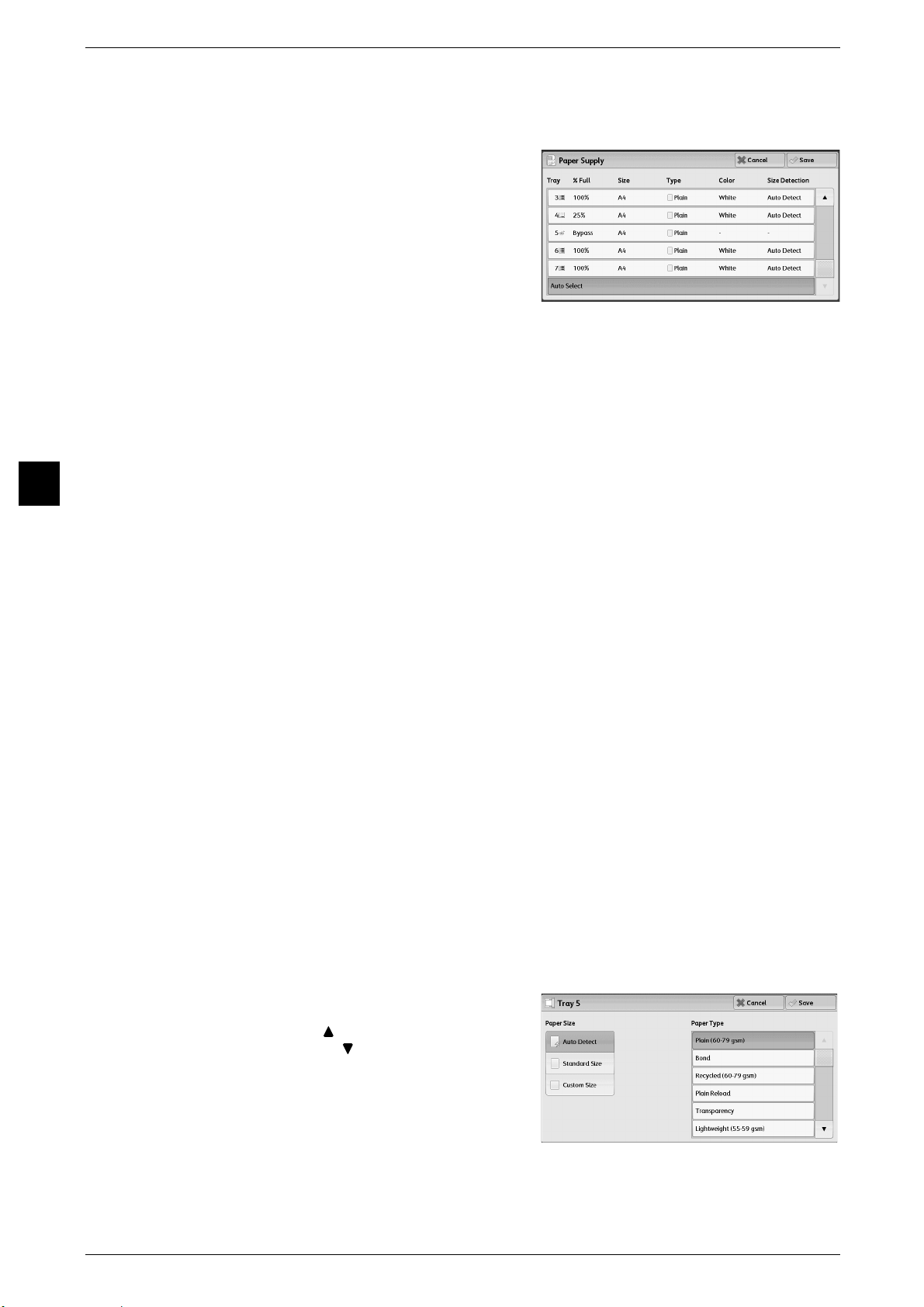
3 Copy
[Paper Supply] Screen
1 Select a paper tray.
Tray
Copy
This screen allows you to select a paper tray from all trays available on the machine.
Allows you to select a paper tray. When [Bypass] is selected, the [Tray 5] screen is
displayed where you can specify a paper type other than plain paper, and non-standard
size paper.
Note • Trays 6 and 7 are optional.
For more information, refer to "[Tray 5] Screen" (P.74).
3
[Tray 5] Screen
% Full
Displays the remaining amounts of paper loaded in trays.
Size
Displays paper sizes.
Type
Displays paper types.
Color
Displays paper colors.
For information on how to set [Paper Color], refer to "5 Tools" > "Common Service Settings" > "Paper
Tray Settings" > "Paper Tray Attributes" in the Administrator Guide.
Size Detection
Displays how the machine detects a paper size.
For information on how to set [Size Detection], refer to "5 Tools" > "Common Service Settings" >
"Other Settings" > "Paper Size Settings" in the Administrator Guide.
Set the paper loaded in Tray 5.
For information on paper that can be loaded in Tray 5, refer to "2 Paper and Other Media" > "Paper
Types" in the Administrator Guide.
74
1 Select a paper size and a paper type.
Note • Select [ ] to return to the previous
screen or [ ] to move to the next screen.
• [Auto Detect] is available only when
standard sized paper is loaded.
Page 75
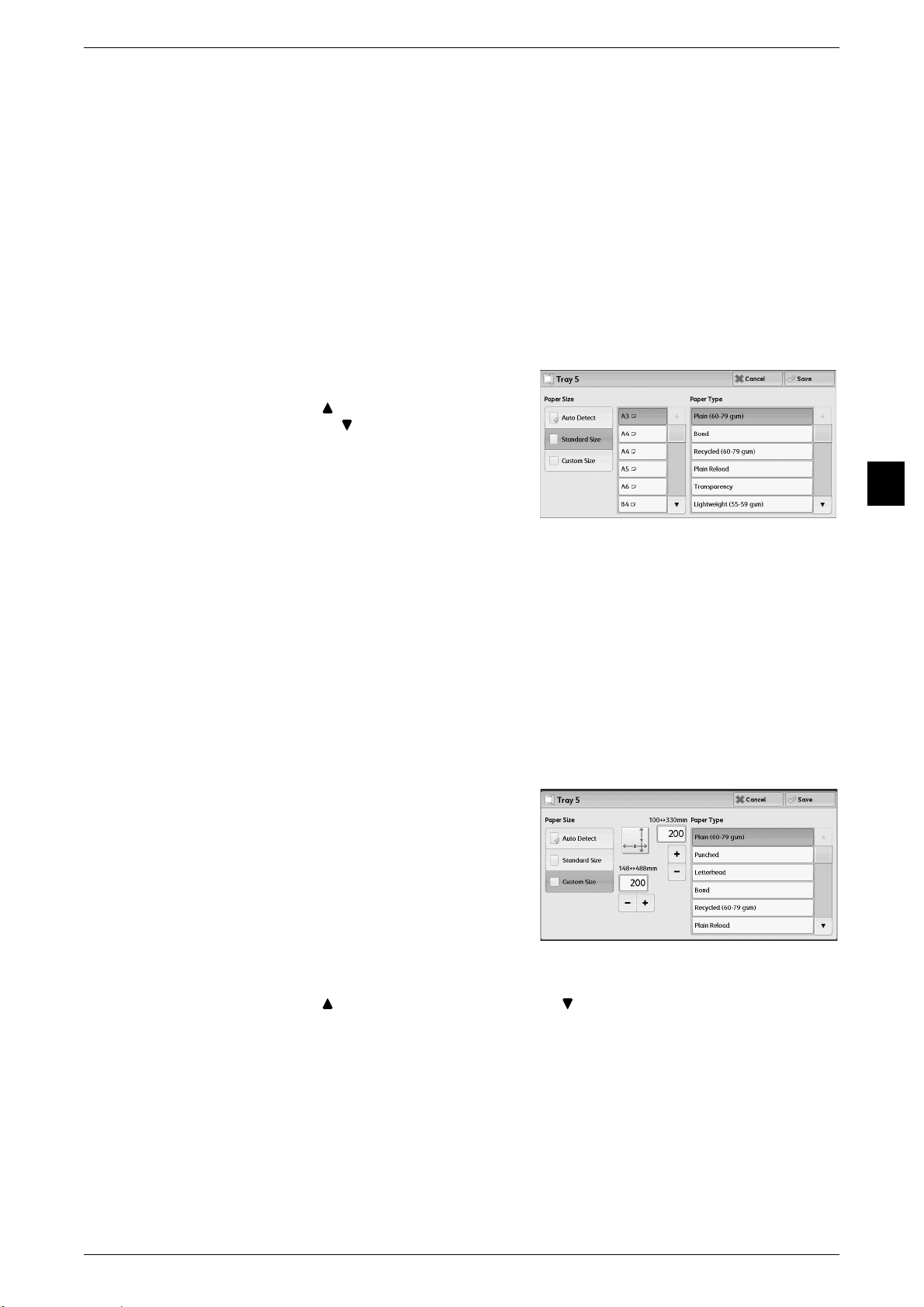
Paper Size
Select from [Auto Detect], [Standard Size], and [Custom Size].
When you select [Auto Detect], the paper size is identified automatically.
When you select [Standard Size] or [Custom Size], refer to "When [Standard Size] is Selected" (P.75) or
"When [Custom Size] is Selected" (P.75), respectively.
Paper Type
Select a paper type.
When [Standard Size] is Selected
Select [Standard Size], and from the lists displayed, select a paper size and then a
paper type.
1 Select a paper size and a paper type.
Copy
Note • Select [ ] to return to the previous
screen or [ ] to move to the next screen.
When [Custom Size] is Selected
Enter the width and length of the original document on the fields displayed after
selecting [Custom Size].
Specify the X (width) in the range from 148 to 488 mm, and the Y (length) in the range
from 100 to 330 mm in 1 mm increments.
Important • If the X (width) of non-standard size paper is less than 140 mm, documents may not be
copied properly.
• When copying on both sides of non-standard size paper, specify the size in the range from
140 to 483 mm for the X (width) direction and from 128 to 320 mm for the Y (length)
direction.
1 Enter a paper size using [+] and [-] or the
numeric keypad.
Copy
3
2 Select a paper type.
Note • Select [ ] to return to the previous screen or [ ] to move to the next screen.
75
Page 76

3 Copy
Output Color (Selecting the Color for Copying)
This feature allows you to select copy colors.
Note • If the use of certain colors is not allowed, the available colors will be restricted. For more
information, refer to "5 Tools" > "Accounting" > "Create/View User Accounts" > "Account
Limit" in the Administrator Guide.
1 Select a color mode.
Copy
3
Auto Detect
The machine automatically determines the colors of the original document and makes
copies in full color if the original document is colored, and in single color (black) if the
document is black-and-white.
Note • If a color document is in one of the following conditions, the machine may copy the
document in black and white.
• The colored area is too small.
• The colors are too light.
In that case, change a level from the five levels which is used for the machine to
recognize color. For more information, refer to "5 Tools" > "Common Service Settings" >
"Image Quality Adjustment" > "Image Quality" > "Output Color Recognition" in the
Administrator Guide.
Color
Copies in full color.
Black & White
Copies in black and white regardless of the colors in the original document.
Dual Color Red/Black
Copies color documents using two colors.
You can change the two colors. For more information, refer to "5 Tools" > "Copy Service Settings" >
"Copy Defaults" > "Dual Color - Target Area Color" and "Dual Color - Non-target Area Color" in the
Administrator Guide.
76
Single Color Red
Copies in one specified color regardless of the colors in the original document.
You can change the red color to another one on the screen displayed after selecting [More] > [Single
Color] > [Color]. For more information, refer to "5 Tools" > "Copy Service Setting" > "Copy Defaults"
> "Single Color" in the Administrator Guide.
More
Displays the [Output Color] screen. You can set colors in the [Output Color] screen.
For more information, refer to "[Output Color] Screen" (P.77).
Page 77

[Output Color] Screen
This screen allows you to make settings for full color, dual color, and single color.
1 Select [More].
2 Select the desired output color mode.
Copy
Copy
Auto Detect
Automatically determines the color of the original document and makes copies in full
color if the original document is colored, or in single color (black) if the document is
black-and-white.
Color
Copies in full color using all the four colors of toner: yellow, magenta, cyan, and black.
Black & White
Copies in black and white regardless of the colors in the original document.
Dual Color
Separates the colors of your document into the source colors and the other colors, and
then copies the document using two colors. Selecting [Dual Color] allows you to set the
following:
z
Source Color
Displays the [Source Color] screen on which you can select one or more colors from
your document to define them as source colors.
Refer to "[Source Color] Screen" (P.78).
z
Target Area Color
3
Displays the [Target Area Color] screen on which you can select the target color to
be used in place of the selected source colors.
Refer to "[Target Area Color] Screen" (P.78).
z
Non-target Area Color
Displays the [Non-target Area Color] screen on which you can select the color to be
used in place of the colors other than the selected source colors.
Refer to "[Non-target Area Color] Screen" (P.79).
77
Page 78
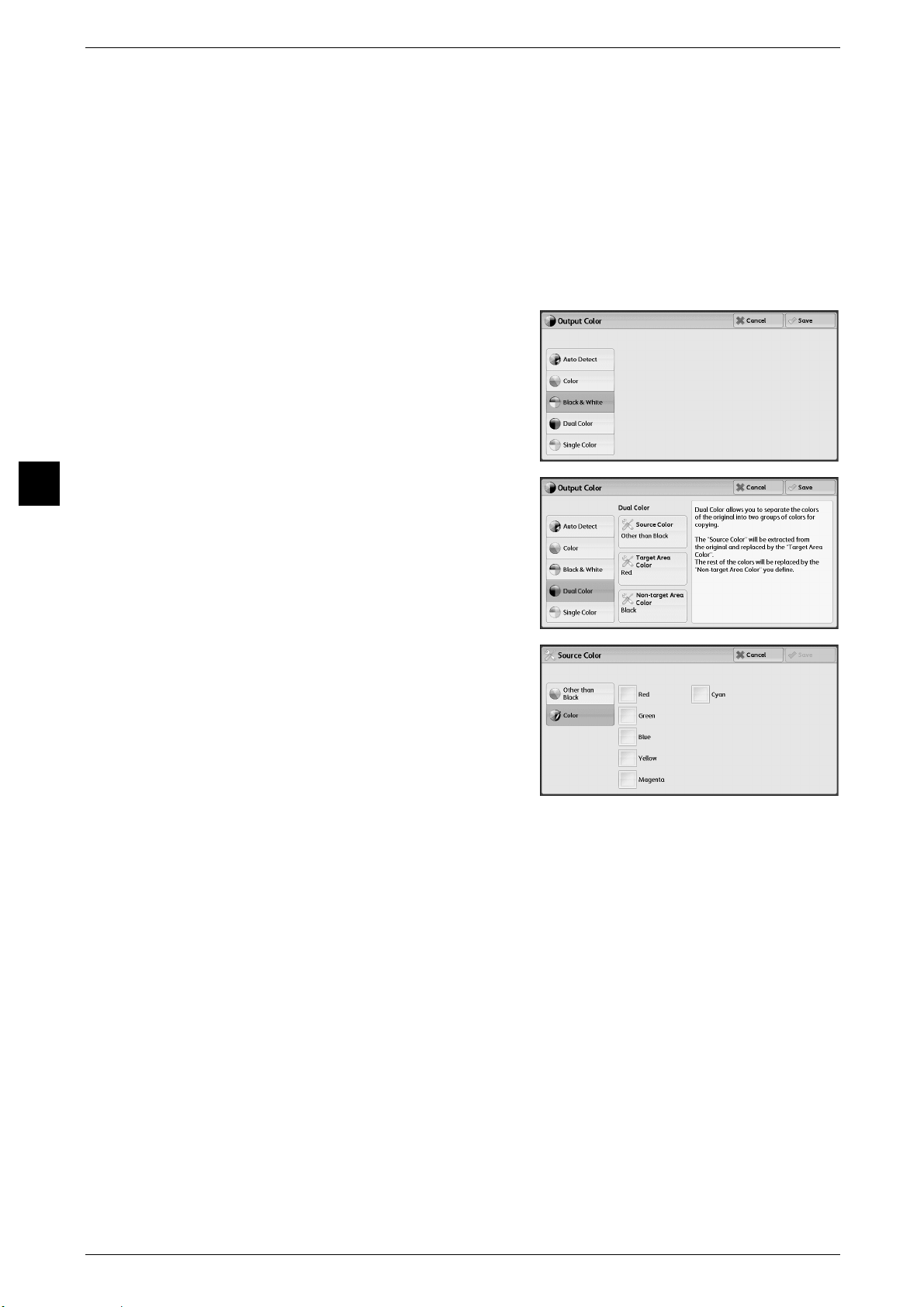
3 Copy
Single Color
[Source Color] Screen
1 Select [Dual Color].
Copy
Copies in one specified color regardless of the color of the document.
Selecting this option displays [Color] on the screen. Select a color on the [Output Color
- Color] screen which is displayed after selecting [Color].
Refer to "[Output Color - Color] Screen" (P.80).
This screen allows you to select one or more colors from your document to define them
as source colors.
3
2 Select [Source Color].
3 Select [Other than Black] or [Color].
Other than Black
The colors other than black will be the source colors.
Color
Allows you to select one or more source colors from six preset options.
[Target Area Color] Screen
This screen allows you to select the target color to be used in place of the source colors
specified in [Source Color]. You can select one color from seven preset and six custom
options.
For information on how to set custom colors, refer to "5 Tools" > "Copy Service Settings" > "Custom
Colors" in the Administrator Guide.
78
Page 79
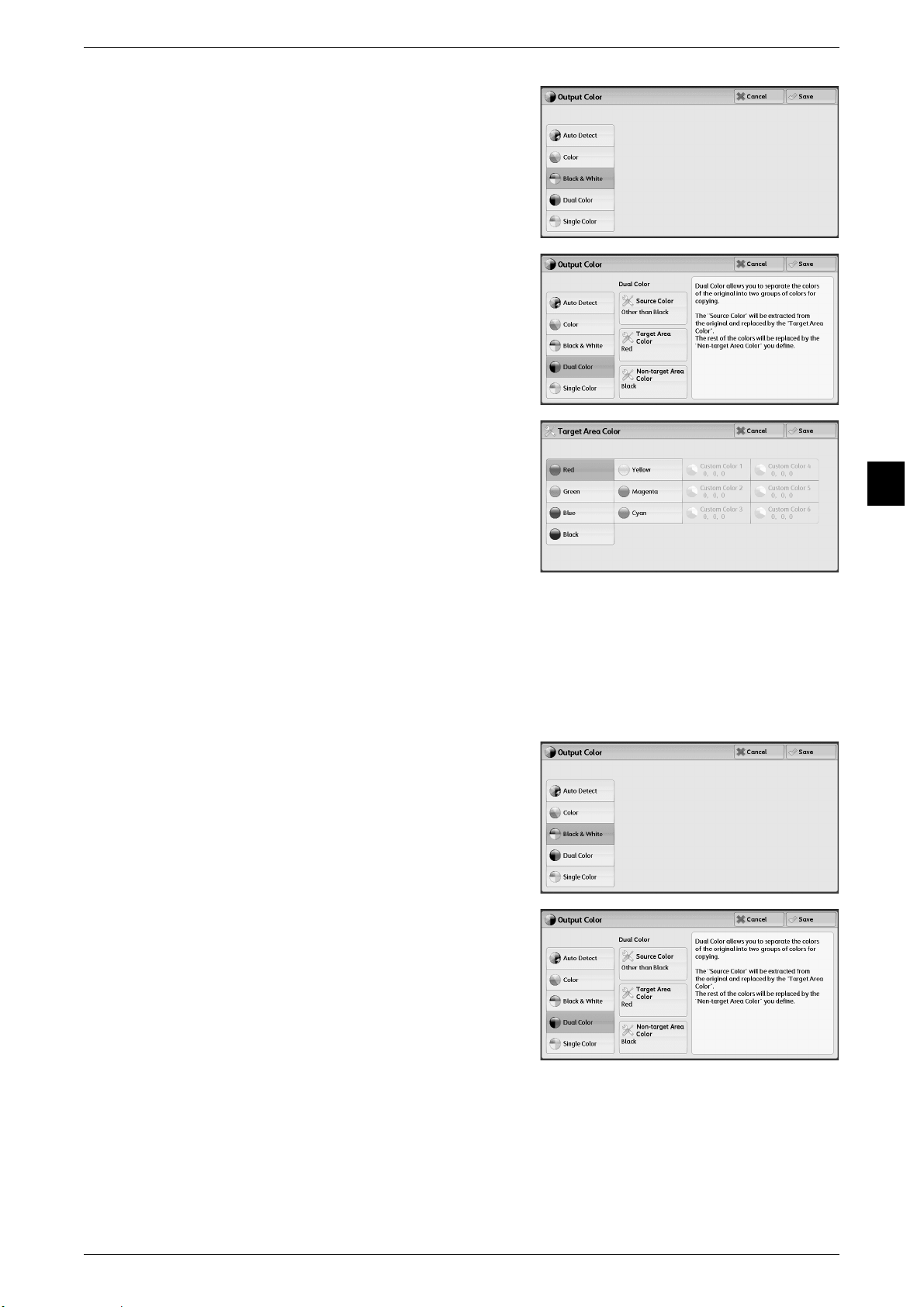
1 Select [Dual Color].
2 Select [Target Area Color].
3 Select any color.
Copy
Copy
[Non-target Area Color] Screen
This screen allows you to select the color to be used in place of the colors other than
the selected source colors. You can select one color from seven preset and six custom
options.
For information on how to set custom colors, refer to "5 Tools" > "Copy Service Settings" > "Custom
Colors" in the Administrator Guide.
1 Select [Dual Color].
2 Select [Non-target Area Color].
3
79
Page 80
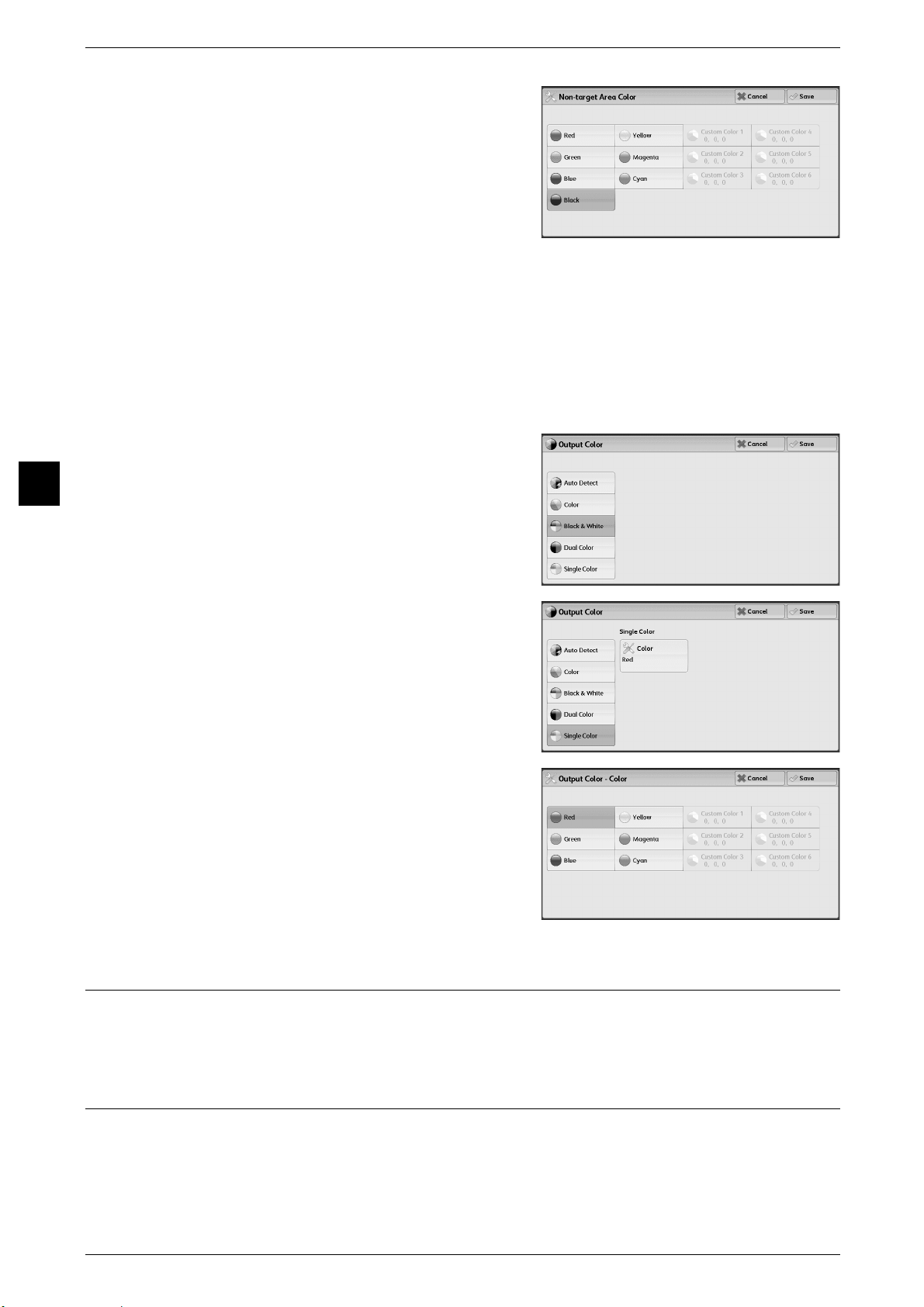
3 Copy
3 Select any color.
[Output Color - Color] Screen
This screen allows you to specify the color to be used for single-color copying
regardless of the colors in the original document.
You can select one color from six preset and six custom options for [Single Color].
Select a single color listed in the displayed [Output Color -Color] screen.
For information on how to set custom colors, refer to "5 Tools" > "Copy Service Settings" > "Custom
Copy
Colors" in the Administrator Guide.
1 Select [Single Color].
3
2 Select [Color].
3 Select any color.
2 Sided Copying (Making 2 Sided Copies)
This feature is the same as [2 Sided Copying] on the [Layout Adjustment] screen. For more information,
refer to "2 Sided Copying (Making 2 Sided Copies)" (P.92).
Copy Output (Specifying Finishing Options)
This feature is the same as [Copy Output] on the [Output Format] screen. For more information, refer to
"Copy Output (Specifying Finishing Options)" (P.129).
80
Page 81
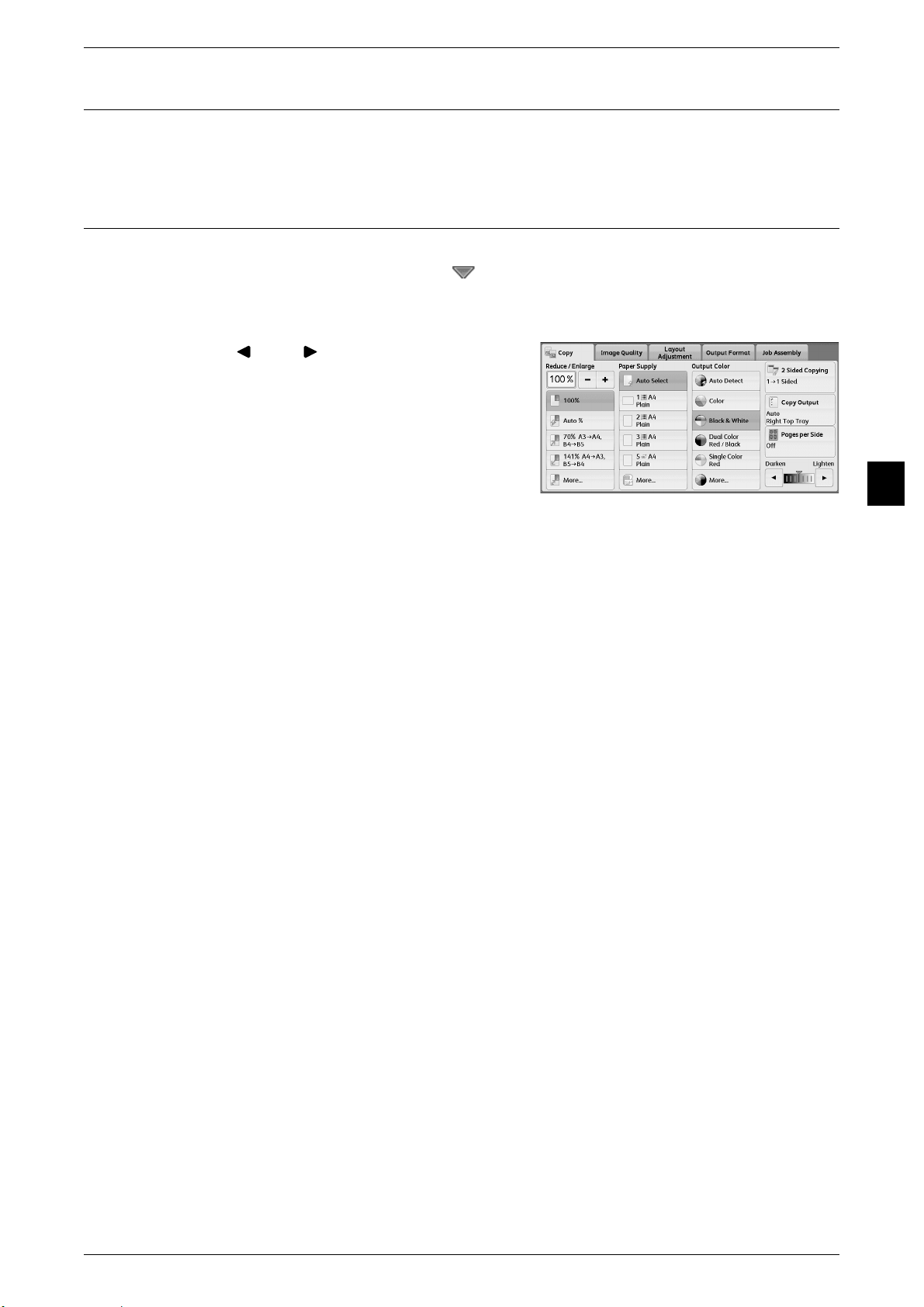
Pages per Side (Copying Multiple Pages onto One Sheet)
This feature is the same as [Pages per Side] on the [Output Format] screen. For more information, refer
to "Pages per Side (Copying Multiple Pages onto One Sheet)" (P.111).
Lighten/Darken (Adjusting the Copy Density)
This feature allows you to select a copy-density level from seven levels. The copy
becomes darker when you move [ ] to the left, and lighter when you move it to the
right.
Note • [Lighten/Darken] on the [Copy], [Image Quality] and [Simple Copy] screens is the same.
1 Use [ ] and [ ] to select from seven
density levels.
Copy
Copy
3
81
Page 82
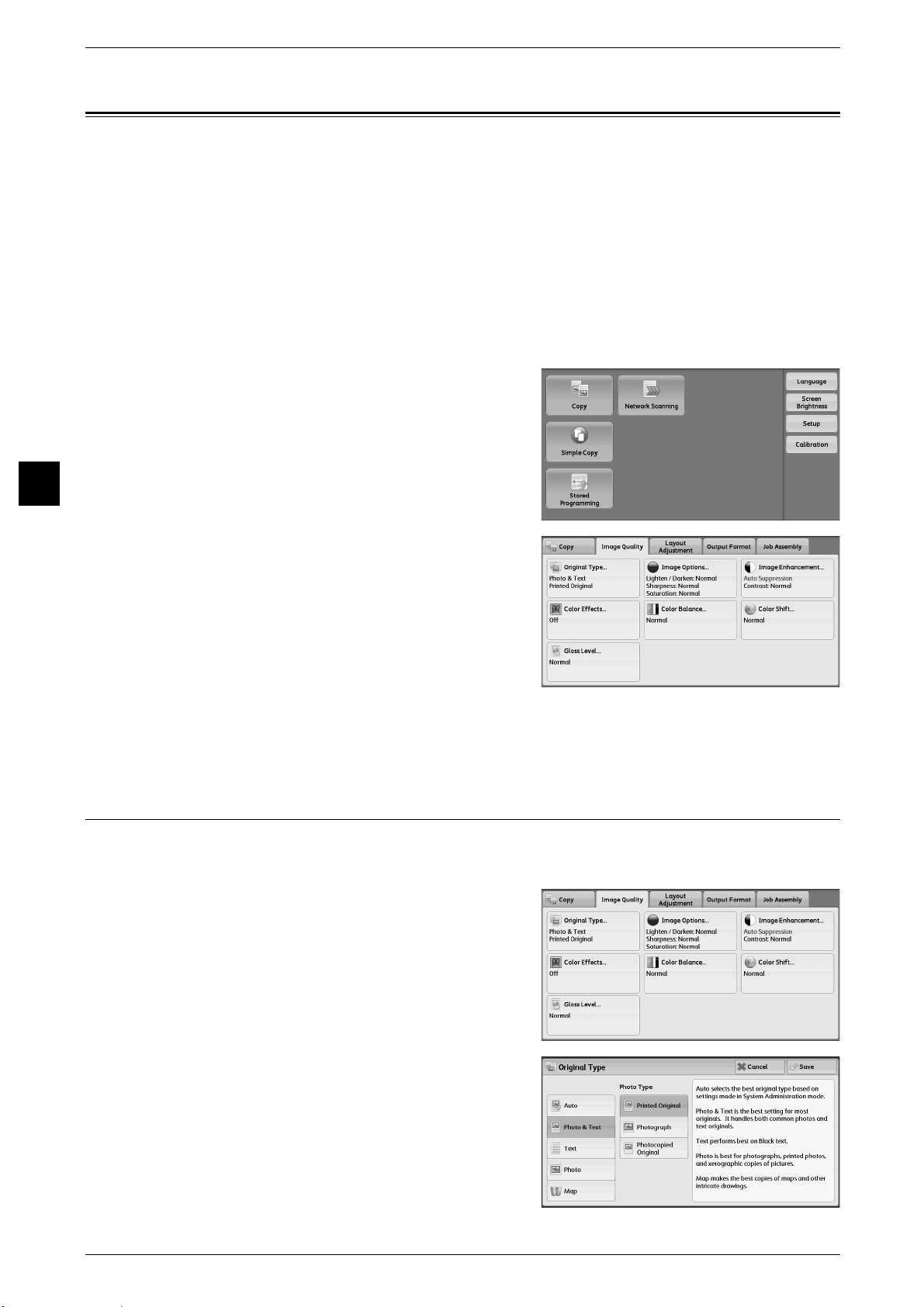
3 Copy
Image Quality
Copy
The section describes the features you can select on the [Image Quality] screen. The
following shows the reference section for each feature.
Original Type (Selecting the Document Type)...........................................................................82
Image Options (Adjusting Copy Density/Sharpness/Saturation of Images)...............................84
Image Enhancement (Erasing the Background Color of Documents/Adjusting Contrast) ........85
Color Effects (Selecting an Image Quality)................................................................................86
Color Balance (Adjusting Color Balance)..................................................................................87
Color Shift (Adjusting the Color Tone)......................................................................................88
Gloss Level (Enhancing Gloss of the Document).......................................................................89
1 Select [Copy] on the [Services Home]
screen.
3
2 Select a feature on the [Image Quality]
screen.
Note • If the color reproduction is unsatisfactory, perform calibration. For information on calibration,
refer to "3 Maintenance" > "Executing Calibration" in the Administrator Guide.
Original Type (Selecting the Document Type)
This feature allows you to select the type of documents, such as text and photos. By
selecting a document type, you can make copies at optimum image quality.
1 Select [Original Type].
82
2 Select any option.
Page 83

Image Quality
Auto
Automatically sets the document type based on the setting made in the System
Administration mode and the setting made in [Output Color] on the [Copy] screen.
Photo & Text
Select this option when the document contains both text and photos. The machine
automatically distinguishes the text and photo areas of the document and sets the
appropriate image quality for each area. To process photo areas, select the photo type
from [Printed Original], [Photograph], and [Photocopied Original].
z
Printed Original
Select this option when the document contains printed photos, such as a brochure.
z
Photograph
Select this option when the document contains pasted photos. This option prevents
the copy from being reproduced bluish.
z
Photocopied Original
Select this option when the document is a copy or print made with a color copier such
as this machine. This option prevents the copy from being reproduced faintly.
Text
Copy
3
Select this option to copy text areas of the document sharply. This option is suitable for
graphs and illustrations.
z
Normal Text
Select this option for printed documents, or for documents written with ink.
z
Light Text
Select this option for text that requires enhancement, such as handwritten pencil text.
z
Text on See-Through Paper
Select this option to reduce blurs of tracing-paper documents or to suppress
background shadows of lightweight documents.
[See-Through Paper] may not be displayed depending on the setting in the System Administration
mode. For information on how to display [See-Through Paper], refer to "5 Tools" > "Copy Service
Settings" > "Copy Control" > "Original Type - See-Through Paper" in the Administrator Guide.
Photo
Select this option to make copies of photos. Select the photo type from the same
options as [Photo & Text]: [Printed Original], [Photograph], and [Photocopied Original].
Map
Select this option to make copies of documents that have text placed on color
backgrounds, such as maps.
83
Page 84

3 Copy
Image Options (Adjusting Copy Density/Sharpness/Saturation of Images)
This feature allows you to adjust the copy density, sharpness, and saturation levels.
Note • [Lighten/Darken] under [Image Options] is the same as [Lighten/Darken] on the [Copy]
screen.
• If [Lighten/Darken], [Sharpness], or [Saturation] is set concurrently with [Color Effects], the
setting made in [Color Effects] will be cleared.
1 Select [Image Options].
Copy
3
2 Adjust options.
Lighten/Darken
Allows you to select from seven copy density levels between [Lighten] and [Darken].
Selecting an upper cell on the bar makes the copy density lighter, and selecting a lower
cell makes darker.
Sharpness
Allows you to select from five sharpness levels between [Sharpen] and [Soften].
Selecting an upper cell on the bar makes the contours of images sharper, and selecting
a lower cell makes softer.
Saturation
Allows you to select from five saturation levels between [Vivid] and [Pastel].
84
Selecting an upper cell on the bar makes colors brighter, and selecting a lower cell
makes less bright.
Page 85
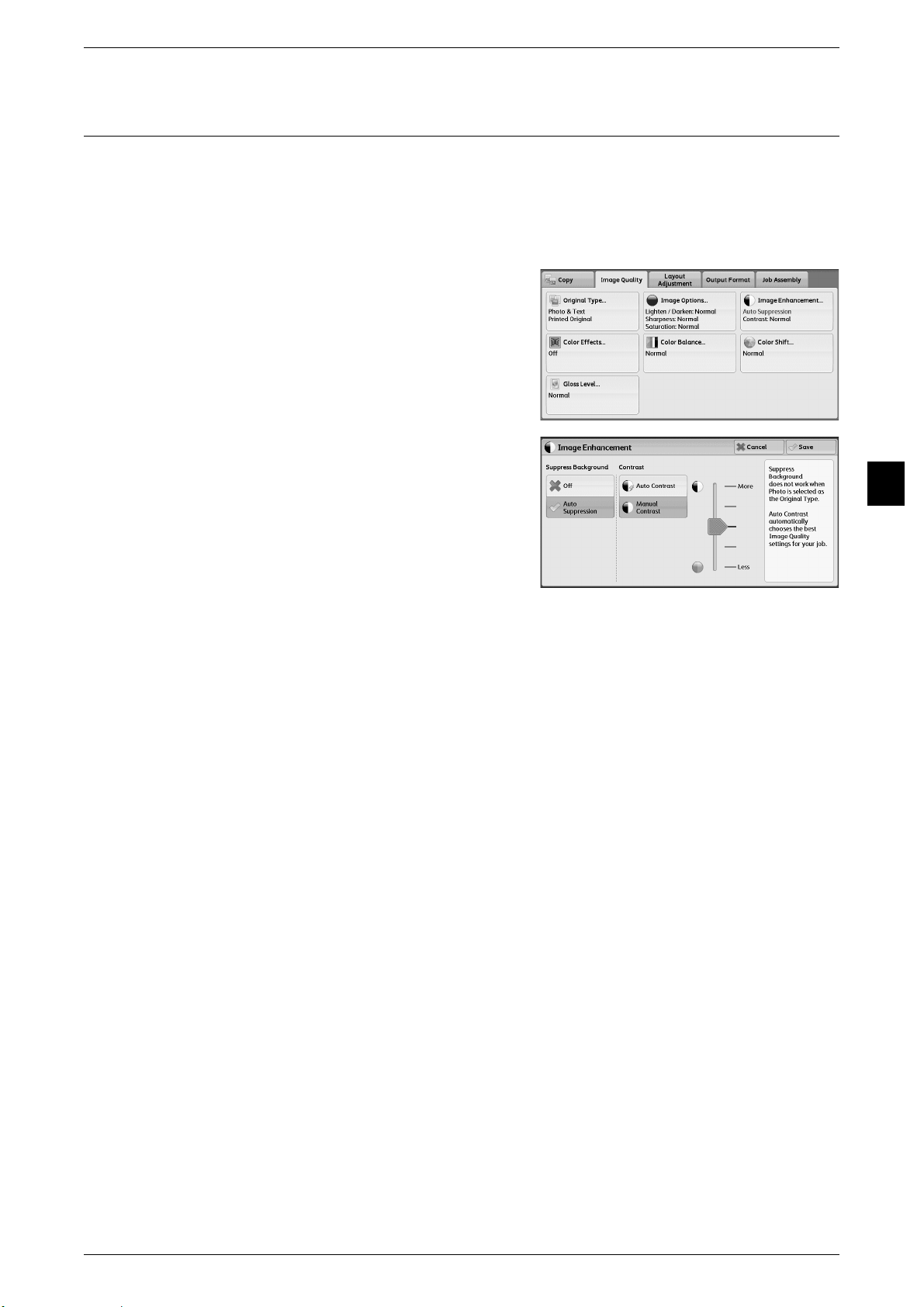
Image Quality
Image Enhancement (Erasing the Background Color of Documents/ Adjusting Contrast)
This feature allows you to suppress the background color of documents, such as
newspaper and colored paper. You can also adjust the contrast.
Note • [Image Enhancement] is not available when [Original Type] is set to [Photo].
• If [Suppress Background] or [Contrast] is set concurrently with [Color Effects], the setting
made in [Color Effects] will be cleared.
1 Select [Image Enhancement].
2 Set [Suppress Background] and [Contrast].
Copy
Suppress Background
z
Off
Scans document backgrounds with no filtering.
z
Auto Suppression
When [Output Color] is set to [Black & White], the background of a document printed
on colored paper, such as newspaper, will be suppressed.
When [Output Color] is set to [Color], [Dual Color], or [Single Color], the background
of a document printed on white-color paper will be suppressed.
Note • When [Output Color] is set to [Color], you can change the level of background suppression.
For more information, refer to "5 Tools" > "Copy Service Settings" > "Copy Control" >
"Background Suppression (Photo & Text)" and "Background Suppression Level (Text)" in
the Administrator Guide.
Contrast
z
Auto Contrast
3
Automatically adjusts the brightness and hue of the original document to sharpen the
image.
Note • [Auto Contrast] is not available when you use the document feeder.
z
Manual Contrast
Allows you to select from the five levels between [More] and [Less].
Selecting an upper cell on the bar makes the difference between light and dark areas
greater; light areas become lighter and dark areas darker. In contrast, selecting a
lower cell on the bar makes the difference between light and dark areas smaller.
85
Page 86
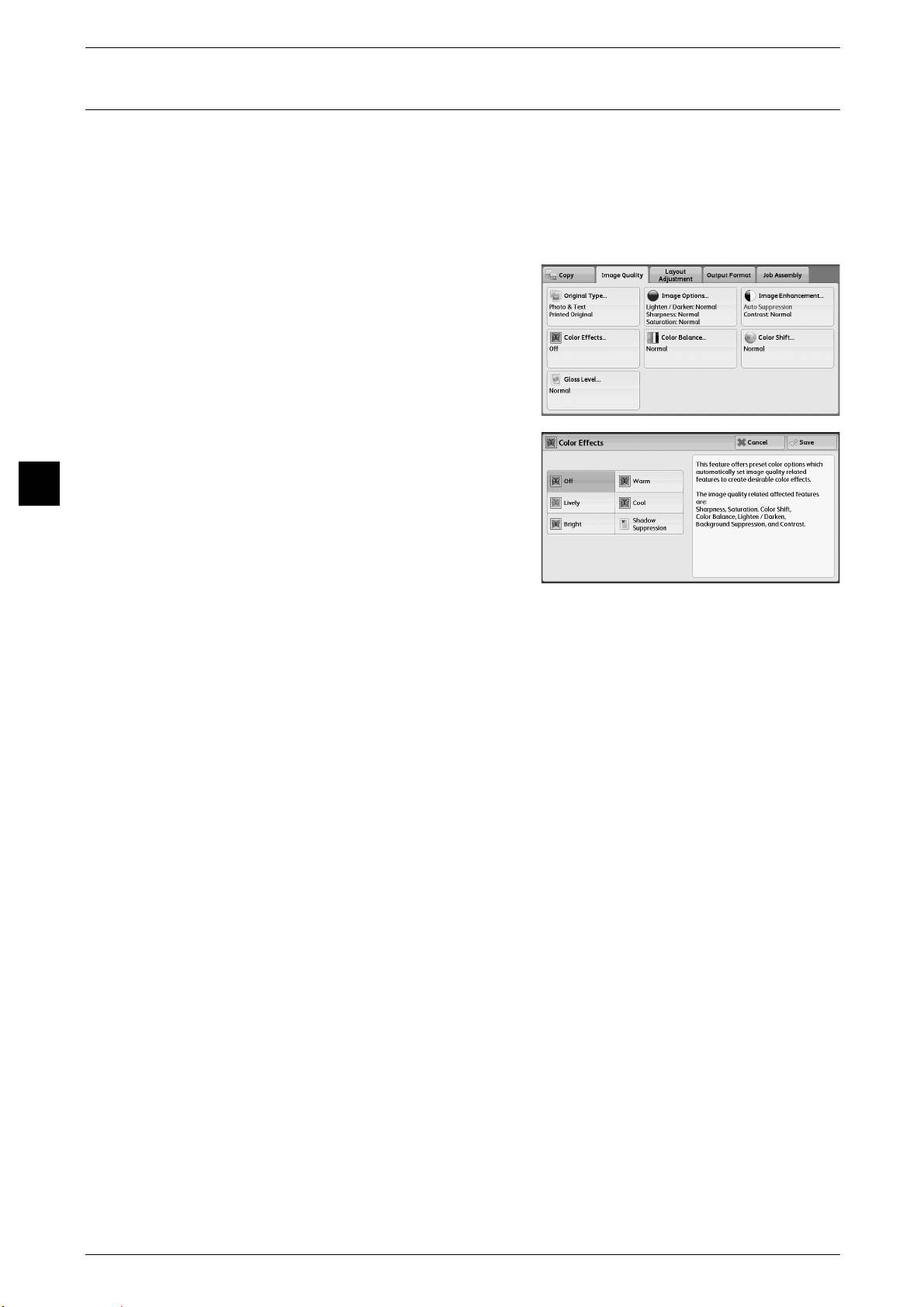
3 Copy
Color Effects (Selecting an Image Quality)
If you set this feature, the [Image Enhancement], [Image Options], [Color Shift], and
[Color Balance] settings are automatically adjusted and copies are made at the
specified quality.
Important • When the Color Effects feature is used, [Auto Contrast] is not available.
Note • If other image-quality settings are made after you set [Color Effects], the setting made in
[Color Effects] will be cleared.
1 Select [Color Effects].
Copy
2 Select any option.
3
Off
Copies with the [Image Enhancement], [Image Options], [Color Shift], and [Color
Balance] settings at their defaults.
Lively
Reproduces fresher, livelier images with increased color saturation.
Bright
Reproduces brighter images with enhanced contrast. This option is suitable for
documents that are intended to attract people's attention, such as posters.
Warm
Reproduces brighter, warmer, more reddish images. This option is suitable when skin
tones are to be reproduced more pinkish or when subdued images are to be
reproduced more warmly.
86
Cool
Reproduces clearer blue colors. This option is suitable for water and sky images, and
is also suitable when smoky blue colors are to be reproduced more clearly.
Shadow Suppression
Suppresses the colors on the reverse side of the original document from being
reproduced in the copy.
Page 87
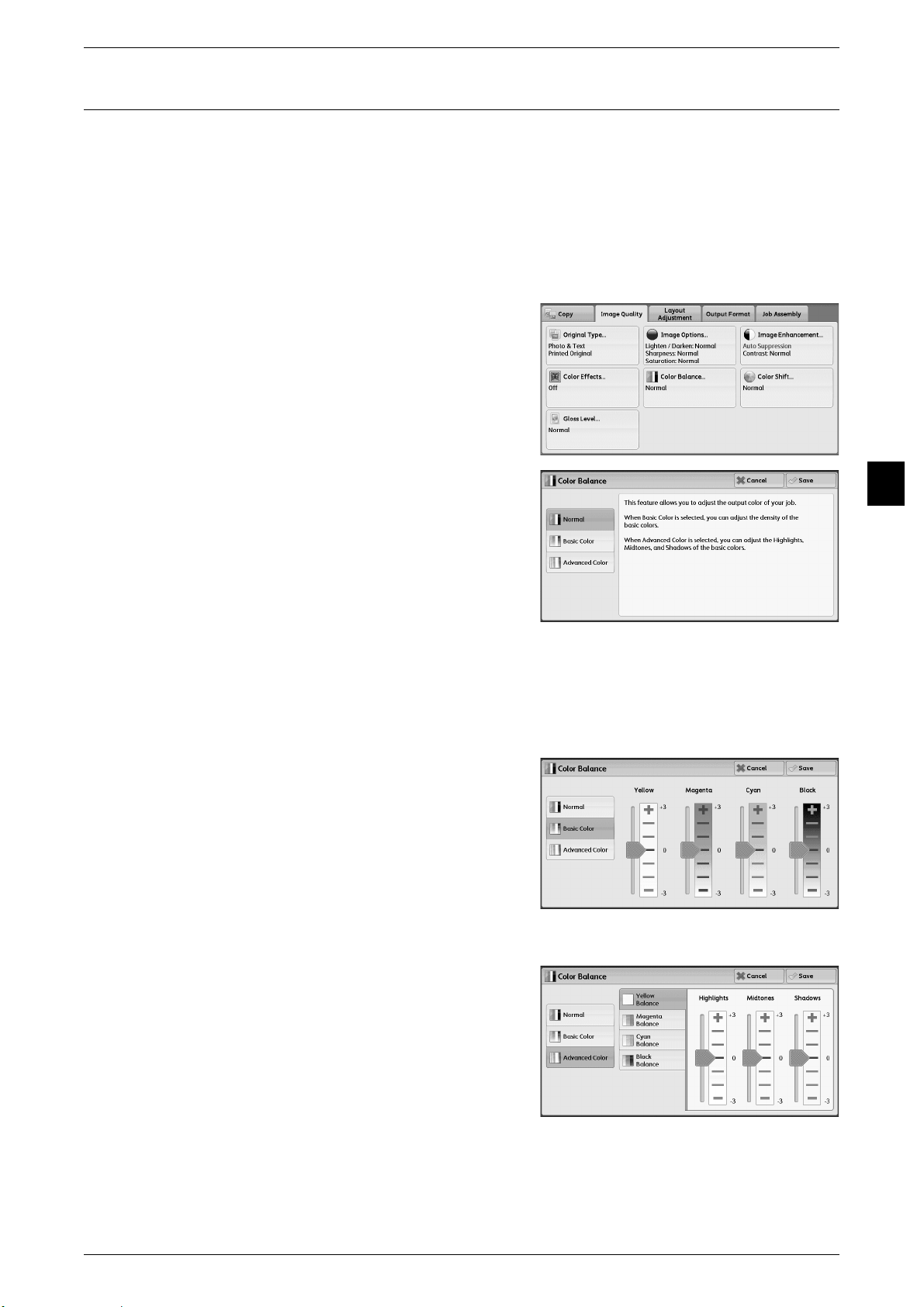
Color Balance (Adjusting Color Balance)
This feature allows you to adjust the color balance of the four CMYK toner colors (cyan,
magenta, yellow and black). You can select from seven levels for each density level:
Highlights, Midtones, and Shadows.
The Color Balance feature finely adjusts the density level for each toner color to finetune the color balance, such as a reddish or bluish tint, while the Lighten/Darken
feature adjusts the overall density level of the four colors.
Note • If [Color Balance] is set concurrently with [Color Effects], the setting made in [Color Effects]
will be cleared.
1 Select [Color Balance].
Image Quality
Copy
2 Select any option.
Normal
Always copies a document with the density balance set to "0" for the four toner colors:
yellow, magenta, cyan, and black.
Basic Color
Allows you to adjust the density level for each
toner color: yellow, magenta, cyan, black.
3
Advanced Color
Allows you to adjust the density level for each
toner color (yellow, magenta, cyan, black)
which is divided to [Highlights], [Midtones],
and [Shadows].
87
Page 88
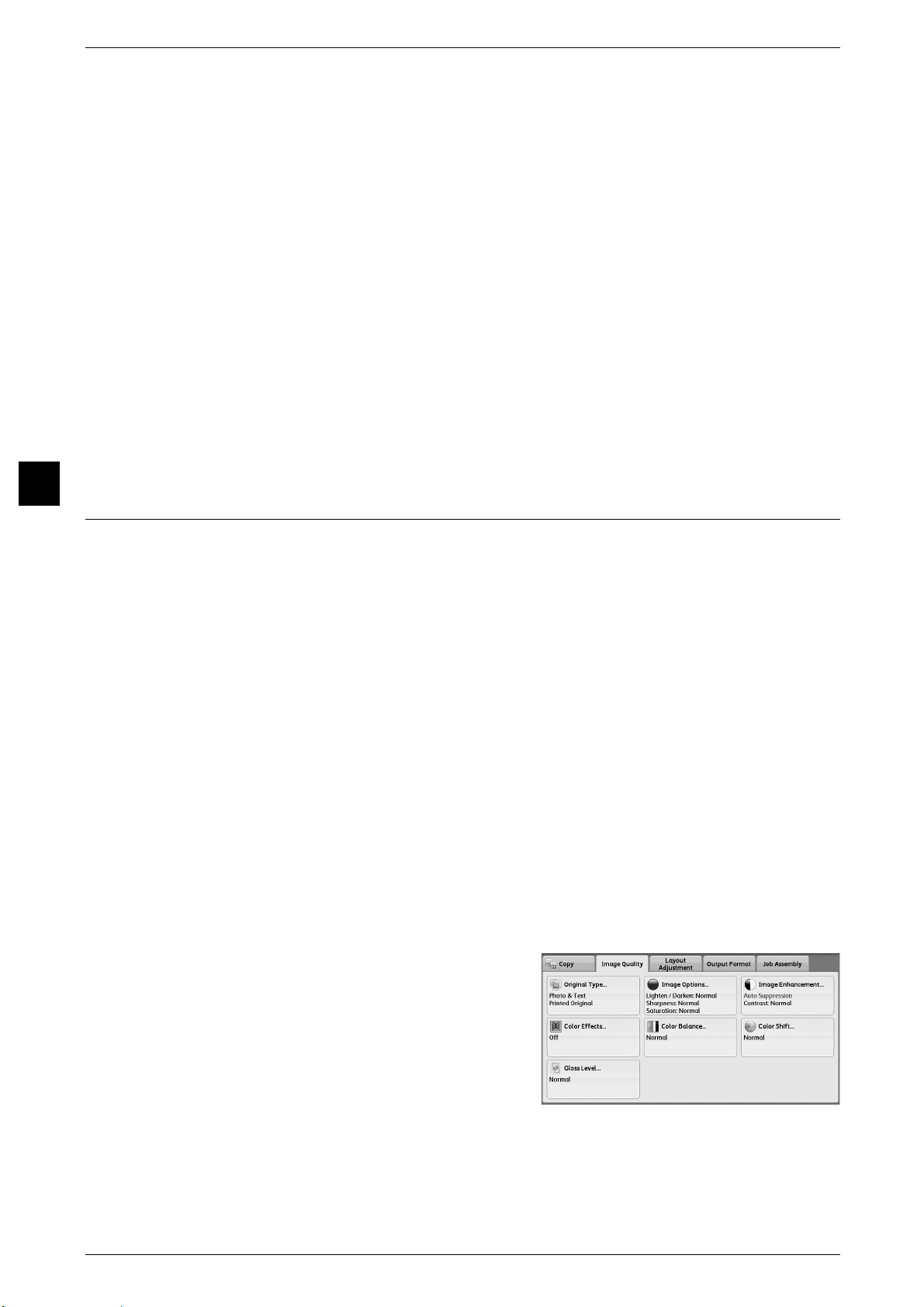
3 Copy
Highlights
Allows you to adjust the color strength of low-density areas.
Example:
If low-density yellow is printed darker, adjust the color strength in the minus (-) direction
under [Yellow Balance] > [Highlights].
Midtones
Allows you to adjust the color strength of medium-density areas.
Example:
If medium-density yellow is printed lighter, adjust the color strength in the plus (+)
direction under [Yellow Balance] > [Midtones].
Shadows
Allows you to adjust the color strength of high-density areas.
Copy
Example:
If high-density yellow is printed lighter, adjust the color strength in the plus (+) direction
under [Yellow Balance] > [Shadows].
3
Color Shift (Adjusting the Color Tone)
This feature allows you to adjust the tone of the colors to be reproduced in copies, by
a maximum of two levels in two directions.
On the screen, the [Original Color] slider represents the color tone of the original
document, and the [Copy Color] slider represents the color tone of output copies.
Selecting a button on the screen moves the [Original Color] slider to adjust the tone of
the colors.
When the [Original Color] slider is moved to the left, the Y (yellow) cell on the [Original
Color] slider becomes closer to the R (red) cell on the [Copy Color] slider, and thus a
yellow fruit appears more reddish and riper-looking. At the same time, the tone of all
the other colors changes. The red color appears more magentish, and the green color
appears more yellowish.
Conversely, when the [Original Color] slider is moved to the right, the Y (yellow) cell on
the [Original Color] slider becomes closer to the G (green) cell on the [Copy Color]
slider, and thus a yellow fruit appears more greenish. At the same time, the tone of all
the other colors changes. The magenta color appears more reddish, and the red color
appears more yellowish.
Note • Ensure that [Output Color] is set to [Color] on the [Copy] screen. [Color Shift] is not available
when [Output Color] is set to [Black & White].
• If [Color Shift] is set concurrently with [Color Effects], the setting made in [Color Effects] will
be cleared.
88
1 Select [Color Shift].
Page 89

2 Select a button to adjust the color tone.
Gloss Level (Enhancing Gloss of the Document)
This feature allows you to change gloss level of an output by lowering speed.
The following paper types are available for this feature:
Image Quality
z
Plain (80 - 90 gsm)
z
Recycled (80 - 90 gsm)
z
Plain Reload (80 - 90 gsm)
z
Punched (80 - 90 gsm)
z
Heavyweight (HW) (106 - 128 gsm)
z
Heavyweight (HW) (151 - 176 gsm)
z
HW Reload (129 - 150 gsm)
z
Extra-HW (X-HW) (177 - 220 gsm)
z
X-HW Plus (X-HW) (221 - 256 gsm)
z
X-HW Plus (X-HW) 2 (257 - 300 gsm)
z
Hole Punched HW 1 (106 - 128 gsm)
z
Hole Punched HW 1 (151 - 176 gsm)
z
Hole Punched HW 2 (177 - 220 gsm)
z
Hole Punched HW 4 (257 - 300 gsm)
z
Plain (91 - 105 gsm)
z
Recycled (91 - 105 gsm)
z
Plain Reload (91 - 105 gsm)
z
Punched (91 - 105 gsm)
z
Heavyweight (HW) (129 - 150 gsm)
z
HW Reload (106 - 128 gsm)
z
HW Reload (151 - 176 gsm)
z
X-HW Reload (170 -220 gsm)
z
X-HW Plus Reload (221 - 256 gsm)
z
X-HW Plus 2 Reload (257 - 300 gsm)
z
Hole Punched HW 1 (129 -150 gsm)
z
Hole Punched HW 1 (177 - 220 gsm)
z
Hole Punched HW 3 (221 - 256 gsm)
Important • When using the Color 550 Printer, this feature is not available for paper with a weight that is
less than 105 gsm.
• The effect of this feature is not applied to Gloss (64 - 79 gsm), Recycled (64 - 79 gsm), Plain
Reload (64 -97 gsm), and Punched (64 - 79 gsm) although they are displayed as options.
• Setting by customer engineer is required to use this feature by selecting Gloss (106 - 128
gsm), Gloss Reload (106 - 128 gsm), Gloss (129 - 150 gsm), Gloss Reload (129 - 150 gsm),
HW Gloss (151 - 176 gsm), HW Gloss Reload (151 - 176 gsm), X-HW Gloss (221 - 256
gsm), X-HW Gloss Reload (221 - 256 gsm), and Postcard. To use these options, contact
your local Fuji Xerox representative.
• The effect of this feature is applied only when [Color] is selected in [Output Color].
Note • To display [Gloss Level] on the [Image Quality] screen, a prior setting is required in the
System Administration mode. For more information, refer to "5 Tools" > "Common Service
Settings" > "Other Settings" > "Gloss Level" in the Administrator Guide.
• When using the Build Job feature, you can independently specify the gloss level for each
copy set. In this case, the machine may suspend the copy job each time the machine adjusts
the settings. In addition, the copies are divided into chapters at the positions where the gloss
level changes.
Copy
3
89
Page 90
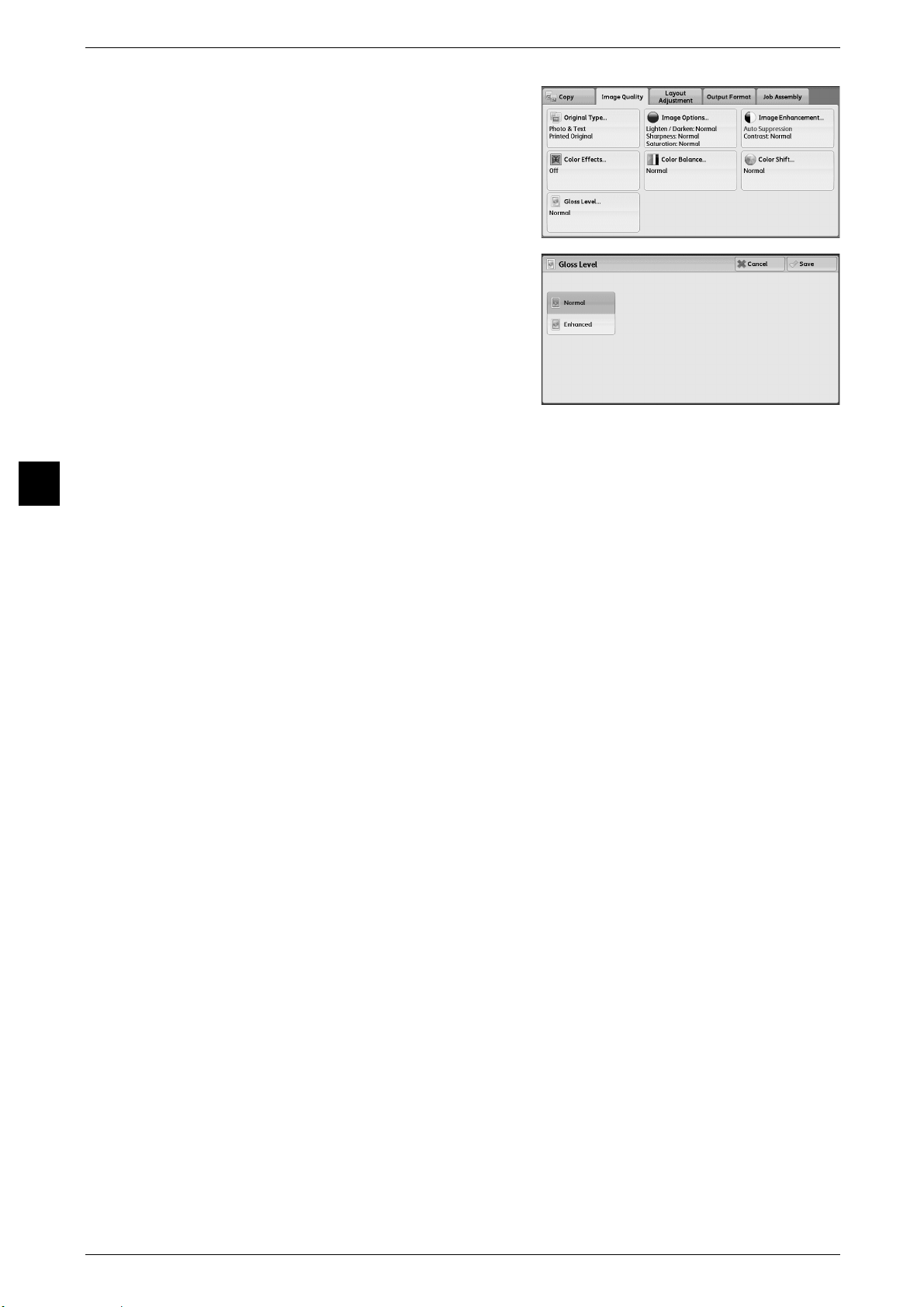
Copy
3 Copy
1 Select [Gloss Level].
2 Select [Normal] or [Enhanced].
3
90
Page 91
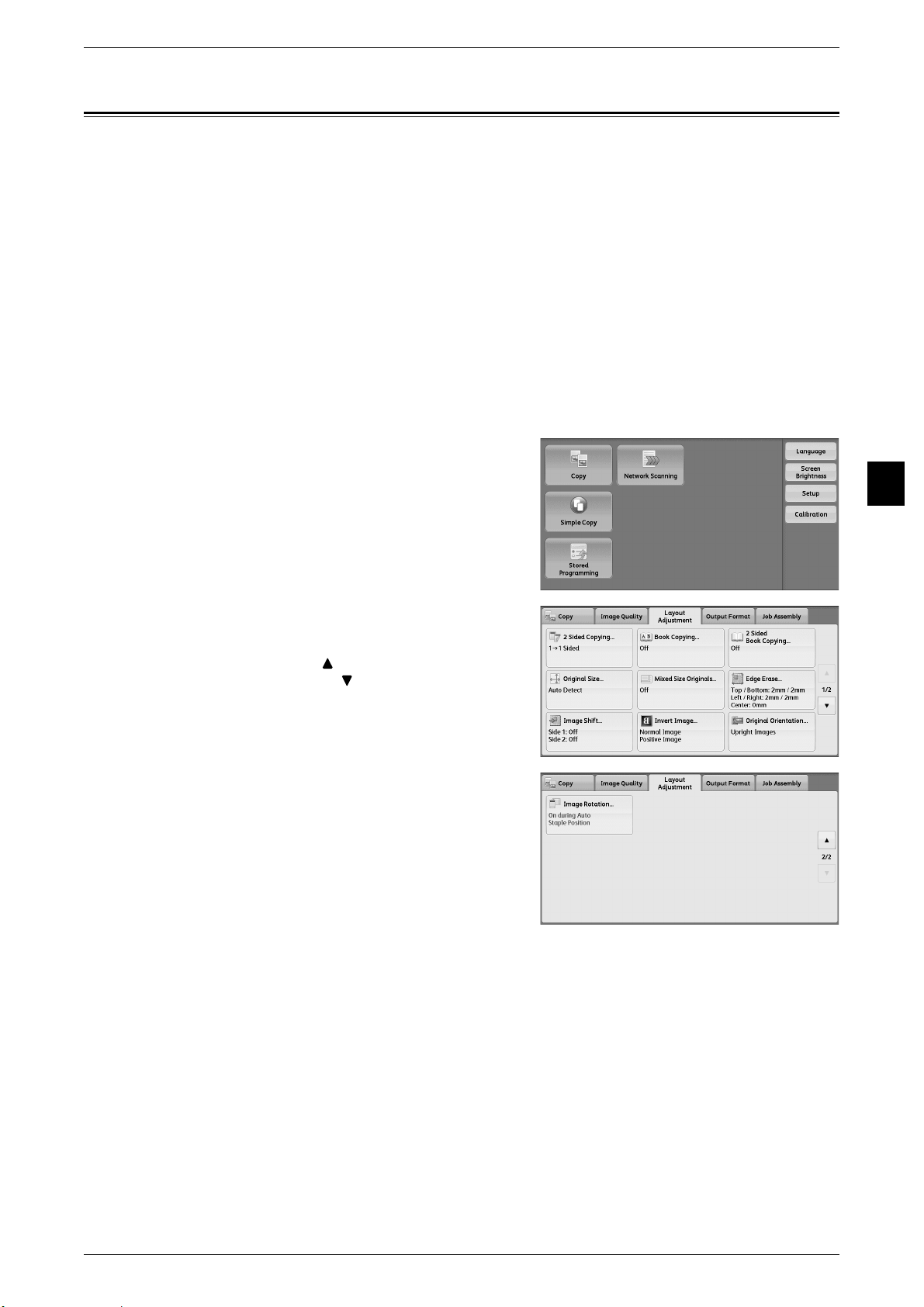
Layout Adjustment
This section describes the features you can select on the [Layout Adjustment] screen.
The following shows the reference section for each feature.
2 Sided Copying (Making 2 Sided Copies)................................................................................ 92
Book Copying (Copying Facing Pages onto Separate Sheets) .................................................. 93
2 Sided Book Copying (Making 2 Sided Copies of Facing Pages) ........................................... 95
Original Size (Specifying the Scan Size for the Document)...................................................... 96
Mixed Size Originals (Scanning Different Size Documents Simultaneously) .......................... 97
Edge Erase (Erasing Edges and Margin Shadows of the Document) ........................................ 98
Image Shift (Adjusting the Image Position)............................................................................. 100
Invert Image (Making Reversed Copies of Images) ................................................................ 102
Original Orientation (Specifying the Orientation of Loaded Documents)............................... 103
Image Rotation (Changing the Orientation of Images) ............................................................ 104
1 Select [Copy] on the [Services Home]
screen.
Layout Adjustment
Copy
3
2 Select a feature on the [Layout Adjustment]
screen.
Note • Select [ ] to return to the previous
screen or [ ] to move to the next screen.
91
Page 92
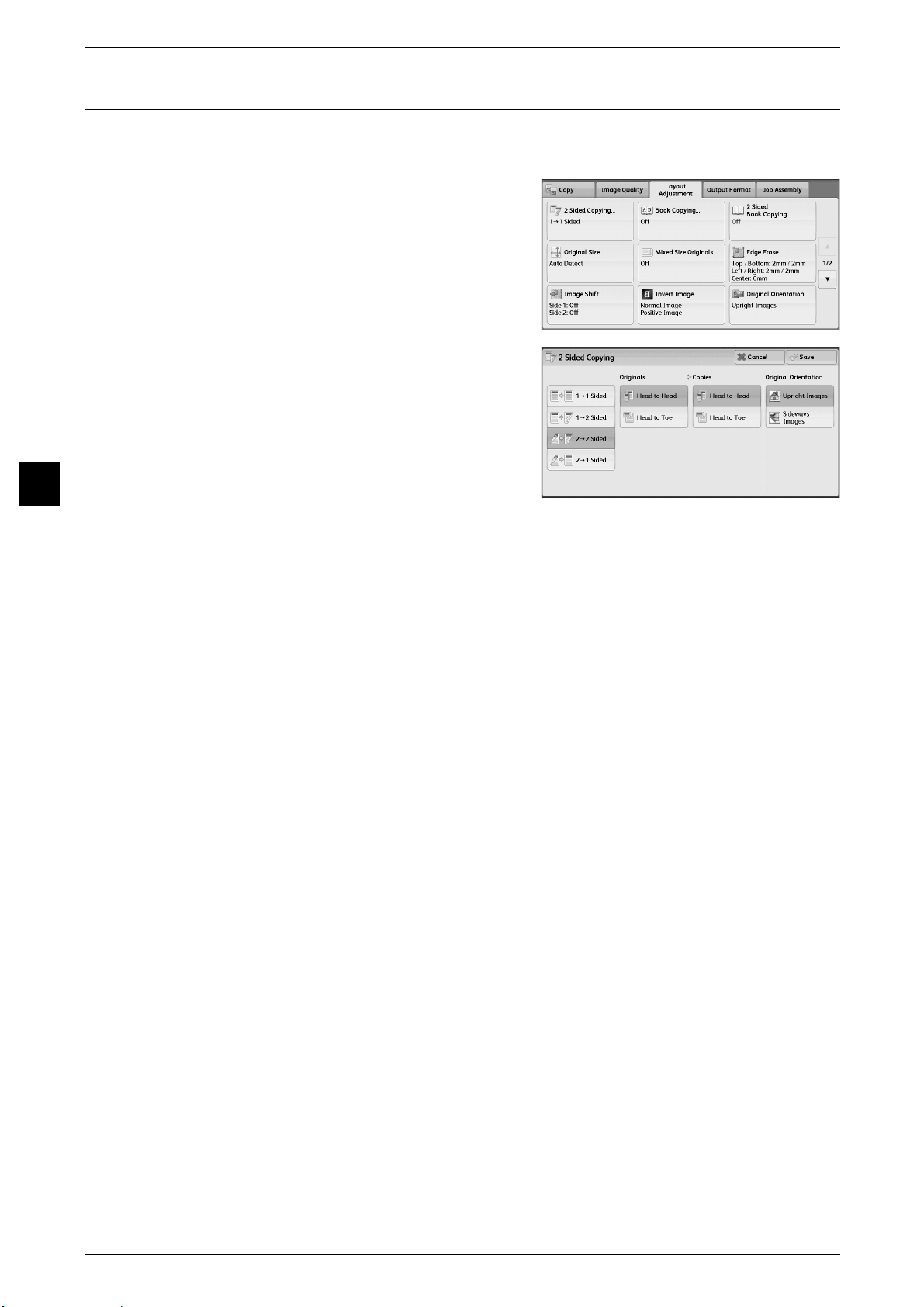
3 Copy
2 Sided Copying (Making 2 Sided Copies)
This feature allows you to make copies of 1-sided and 2-sided documents on one side
or both sides of paper.
1 Select [2 Sided Copying].
2 Select any option.
Copy
3
1 J 1 Sided
Makes a copy of a 1-sided document on one side of paper.
1 J 2 Sided
Makes a copy of a 1-sided document on both sides of paper.
Select this option when you copy 1-sided documents on both sides of paper.
2 J 2 Sided
Makes a copy of a 2-sided document on both sides of paper.
2 J 1 Sided
Makes a copy of a 2-sided document on one side of paper.
Originals
This option is displayed when you select [2 J 2 Sided] or [2 J 1 Sided].
z
Head to Head
Select this option when the front and back sides of the document are in the same
orientation.
z
Head to Toe
92
Select this option when the front and back sides of the document are in opposite
orientations.
Copies
This option is displayed when you select [1 J 2 Sided] or [2 J 2 Sided].
z
Head to Head
Select this option when you want the orientation of the front and back sides of the
copy to be the same as that of the document.
Page 93

Layout Adjustment
z
Head to Toe
Select this option when you want the orientation of the front and back sides of the
copy to be the opposite of that of the document.
Original Orientation
Allows you to specify the orientation of the document so that the machine can identify
the top of the document.
Note • If the [Original Orientation] setting differs from the actual document orientation, the machine
may not detect the top of the document correctly.
z
Upright Images
Select this option when placing the top edge of the document against the top side of
the document glass or document feeder.
z
Sideways Images
Select this option when placing the top edge of the document against the left side of
the document glass or document feeder. Always select [Sideways Images] when the
top of the document is placed facing the left side (horizontal text).
Book Copying (Copying Facing Pages onto Separate Sheets)
This feature allows you to copy facing pages of a document on separate sheets of
paper in page order.
This is useful when you need to make separate copies of facing pages of a bound
document such as a booklet.
Note • You cannot use the document feeder with this feature.
• A non-standard size document or undetectable-size document may not be separated into
two accurately.
1 Select [Book Copying].
Copy
3
2 Select any option.
Off
Does not copy as a bound document.
93
Page 94
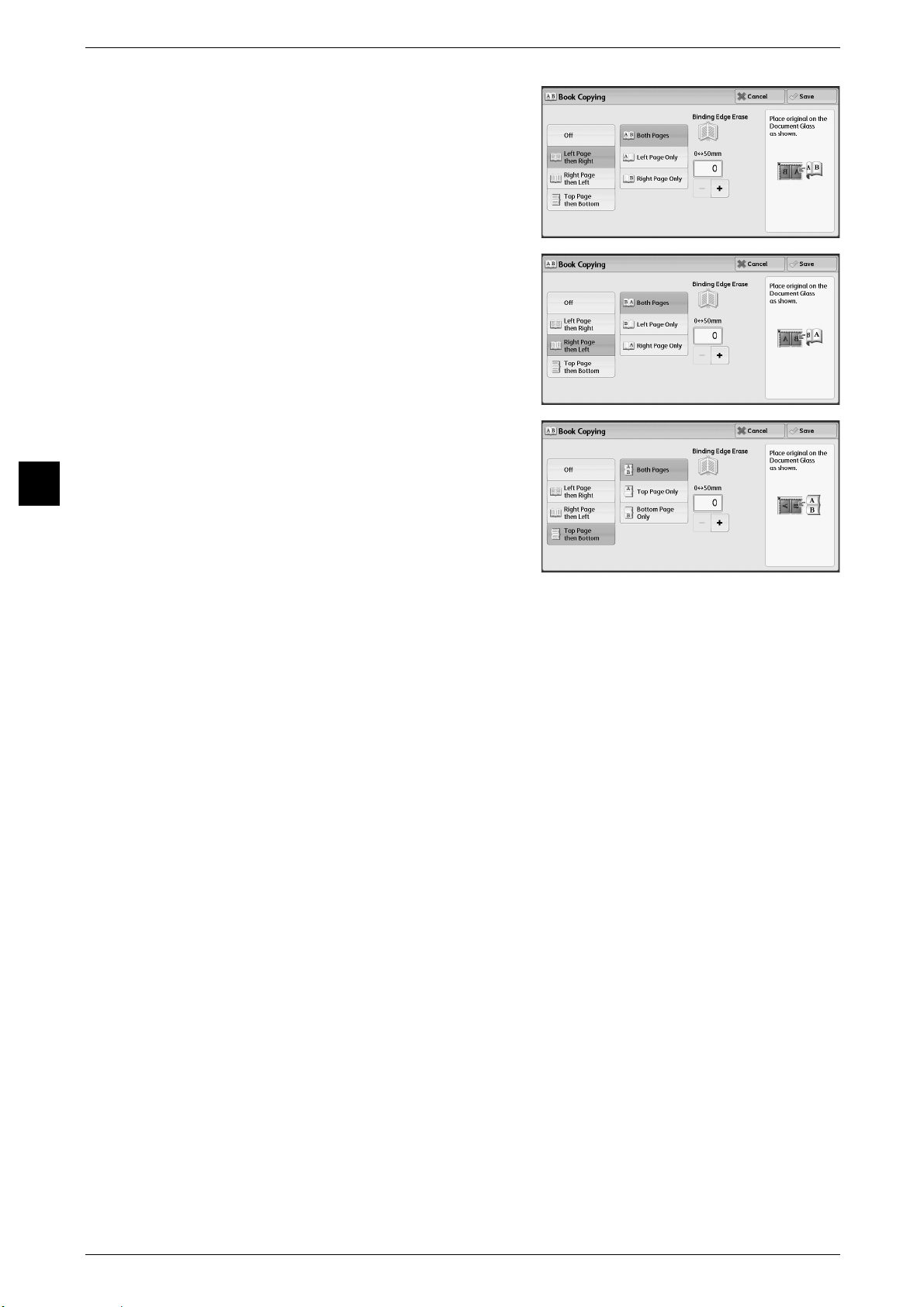
Copy
3
3 Copy
Left Page then Right
Copies the left page and then the right page
of facing pages.
Right Page then Left
Copies the right page and then the left page
of facing pages.
Top Page then Bottom
Copies the top page and then the bottom
page of facing pages.
Both Pages
Copies both pages in page order.
Left Page Only
Copies the left page only. You can select this option when [Left Page then Right] or
[Right Page then Left] is selected.
Right Page Only
Copies the right page only. You can select this option when [Left Page then Right] or
[Right Page then Left] is selected.
Top Page Only
Copies the top page only. You can select this option when [Top Page then Bottom] is
selected.
Bottom Page Only
Copies the bottom page only. You can select this option when [Top Page then Bottom]
is selected.
Binding Edge Erase
Erases the shadow from the center section of the document. You can set the binding
erase width in the range from 0 to 50 mm in 1 mm increments.
94
Page 95
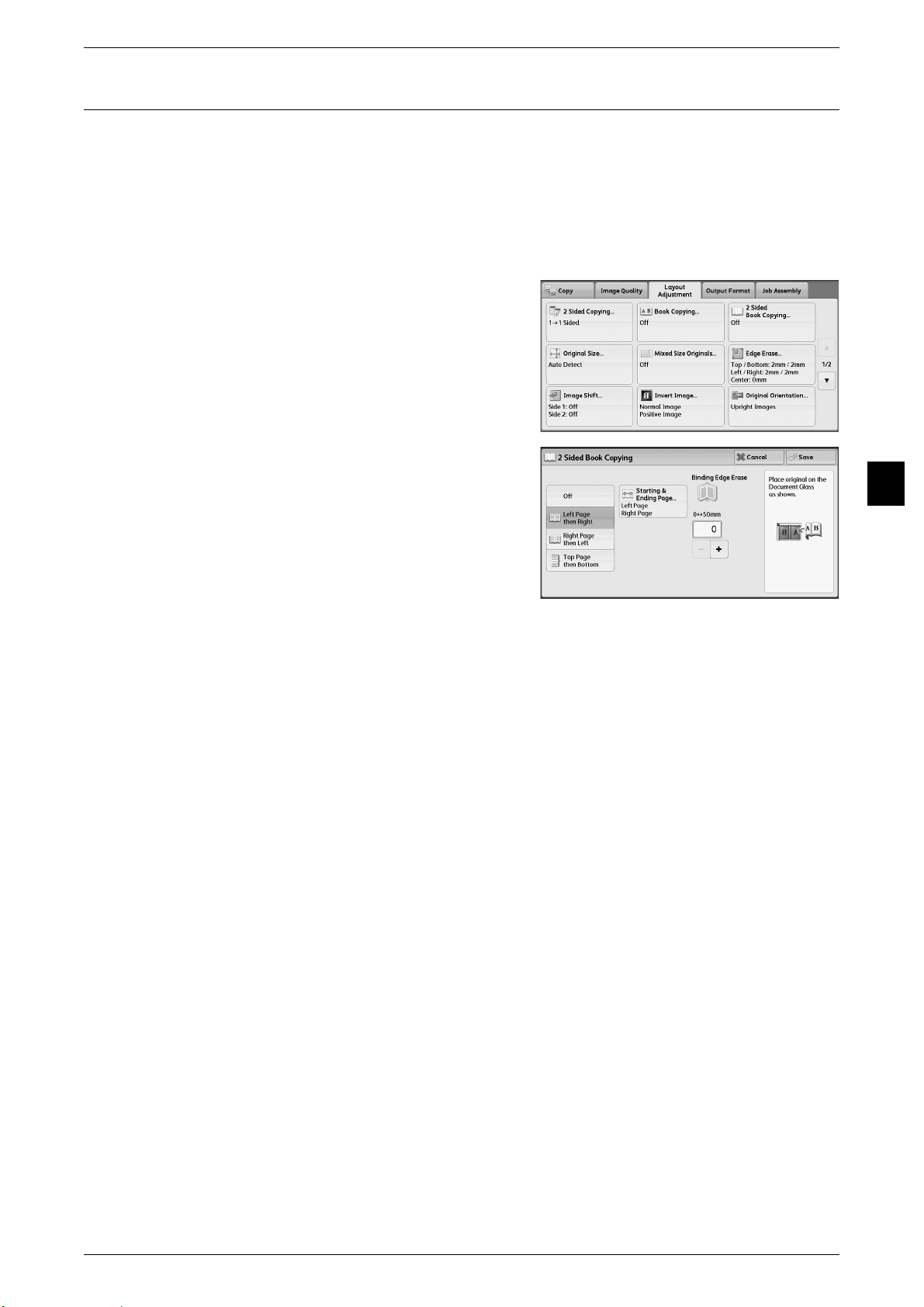
Layout Adjustment
2 Sided Book Copying (Making 2 Sided Copies of Facing Pages)
This feature allows you to assign pages when making copies of facing pages in a bound
document such as a booklet so that pages face each other in the same way as the
document. You can also specify the starting and ending pages from the left and right
of facing pages.
Note • A non-standard size document or undetectable-size document may not be separated into
two accurately.
• Use the document glass to load a document.
1 Select [2 Sided Book Copying].
2 Select any option.
Copy
Off
Disables this feature.
Left Page then Right
Scans the left page and then the right page of facing pages, to make 2-sided copies.
Right Page then Left
Scans the right page and then the left page of facing pages, to make 2-sided copies.
Top Page then Bottom
Scans the top page and then the bottom page of facing pages, to make 2-sided copies.
Starting & Ending Page
Displays the [Starting & Ending Page] screen.
Refer to "[Starting & Ending Page] Screen" (P.96).
3
Binding Edge Erase
Erases the shadow from the center section of the document. You can set the binding
erase width in the range from 0 to 50 mm in 1 mm increments.
95
Page 96
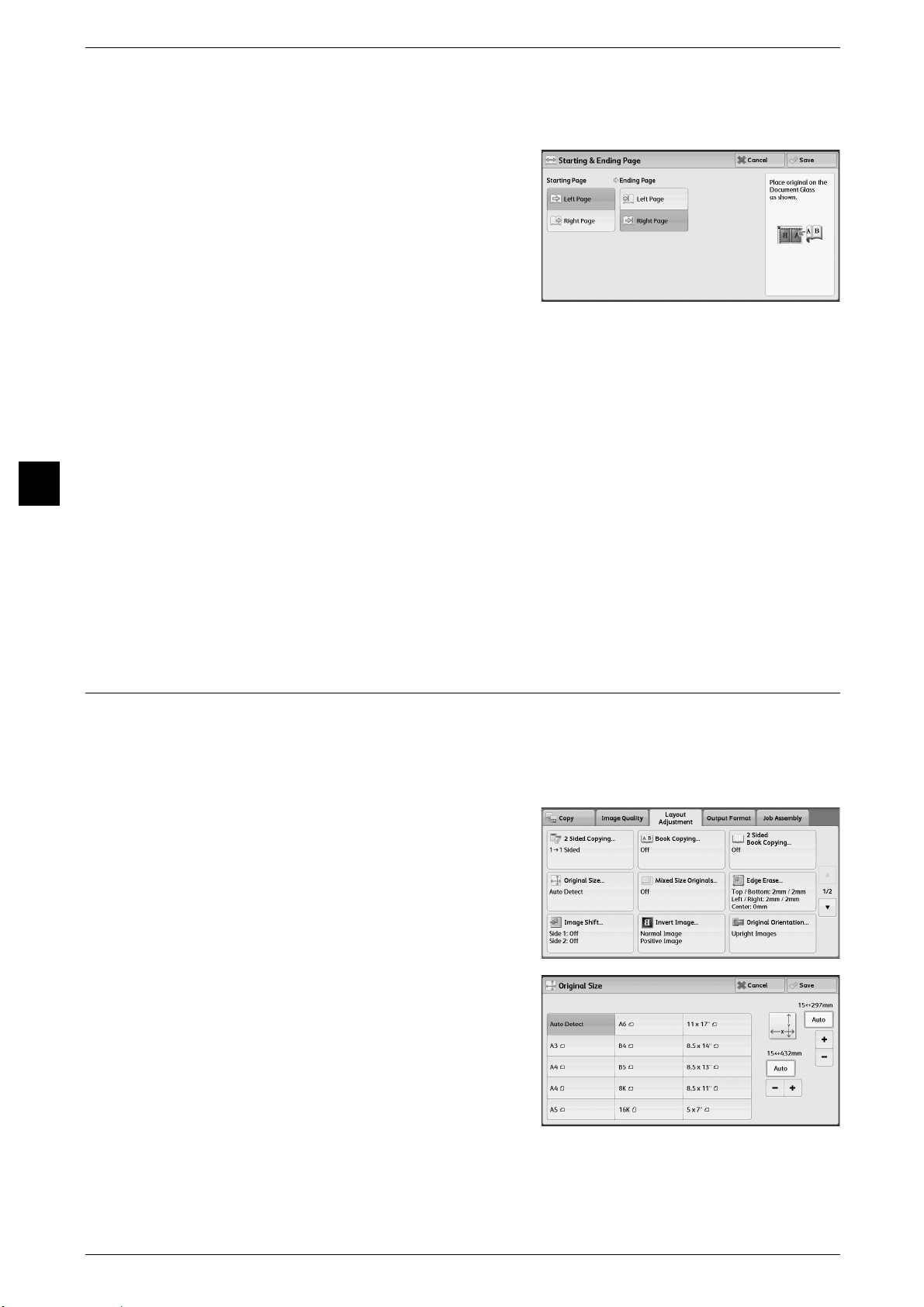
3 Copy
[Starting & Ending Page] Screen
This screen allows you to set the starting and ending pages to be copied.
1 Set [Starting Page] and [Ending Page].
Starting Page
z
[Left Page] / [Right Page]
You can select these options when [Left Page then Right] or [Right Page then Left]
is selected.
Copy
z
[Top Page] / [Bottom Page]
You can select these options when [Top Page then Bottom] is selected.
3
Ending Page
z
[Left Page] / [Right Page]
You can select these options when [Left Page then Right] or [Right Page then Left]
is selected.
z
[Top Page] / [Bottom Page]
You can select these options when [Top Page then Bottom] is selected.
Original Size (Specifying the Scan Size for the Document)
This feature allows you to specify the scan size for a document.
Use this feature when a document is a non-standard size, or when you want to copy a
document at a size different from the original size. You can also add margins, or delete
unnecessary margins using this feature.
1 Select [Original Size].
96
2 Select the size of the document.
If you select a non-standard size, specify
values for the X and Y directions.
Page 97

Layout Adjustment
Auto Detect
Detects the document size automatically. The following table shows the document
sizes that can be detected automatically.
Document Feeder Document Glass
B5, B5 , B4, A5, A5 , A4,
Auto-detectable
Document Sizes
Note • If the document size cannot be detected automatically, a screen to enter the document size
appears.
The document sizes that can be automatically detected depend on [Paper Size Settings] in the System
Administration mode. For more information, refer to "5 Tools" > "Common Service Settings" > "Other
Settings" > "Paper Size Settings" in the Administrator Guide.
A4 , A3, 8.5 x 11",
8.5 x 11"
8K
, 11 x 17", 16K ,
B6, B6 , B5, B5 , B4, A6,
A5, A5 , A4, A4 , A3
Standard Size
Select a document size from preset options.
You can change the sizes displayed on the screen. For information on the settings, refer to "5 Tools" >
"Copy Service Settings" > "Original Size Defaults" in the Administrator Guide.
Variable Size
Enter the desired scan size when scanning a non-standard size document or when
making copies at a size different from the original document size. You can specify a
value in the range from 15 to 432 mm for the width (X), and a value in the range from
15 to 297 mm for the length (Y), in 1 mm increments. To help you specify values, use
the scales attached on the upper and left edges of the document glass.
Important • When the document is loaded in the document feeder, the base point in the Y (length)
direction is the center of the edge. If you specify 100 mm, the scan length will be from 50 mm
above to 50 mm below the center of the document.
Copy
3
Mixed Size Originals (Scanning Different Size Documents Simultaneously)
You can scan documents of various sizes simultaneously and make copies on each
size or a single size of paper. To use this feature, load the documents in the document
feeder.
Important • Load documents in landscape orientation. However, always load A5 documents in portrait
orientation.
• When loading B5 documents together with A3 documents loaded in landscape orientation or
A4 documents loaded in portrait orientation, load B5 documents in portrait orientation.
• If the top left corners of the documents are not aligned properly, the documents may not be
scanned correctly.
• The recommended document size combinations are A4 portrait and A3 landscape, or B5
portrait and B4 landscape. If another combination of document sizes is used, the documents
can be fed at an angle and may not be copied properly.
Note • This feature does not appear for some models. An optional component is required. For more
information, contact your local Fuji Xerox representative.
97
Page 98
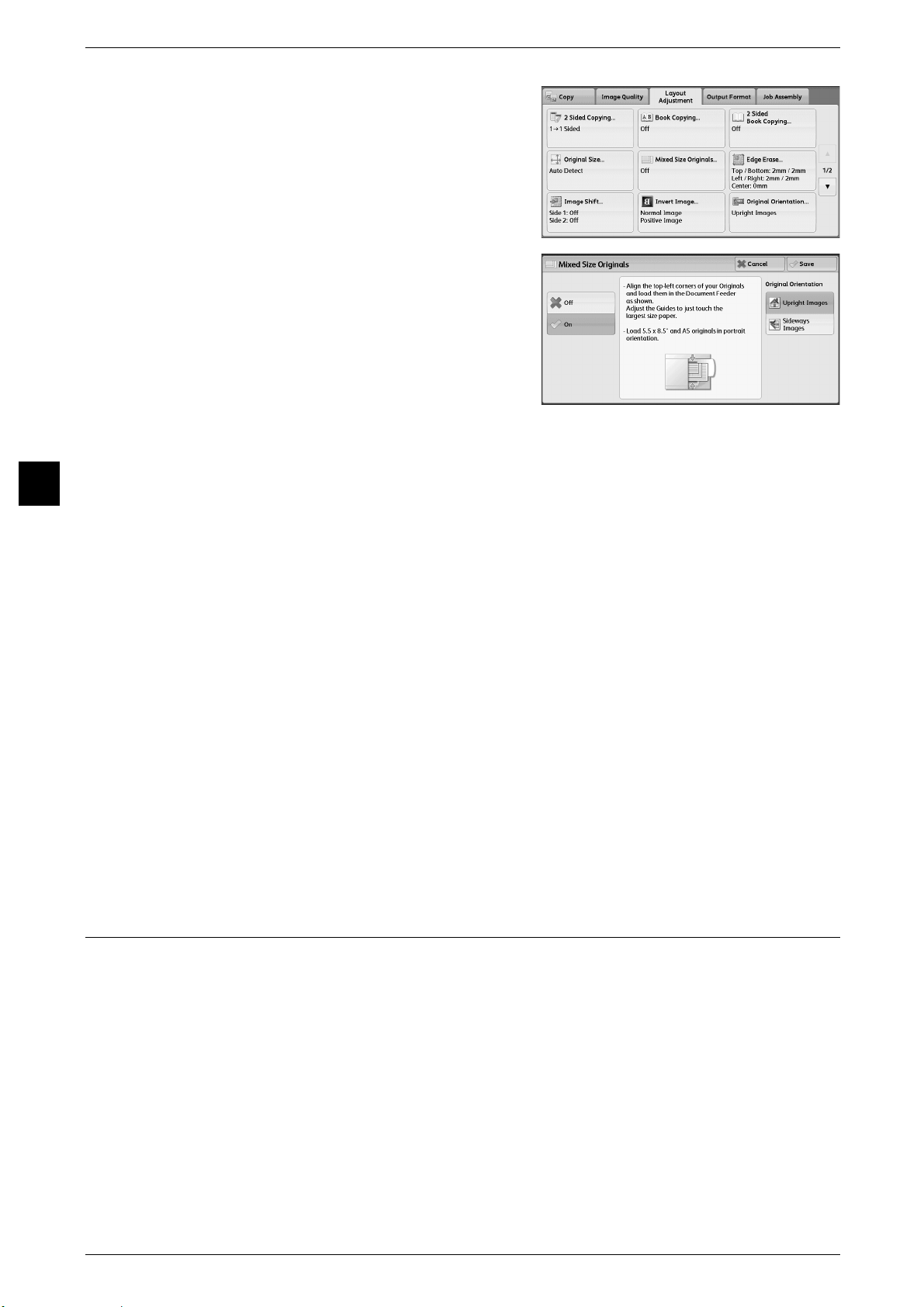
3 Copy
1 Select [Mixed Size Originals].
2 Select [On].
Copy
3
Off
Select this option when copying documents of the same size.
On
When documents of different sizes are copied, the machine automatically detects the
size of each document.
Original Orientation
Allows you to specify the orientation of the document so that the machine can identify
the top of the document.
Note • The [Original Orientation] setting is based on the orientation of the first page of a document.
Load the second and subsequent pages of the document based on this setting.
• If the [Original Orientation] setting differs from the actual document orientation, the machine
may not detect the top of the document correctly.
z
Upright Images
Select this option when placing the top edge of the document against the top side of
the document glass or document feeder.
z
Sideways Images
Select this option when placing the top edge of the document against the left side of
the document glass or document feeder. Always select [Sideways Images] when the
top of the document is placed facing the left side (horizontal text).
Edge Erase (Erasing Edges and Margin Shadows of the Document)
When you copy a document with the document cover open or when you copy a book,
the edges and center margin of the document may be printed as black shadows. The
Edge Erase feature allows you to erase such shadows.
Note • For 2-sided originals, the same edge erase amounts are set for the front and back sides.
• If you set [Reduce/Enlarge], the edge erase amounts will be reduced or enlarged in
proportion to the ratio you specified.
• The binding shift specified in [Booklet Creation] will not affect the edge erase amounts.
• If you use the document glass to make 2-sided copies of 1-sided originals ([1 J 2 Sided] of
[2 Sided Copying]), even if you select [Mirror Side 1] for [2 Sided Original - Side 2] after
selecting [Individual Edges] of [Edge Erase], the [Mirror Side 1] setting will be invalid. In such
cases, select [2 J 2 Sided] of [2 Sided Copying].
• Even when the edge erase amount is set to 0 mm, full page copying cannot be made.
98
Page 99

Layout Adjustment
1 Select [Edge Erase].
2 Select any option.
Normal
The edge width to erase is set to 2 mm for the top and bottom, and left and right edges.
Copy
All Edges
Erases the shadows of the four edges of a document, as well as the shadow in the
center of the document if it is a bound document or a booklet. You can specify values
for [All Edges] and [Center] individually.
Individual Edges
Erases the shadows of the top, bottom, left, and right edges of a document, as well as
the shadow in the center of the document if it is a bound document or a booklet. You
can specify values for [Top], [Bottom], [Left], [Right], and [Center] individually.
Parallel Edges
Erases the shadows of the top and bottom edges, and left and right edges of a
document, as well as the shadow in the center of the document if it is a bound
document or a booklet. You can specify values for [Top & Bottom], [Left & Right], and
[Center] individually.
Erase Value
Allows you to specify values to erase the edges of a document.
z
All Edges
Erases the shadows of the four edges of the document according to the orientation
of the loaded document. You can specify the edge width you want to erase in the
range from 0 to 50 mm in 1 mm increments.
z
Top & Bottom (Top/Bottom)
3
Erases the shadows of top and bottom edges of the document according to the
orientation of the loaded document. You can specify the edge width you want to
erase in the range from 0 to 50 mm in 1 mm increments.
z
Left & Right (Left/Right)
Erases the shadows of left and right edges of the document according to the
orientation of the loaded document. You can specify the edge width you want to
erase in the range from 0 to 50 mm in 1 mm increments.
99
Page 100
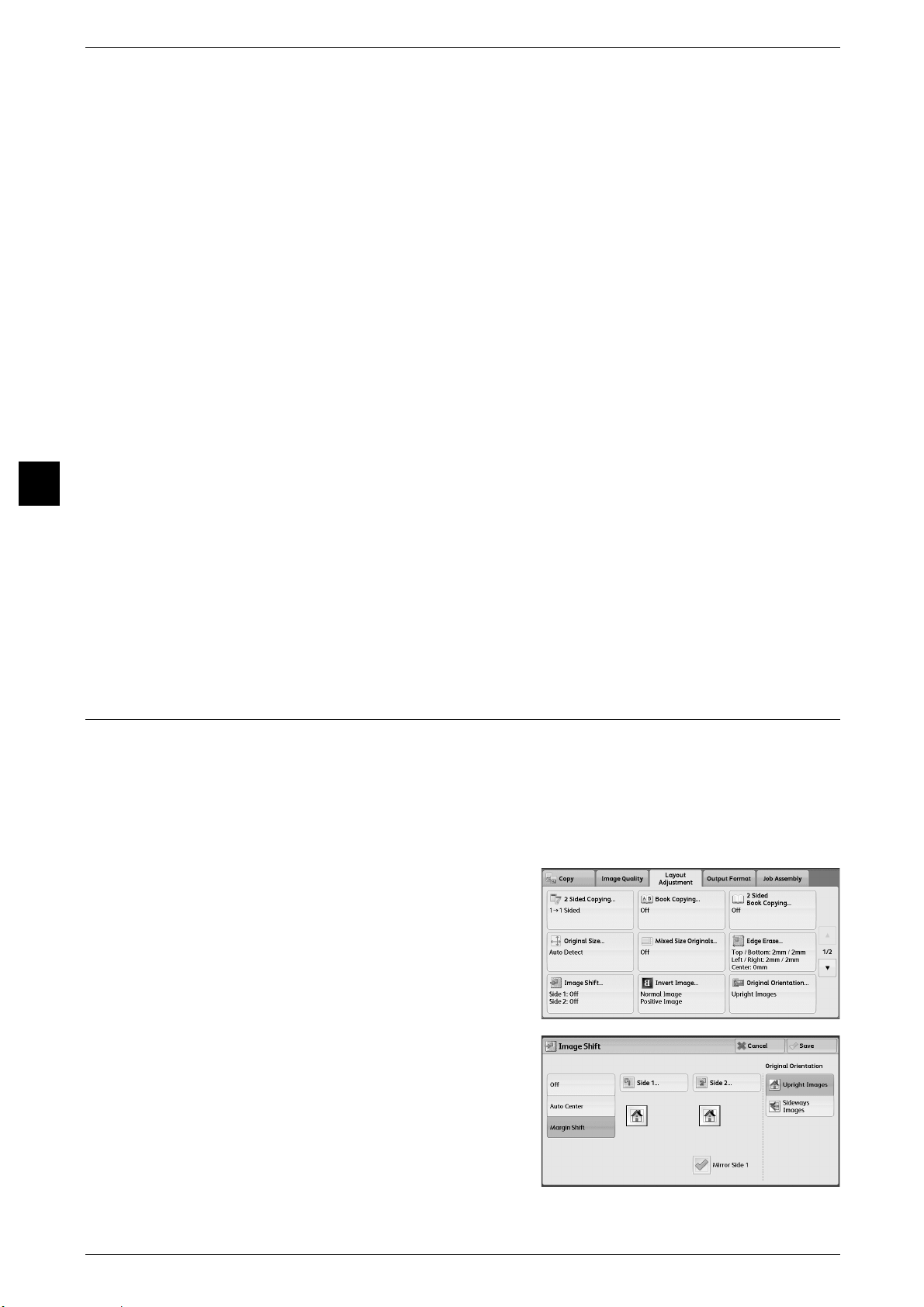
3 Copy
z
Center
Erases the shadow in the center of facing pages of a bound document or a booklet.
You can set the binding erase width in the range from 0 to 50 mm in 1mm increments.
Original Orientation
Allows you to specify the orientation of the document so that the machine can identify
the top of the document.
Note • If the [Original Orientation] setting differs from the actual document orientation, the machine
may not detect the top of the document correctly.
z
Upright Images
Select this option when placing the top edge of the document against the top side of
the document glass or document feeder.
z
Sideways Images
Copy
Select this option when placing the top edge of the document against the left side of
the document glass or document feeder. Always select [Sideways Images] when the
top of the document is placed facing the left side (horizontal text).
3
2 Sided Original - Side 2
You can select this option when [Individual Edges] is selected. Set whether the same
value is set to the edge erase amount of Side 1 and Side 2.
z
Same as Side 1
The same value is set to the edge erase amount of Side 1 and Side 2.
z
Mirror Side 1
The edge erase amounts of Side 1 and Side 2 are set symmetrically.
Image Shift (Adjusting the Image Position)
This feature allows you to shift the position of document images so that the images are
placed on the left, right, top, bottom, or center of paper. You can also adjust the
amounts of the left, right, top, and bottom margins. If you make 2-sided copies, you can
adjust the image positions for Side 1 and Side 2 individually.
Note • The image shift amount is set in accordance with the paper, and does not affect the setting
made in [Reduce/Enlarge].
100
1 Select [Image Shift].
2 Select any option.
